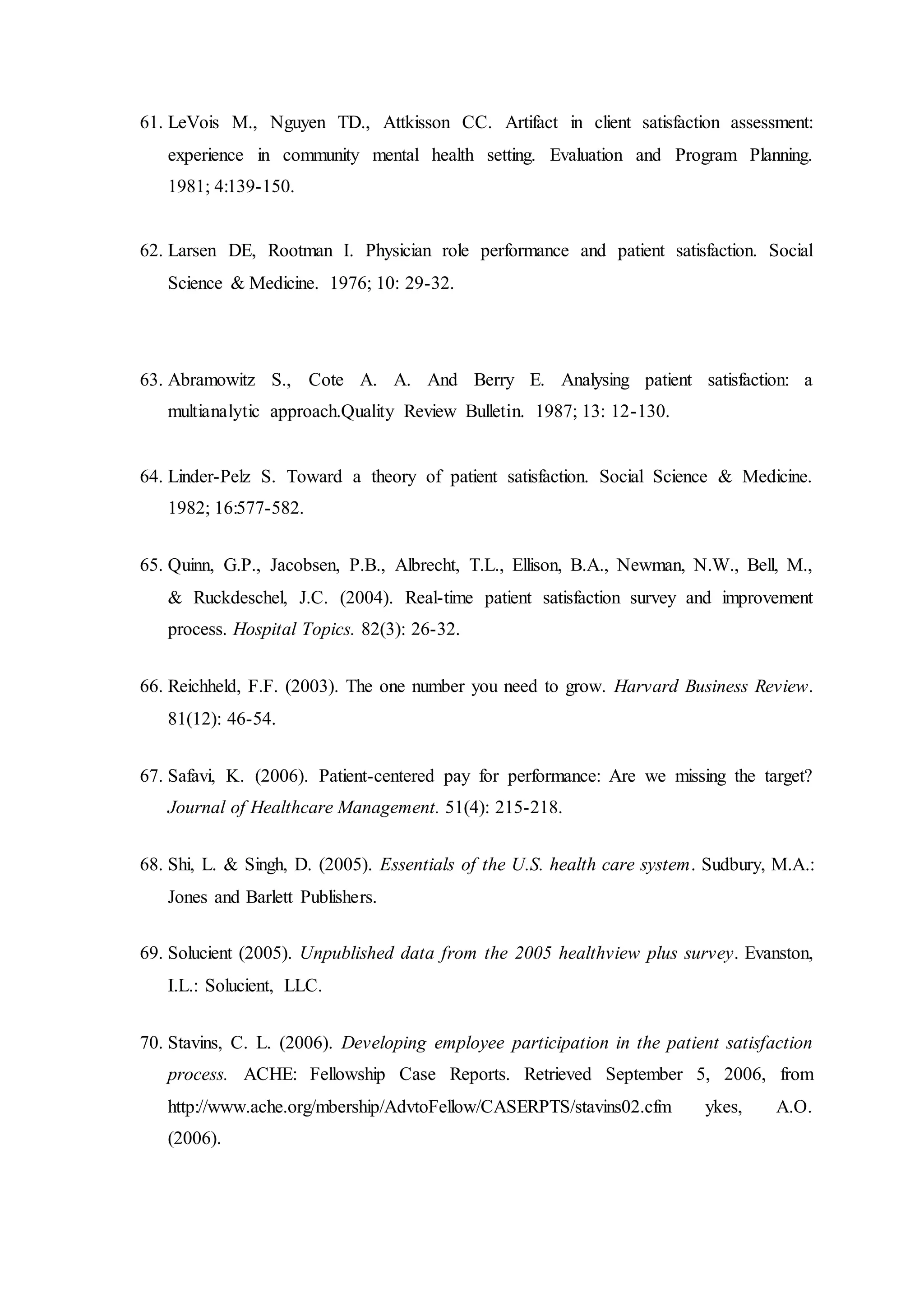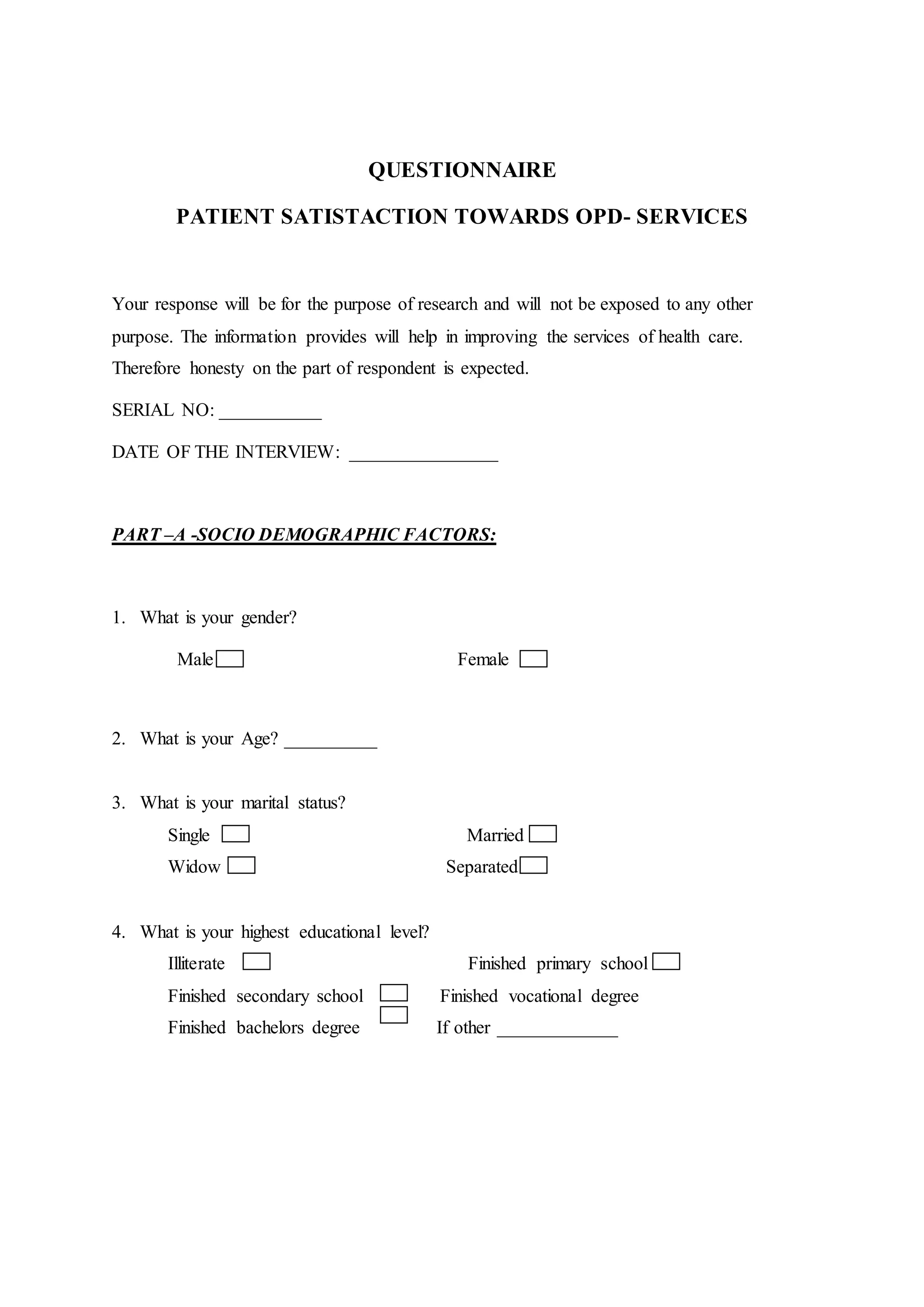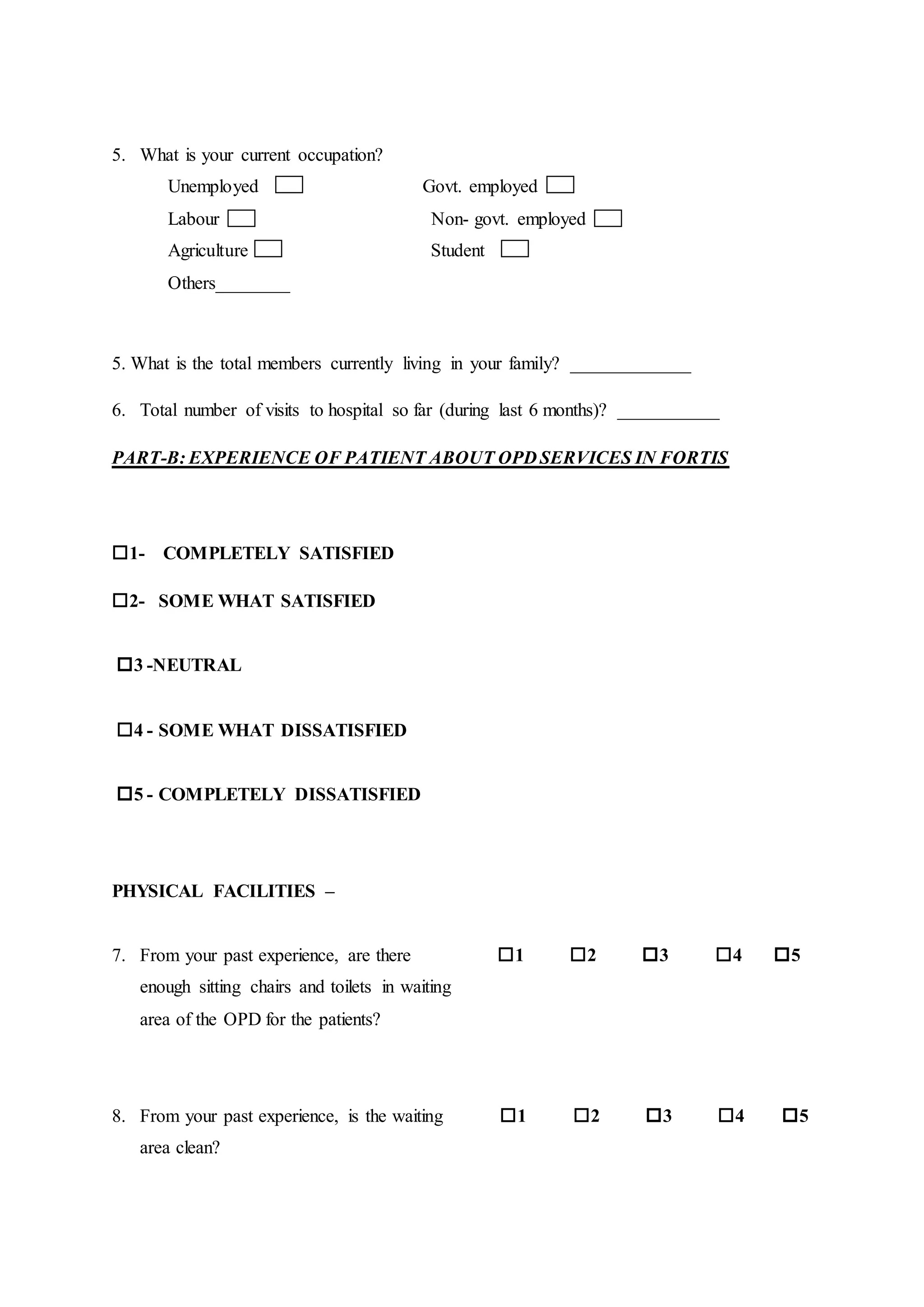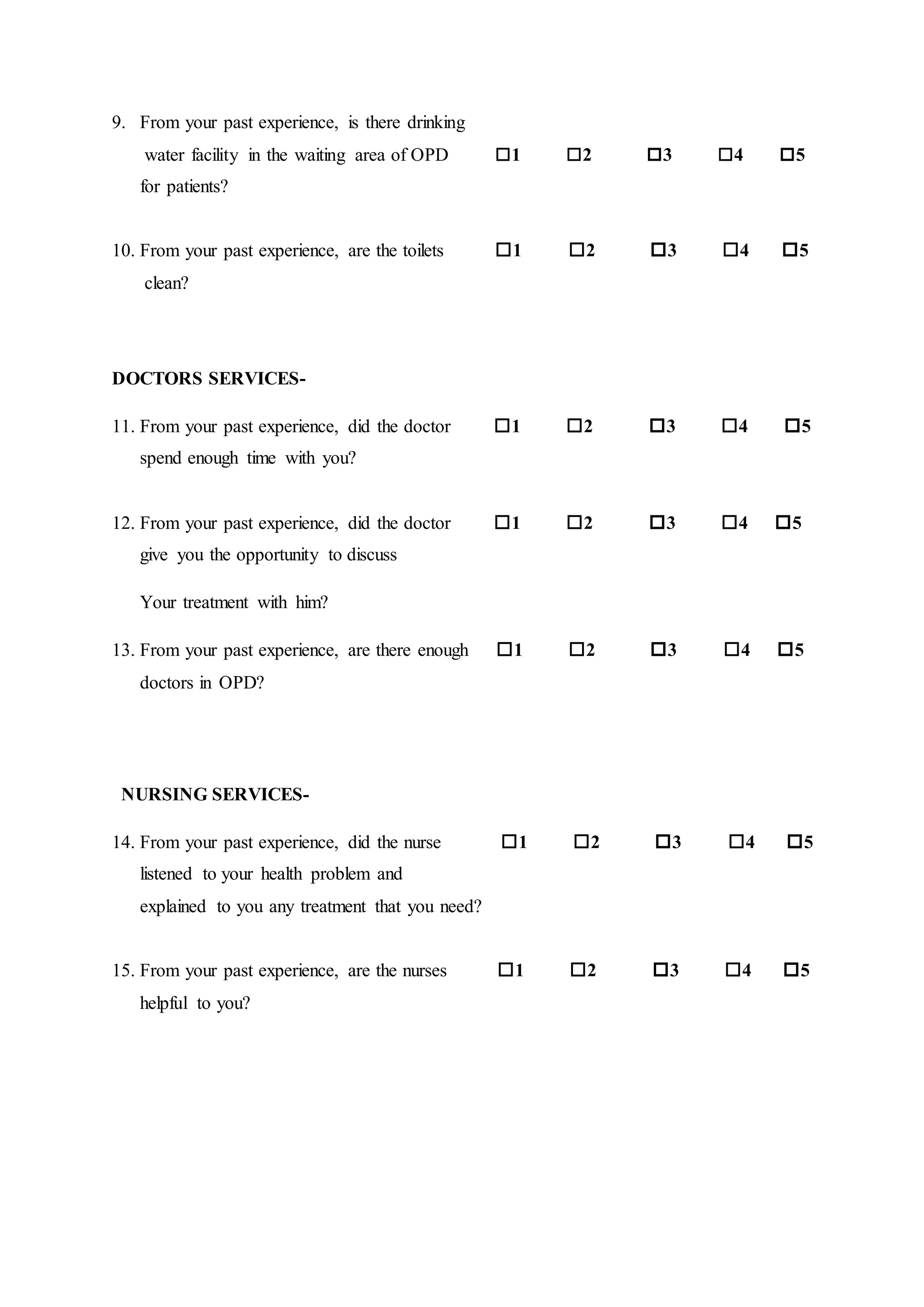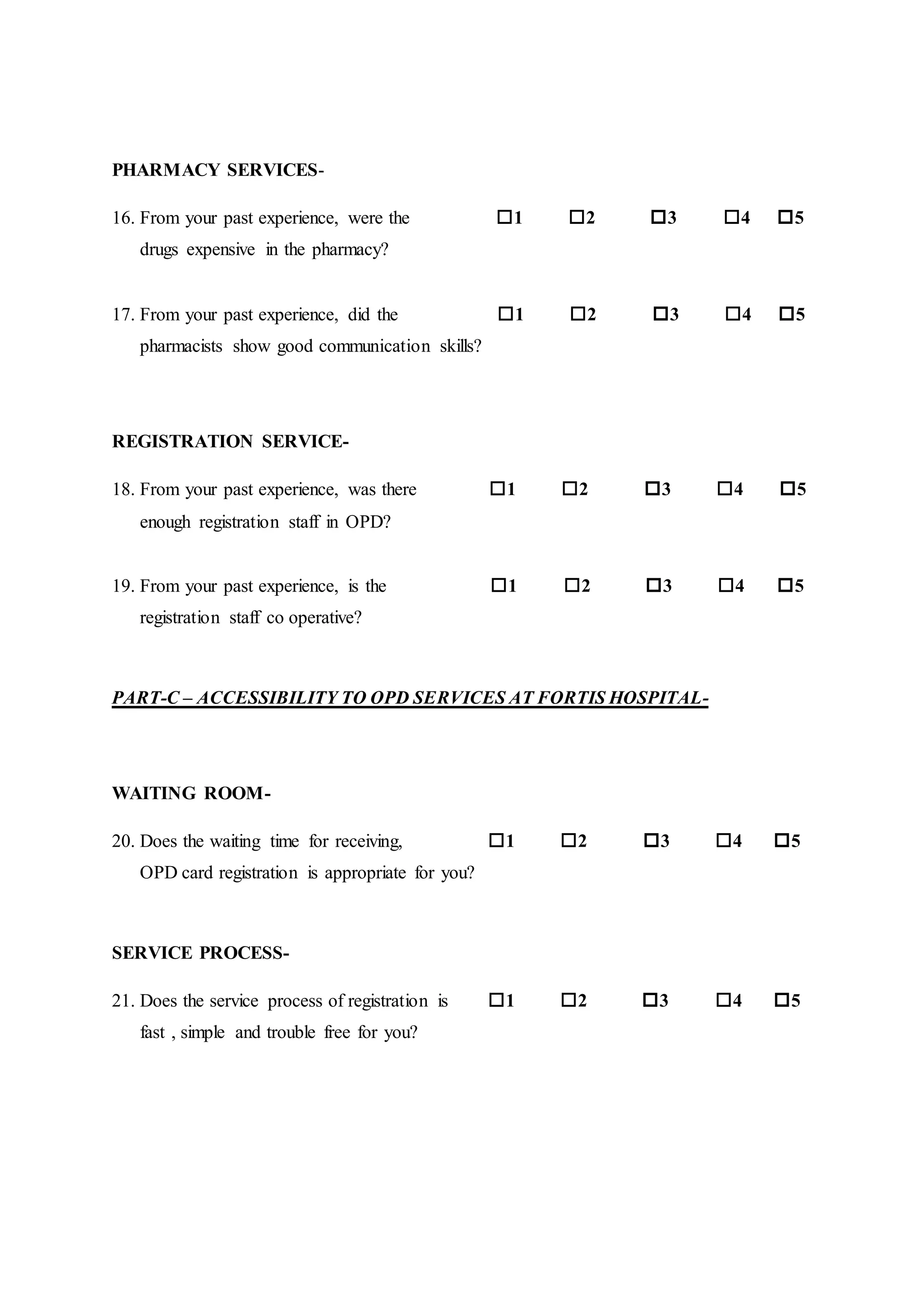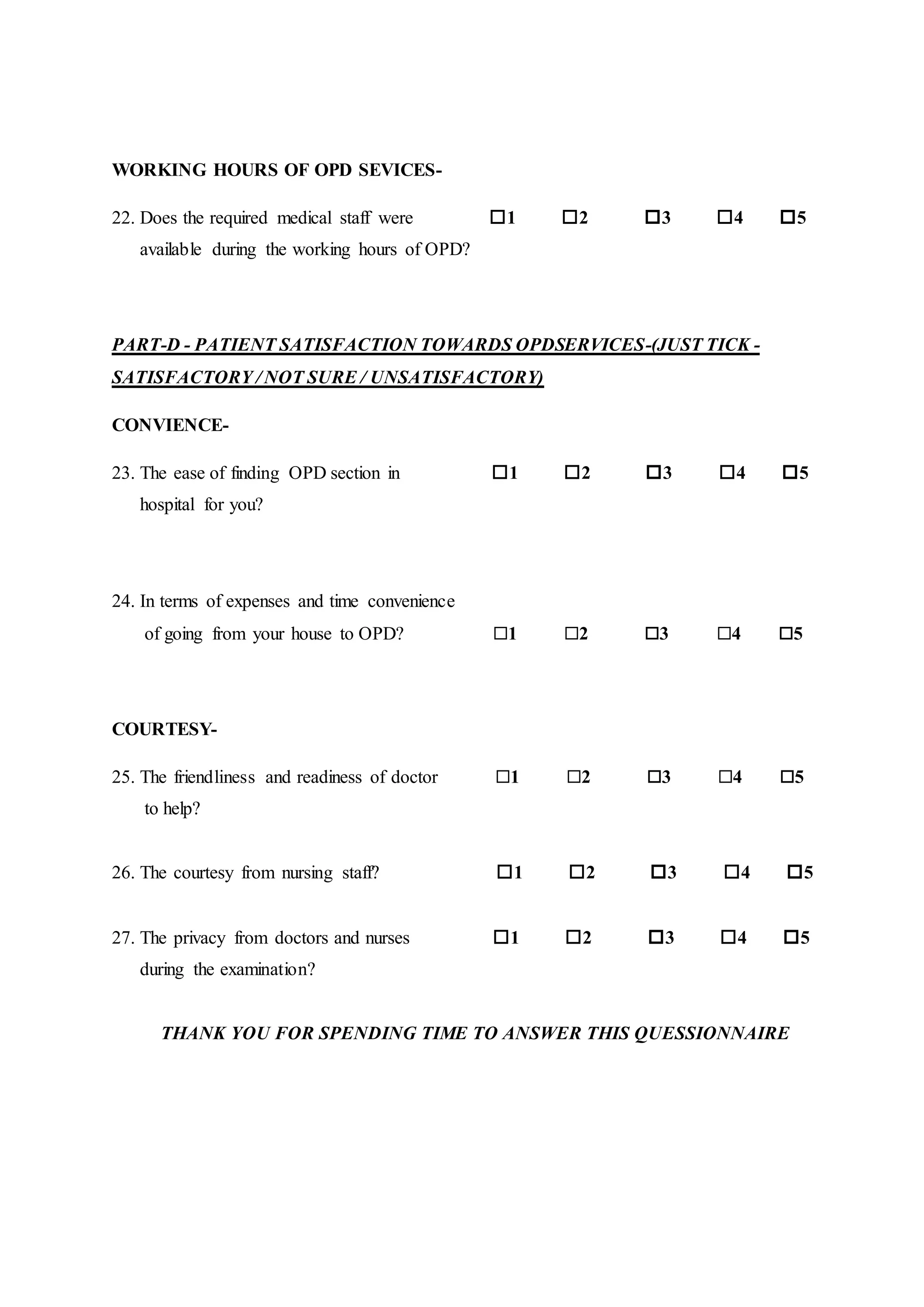The document provides an overview of Fortis Escorts Hospital in Amritsar, India. It describes the hospital as a 154 bed multi-specialty facility with specialties in cardiology. The hospital aims to provide compassionate and clinically excellent patient care. It offers a range of diagnostic, treatment and specialty services including cardiology, gastroenterology, nephrology and endocrinology services. The document serves to introduce the organization where the study on patient satisfaction with OPD services will be conducted.
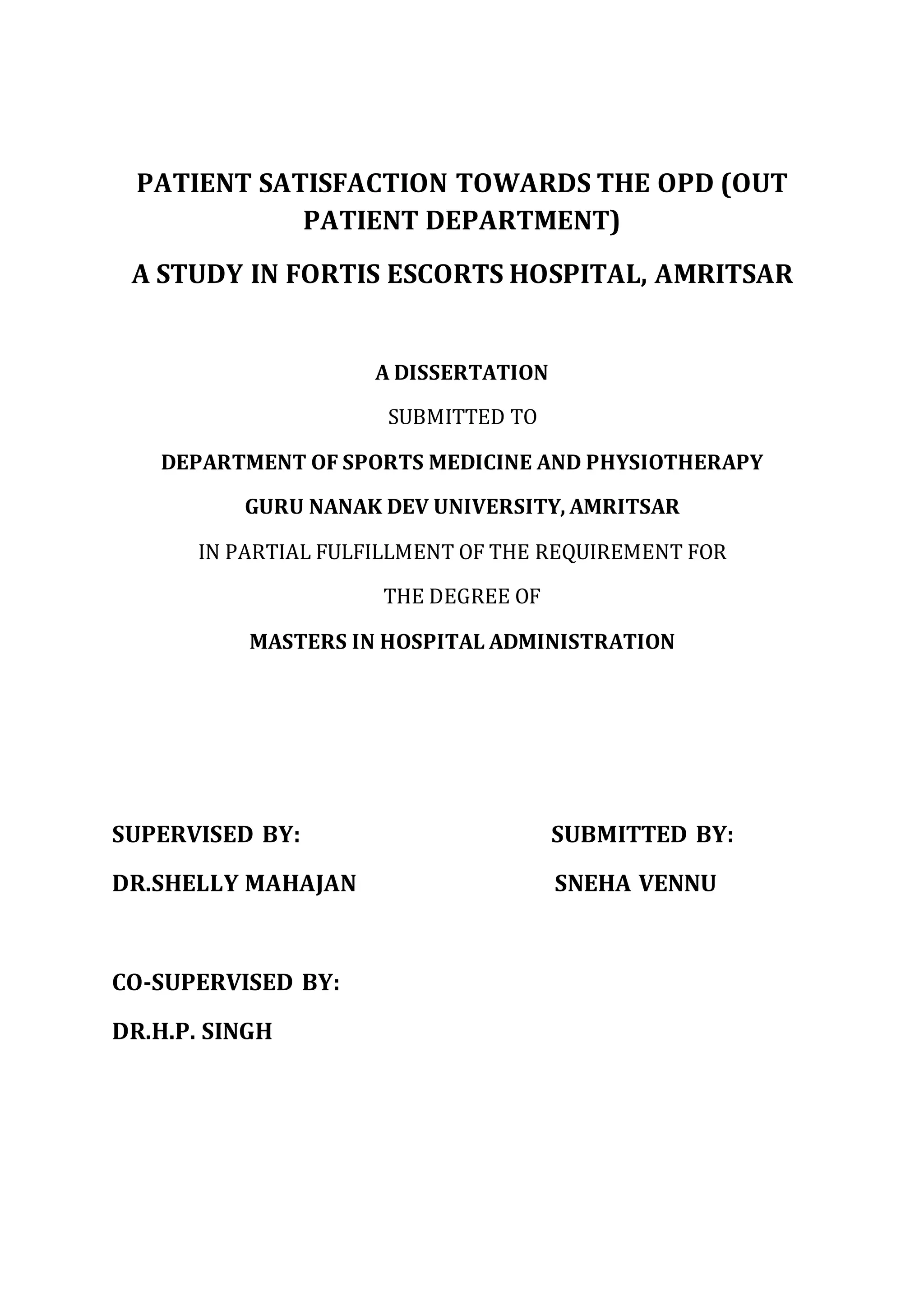
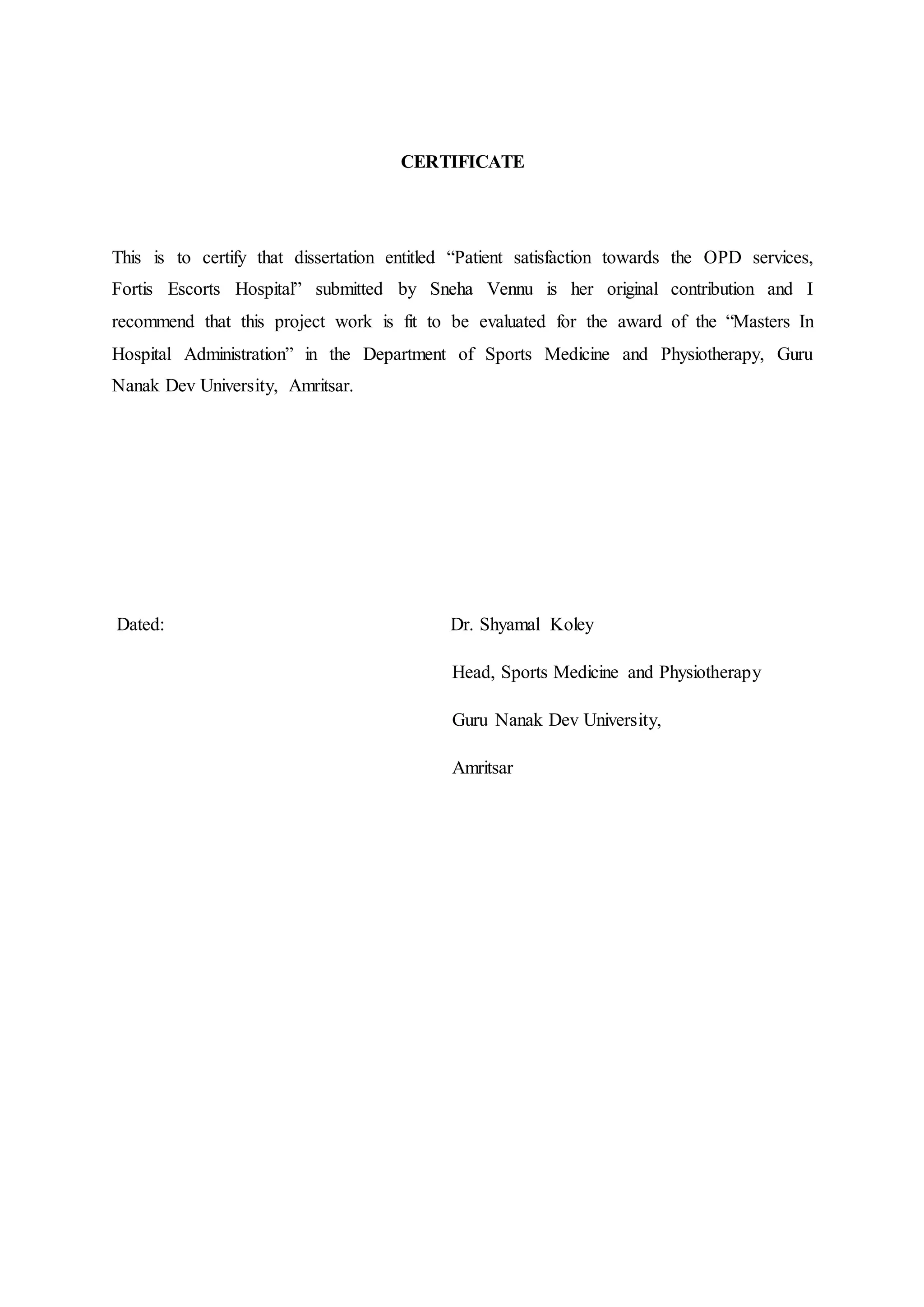
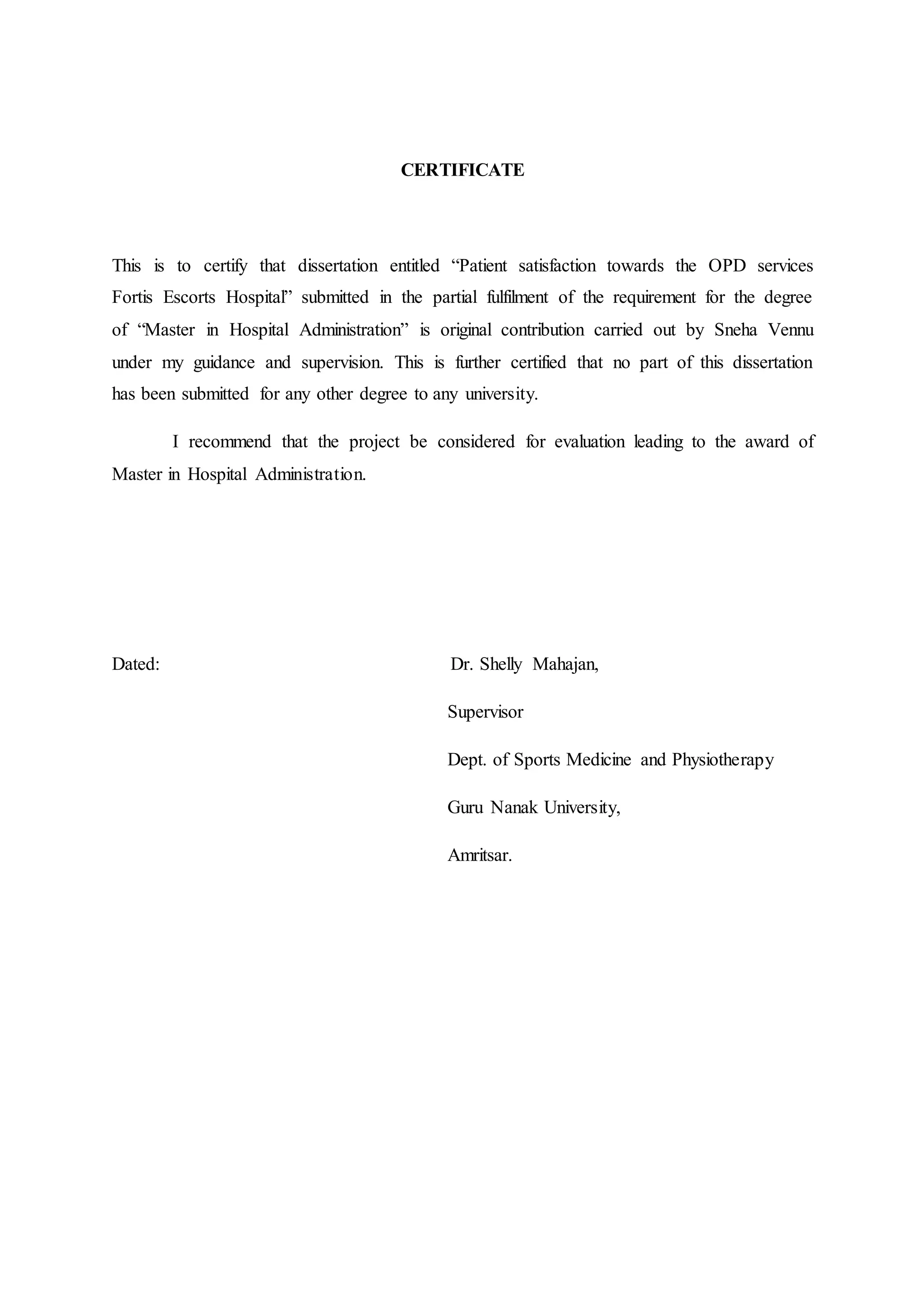

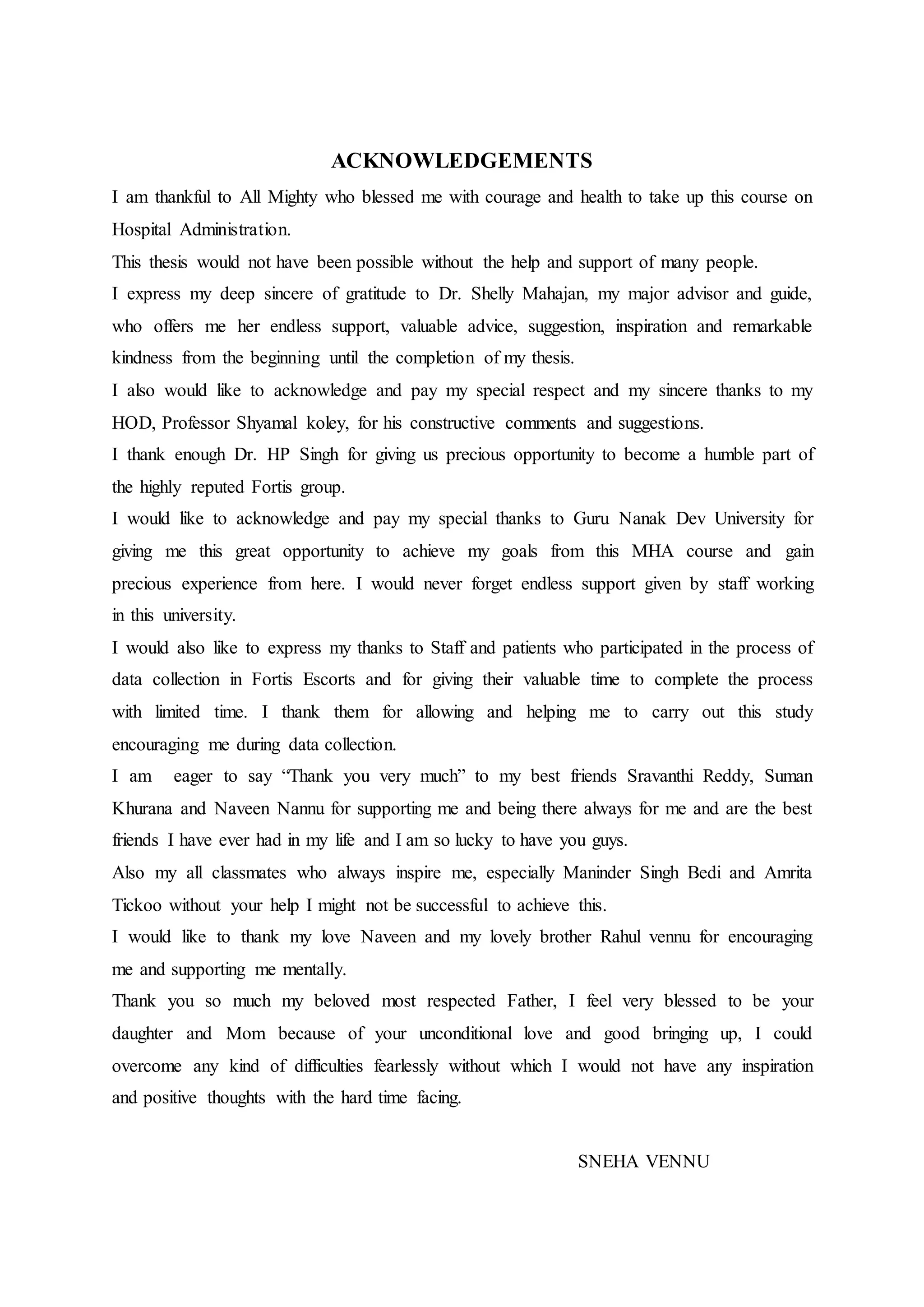
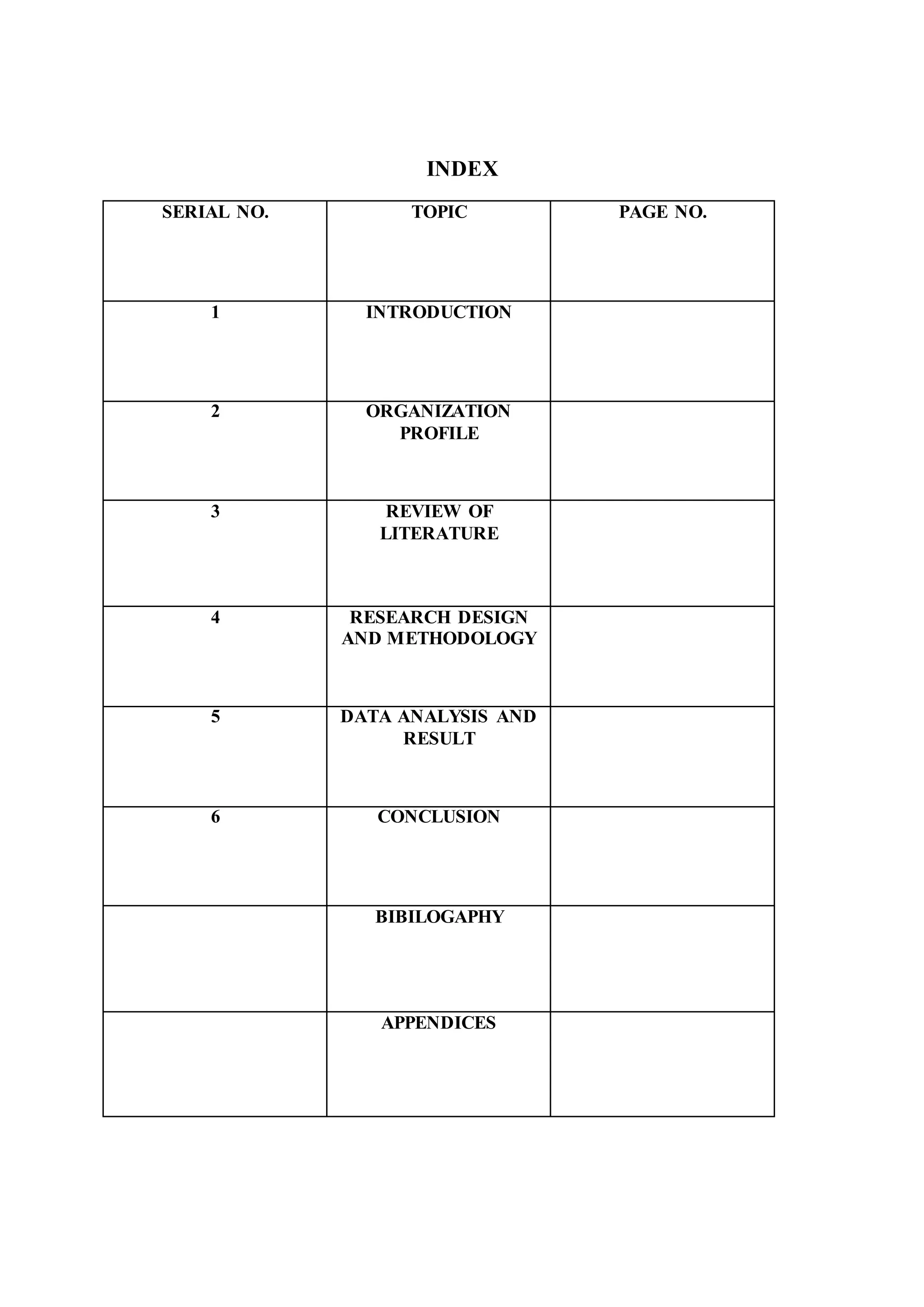
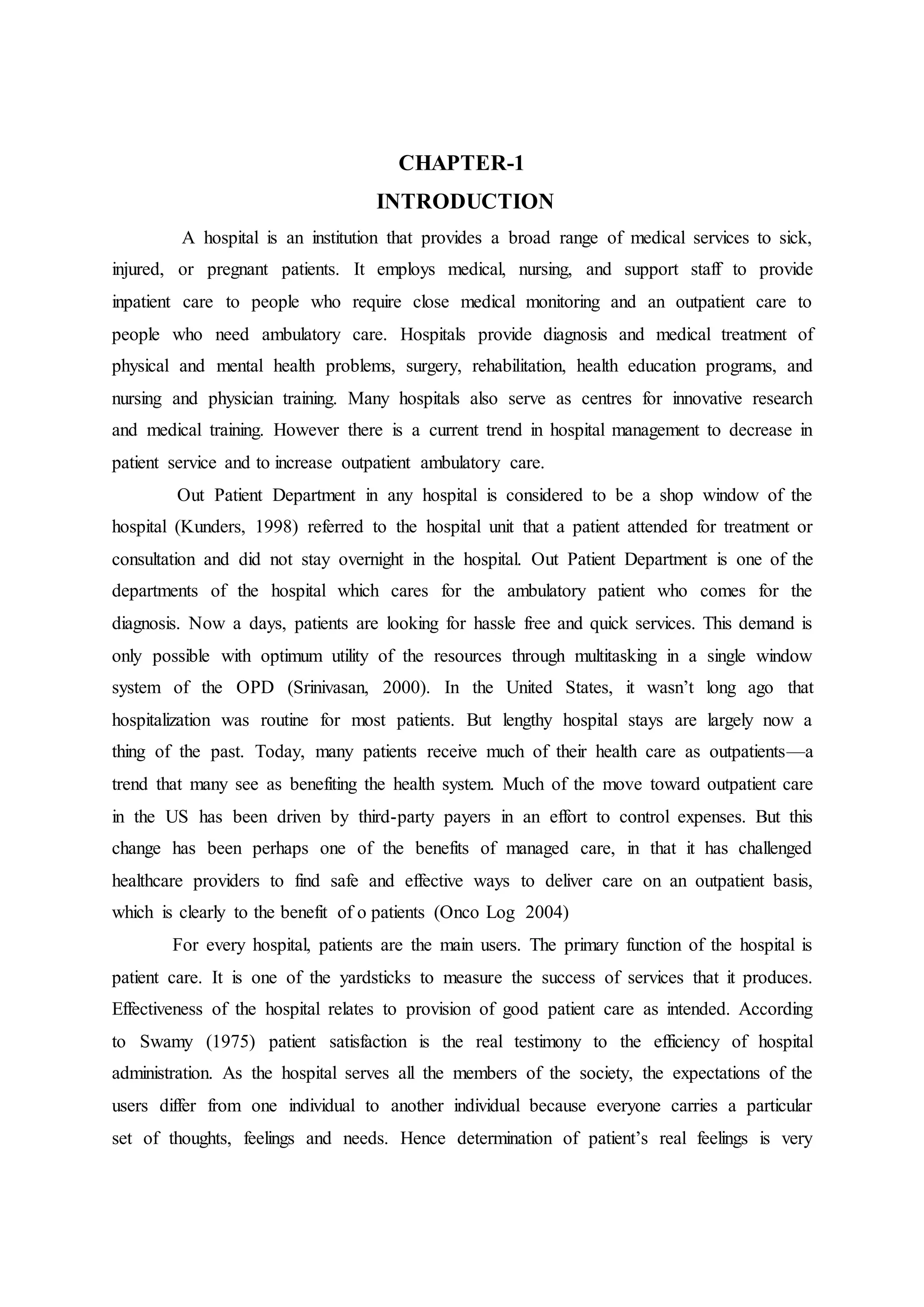
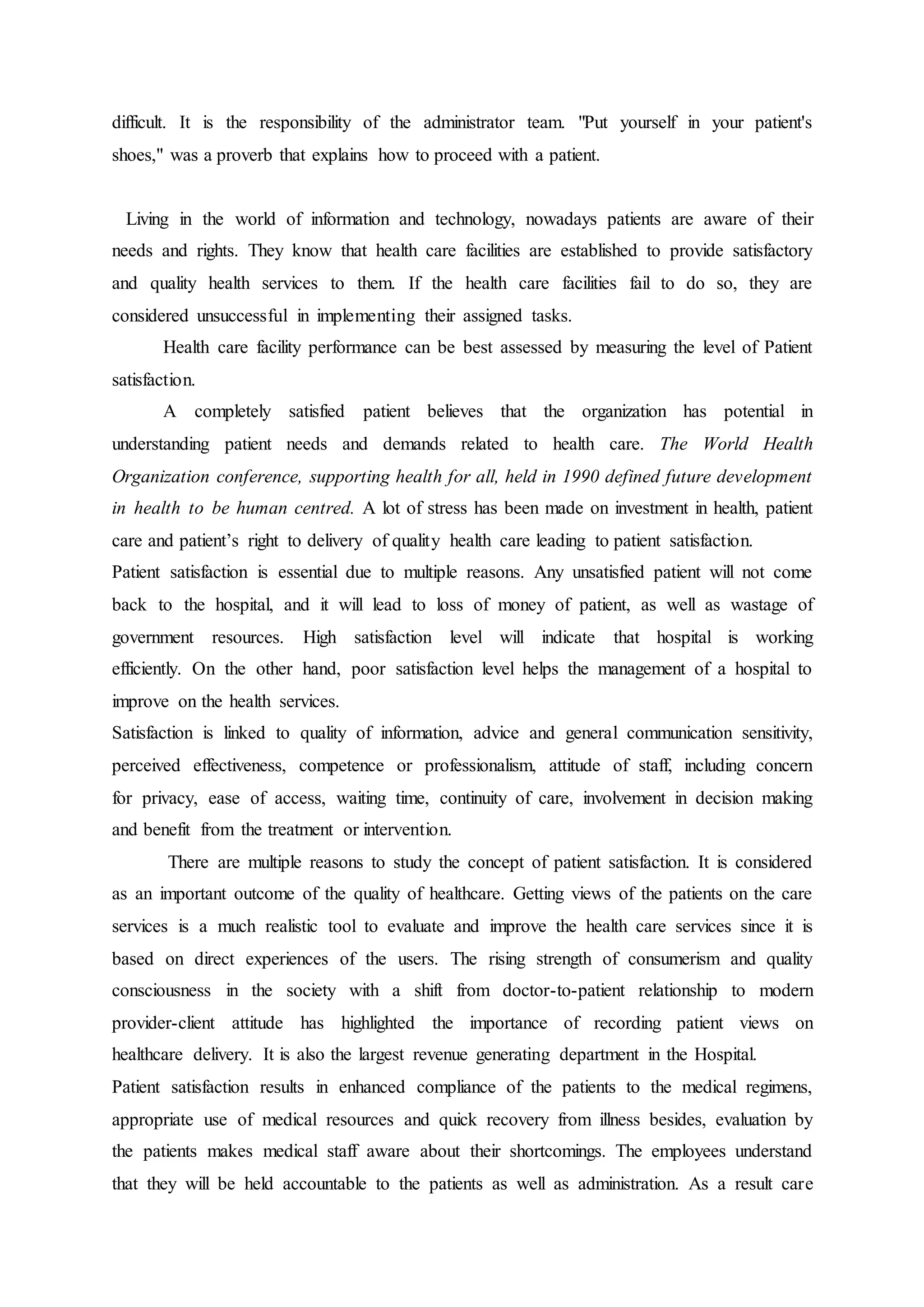
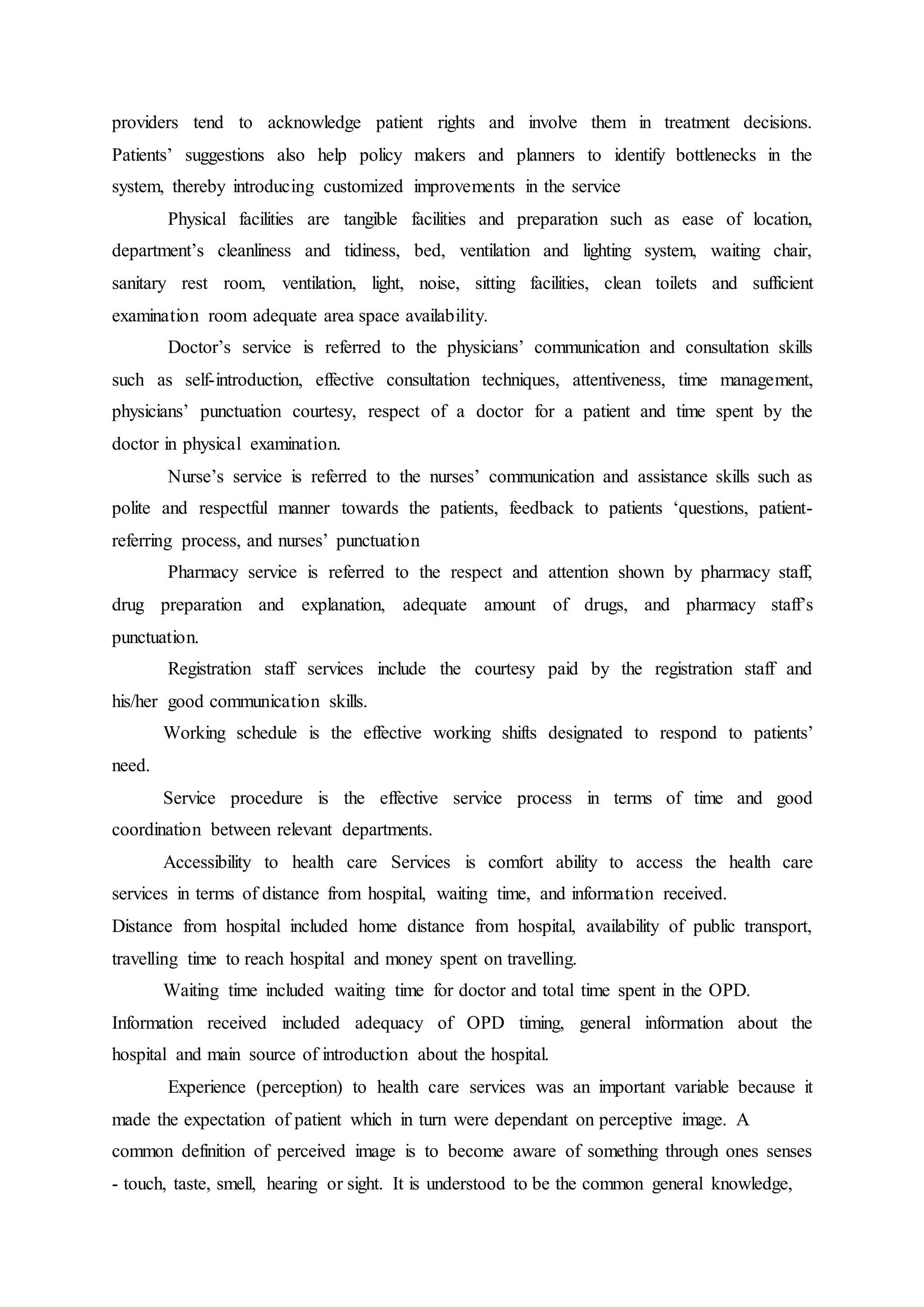
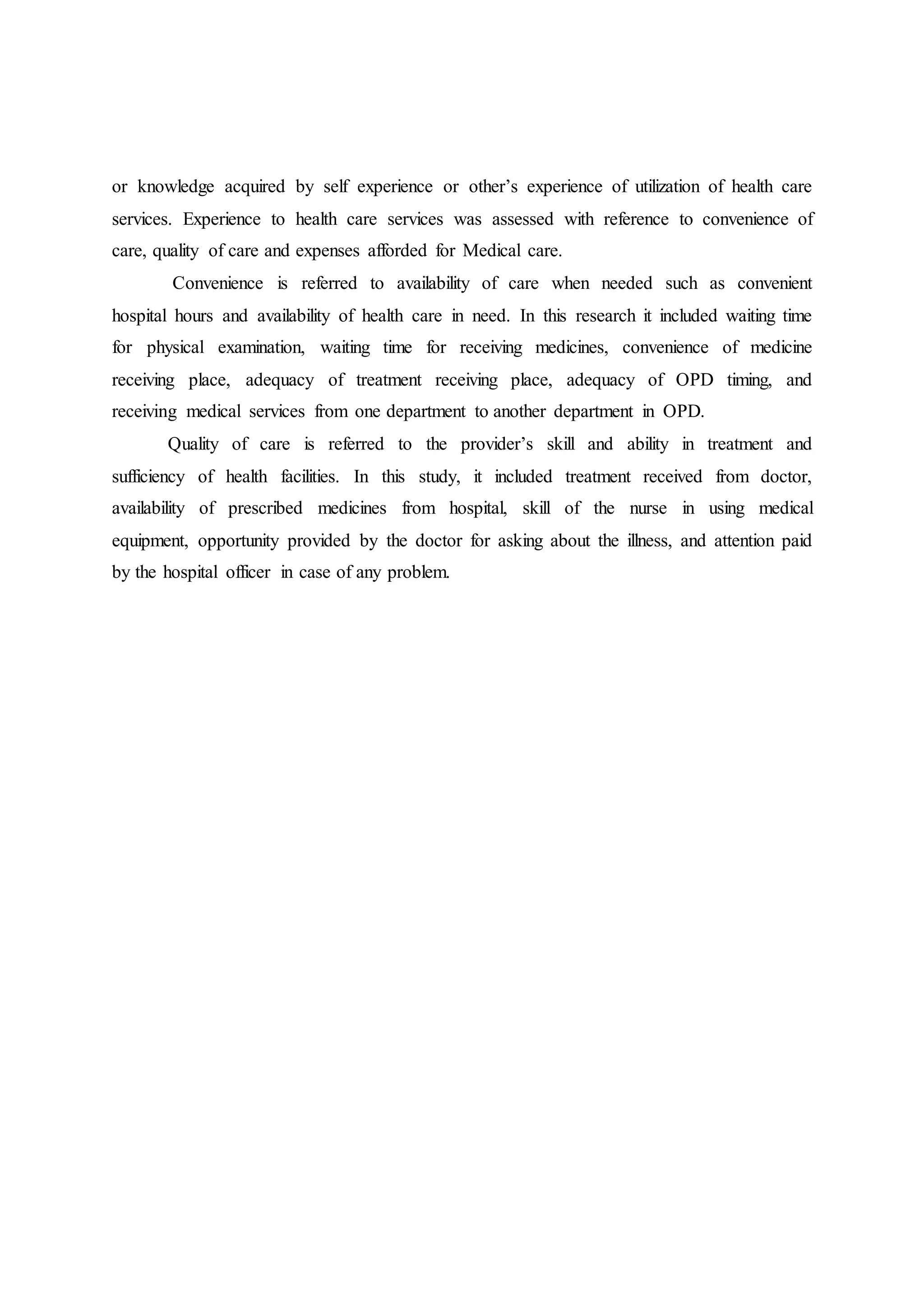


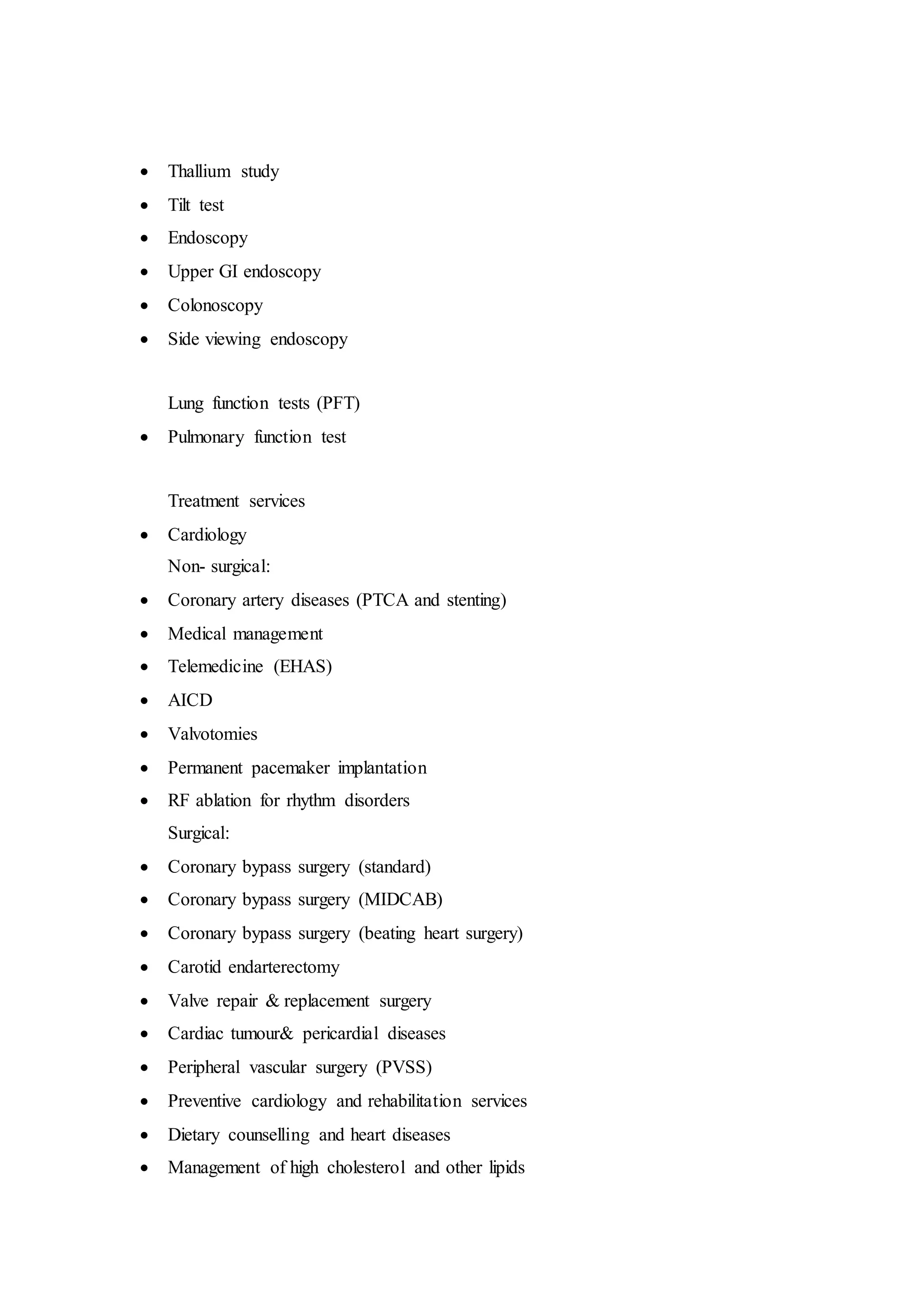

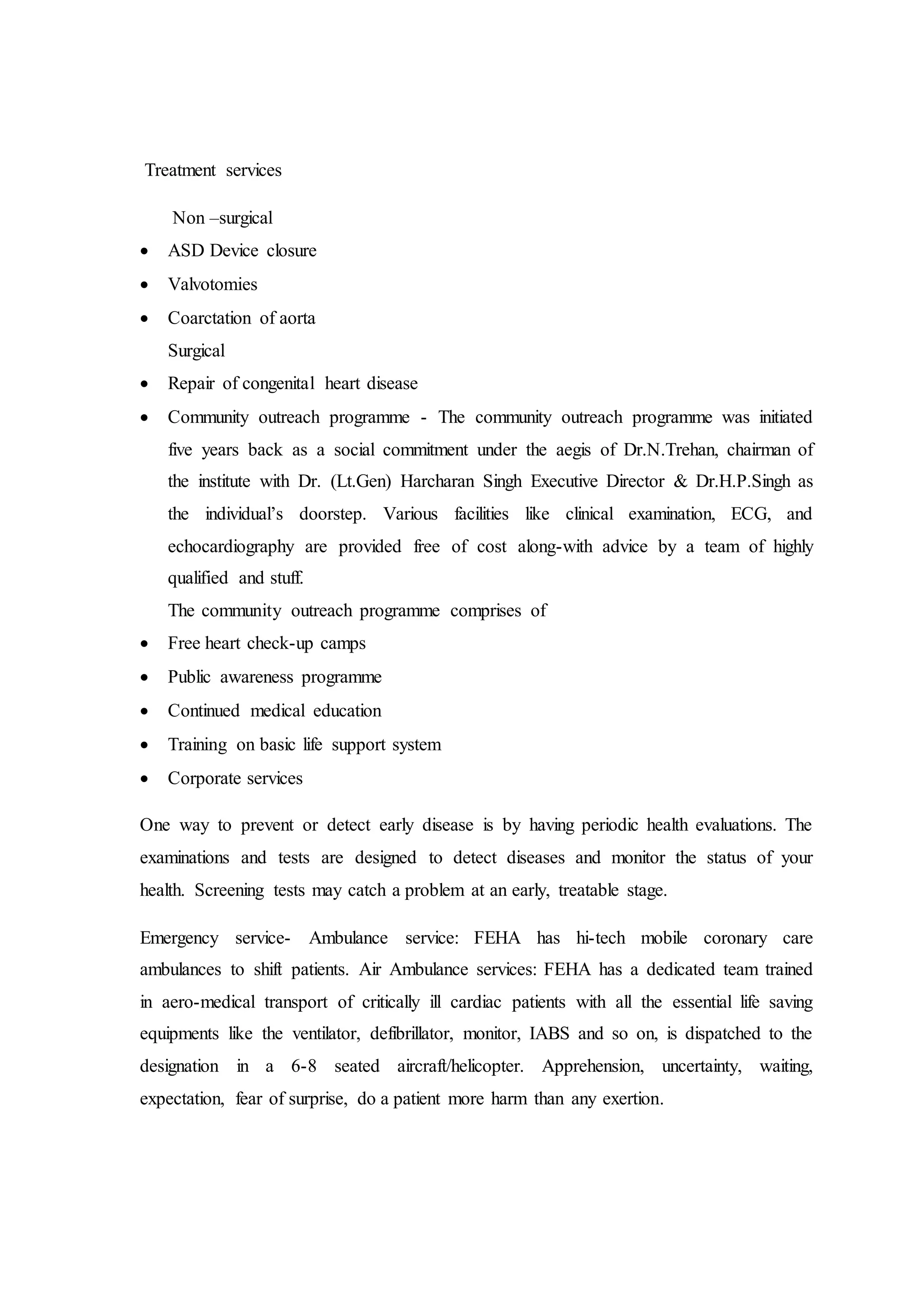
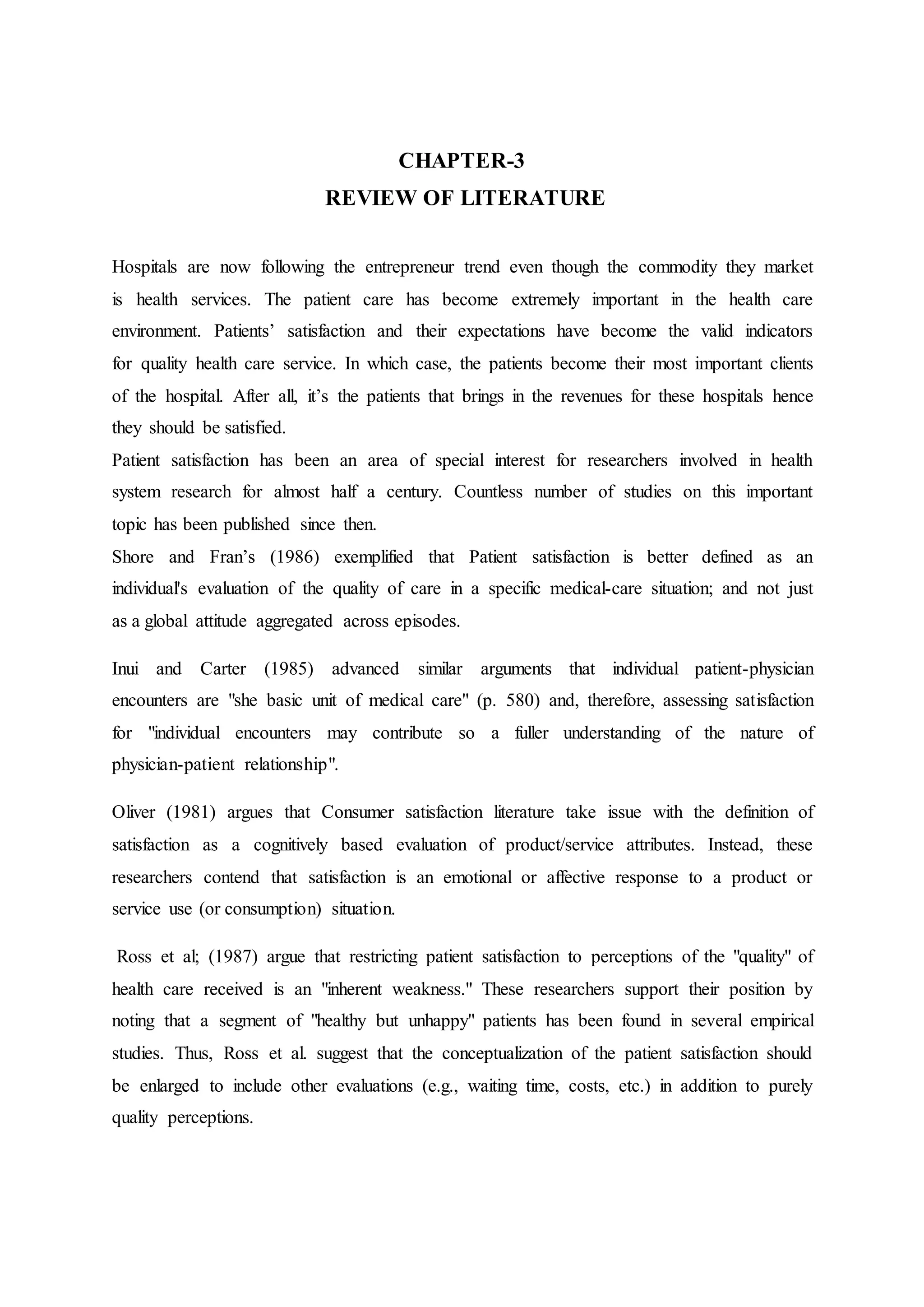
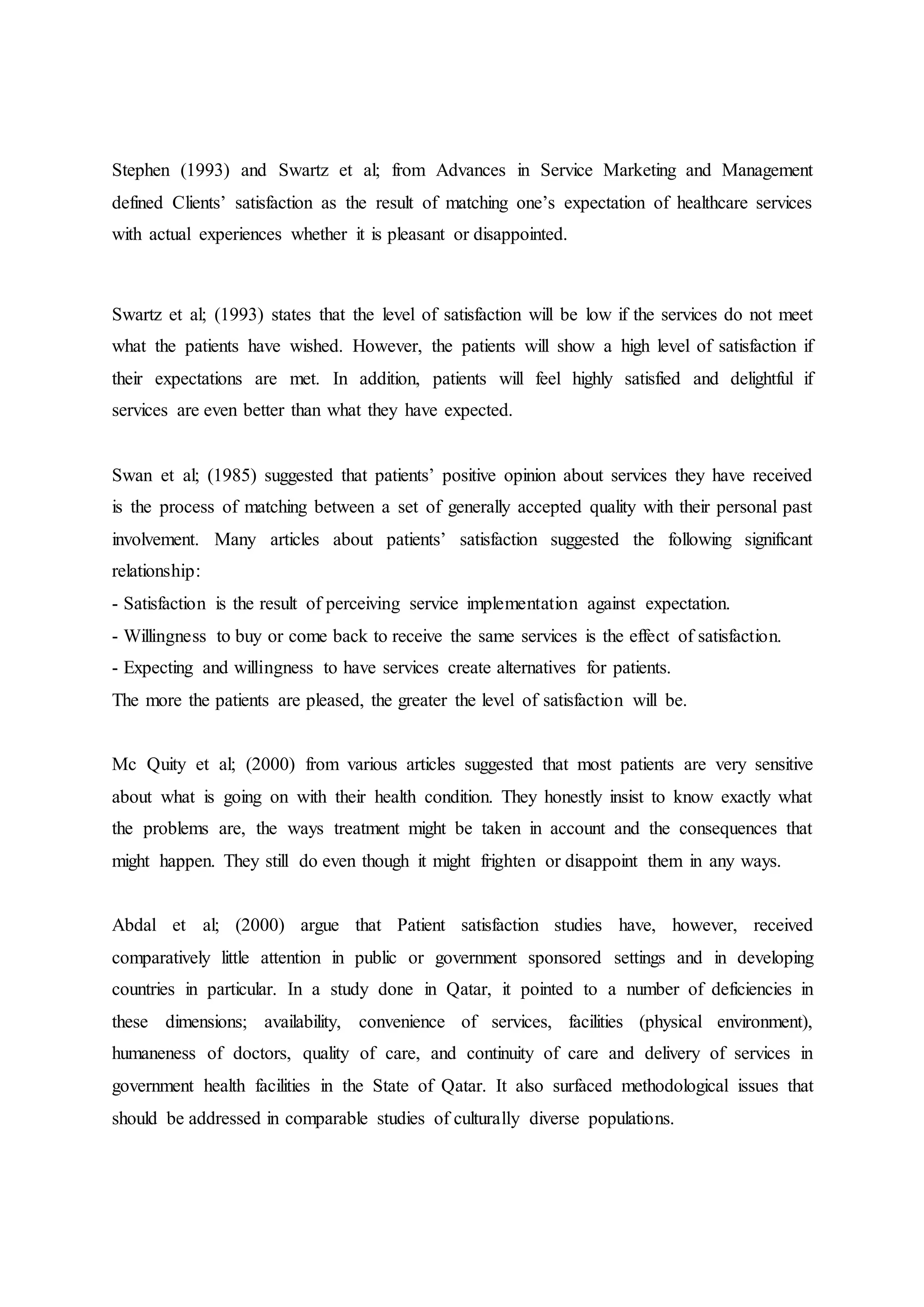
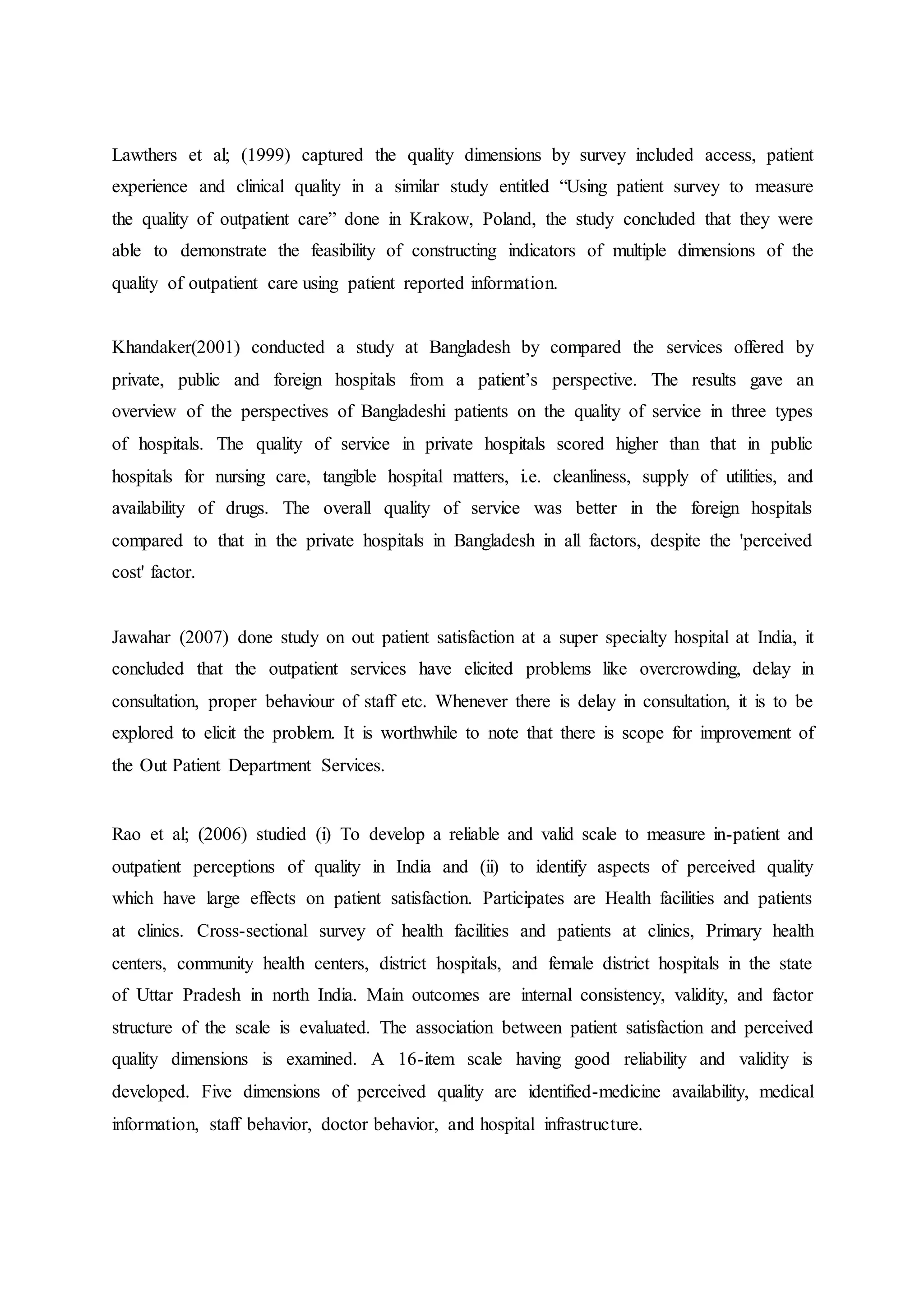
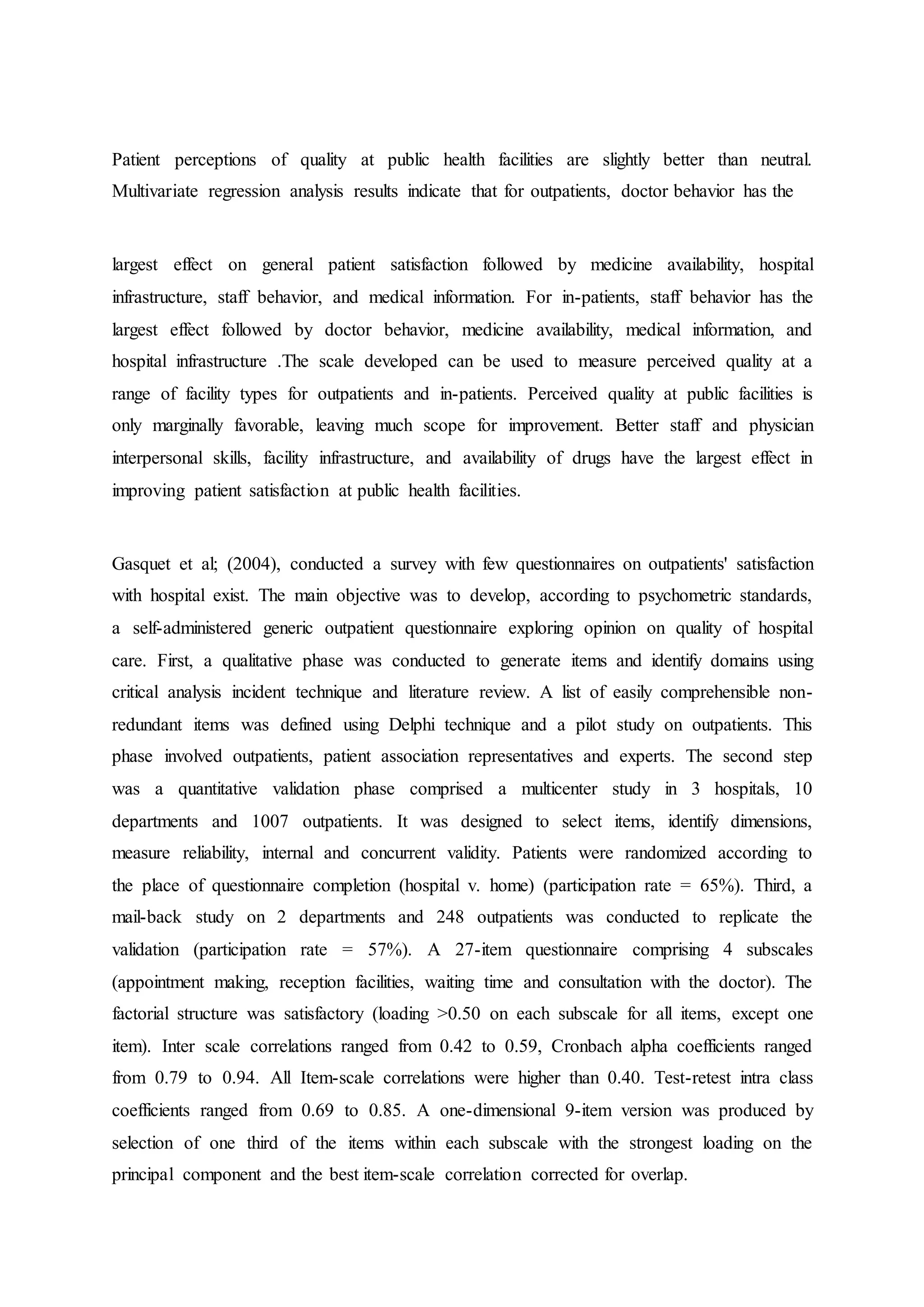
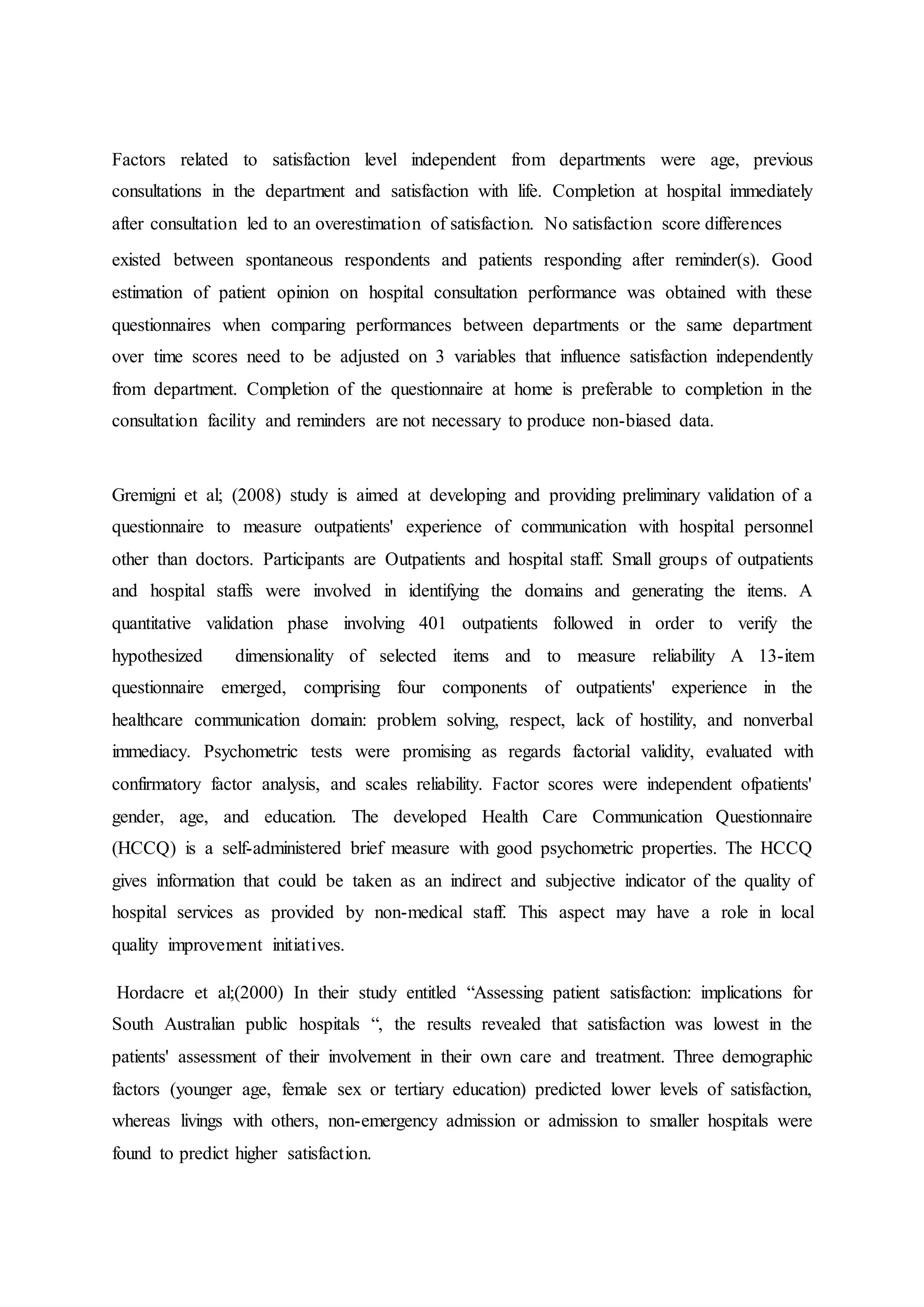
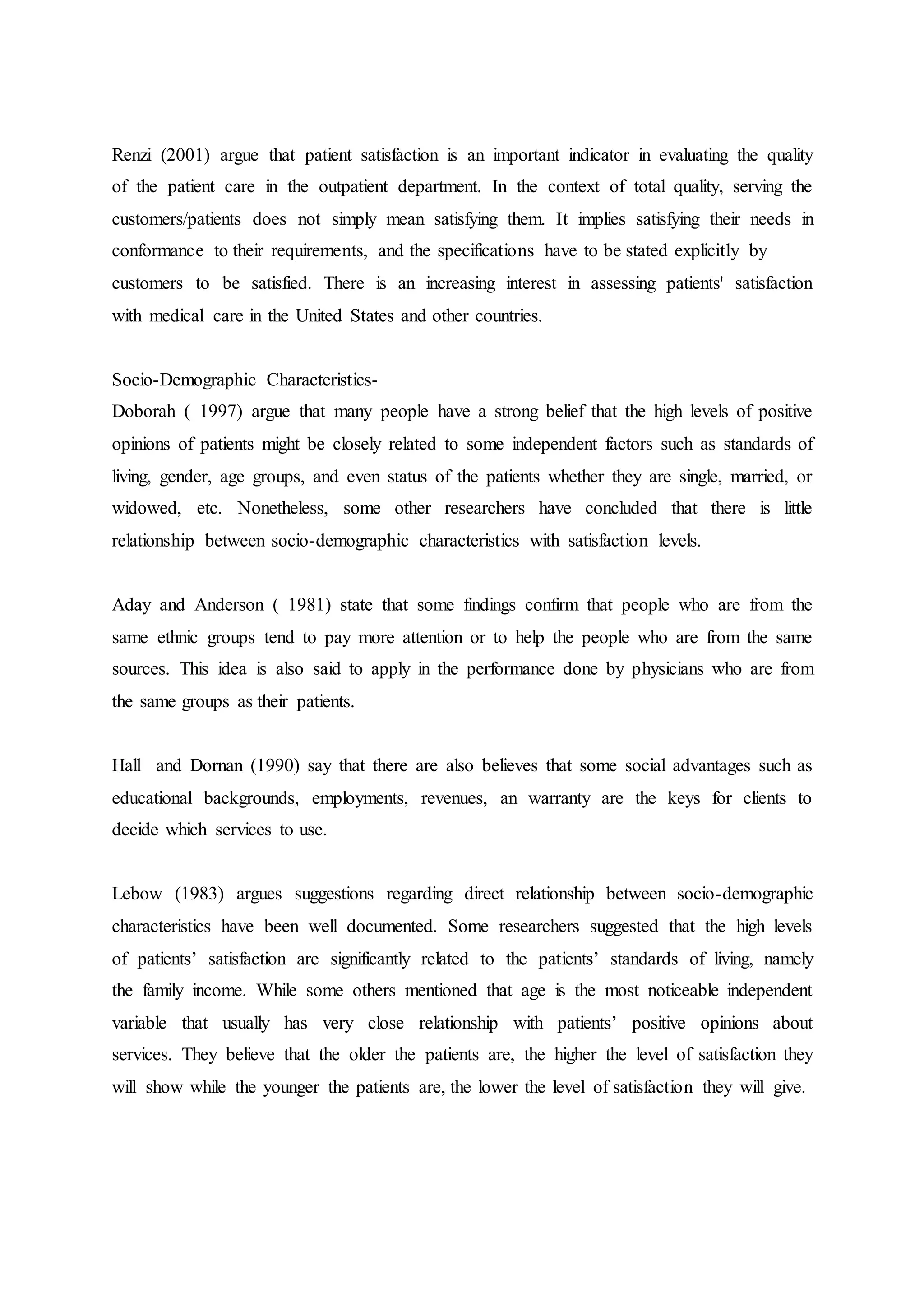
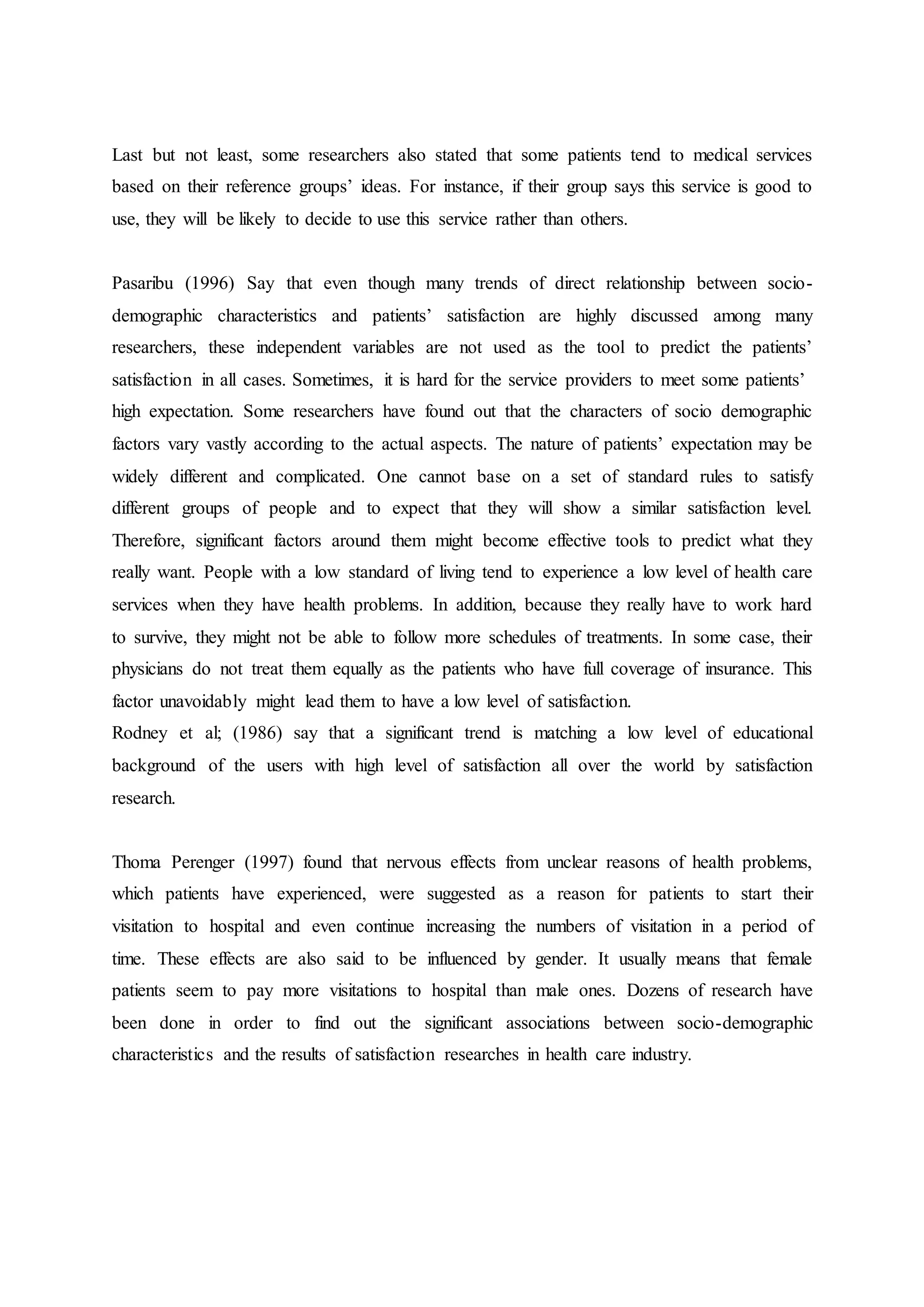
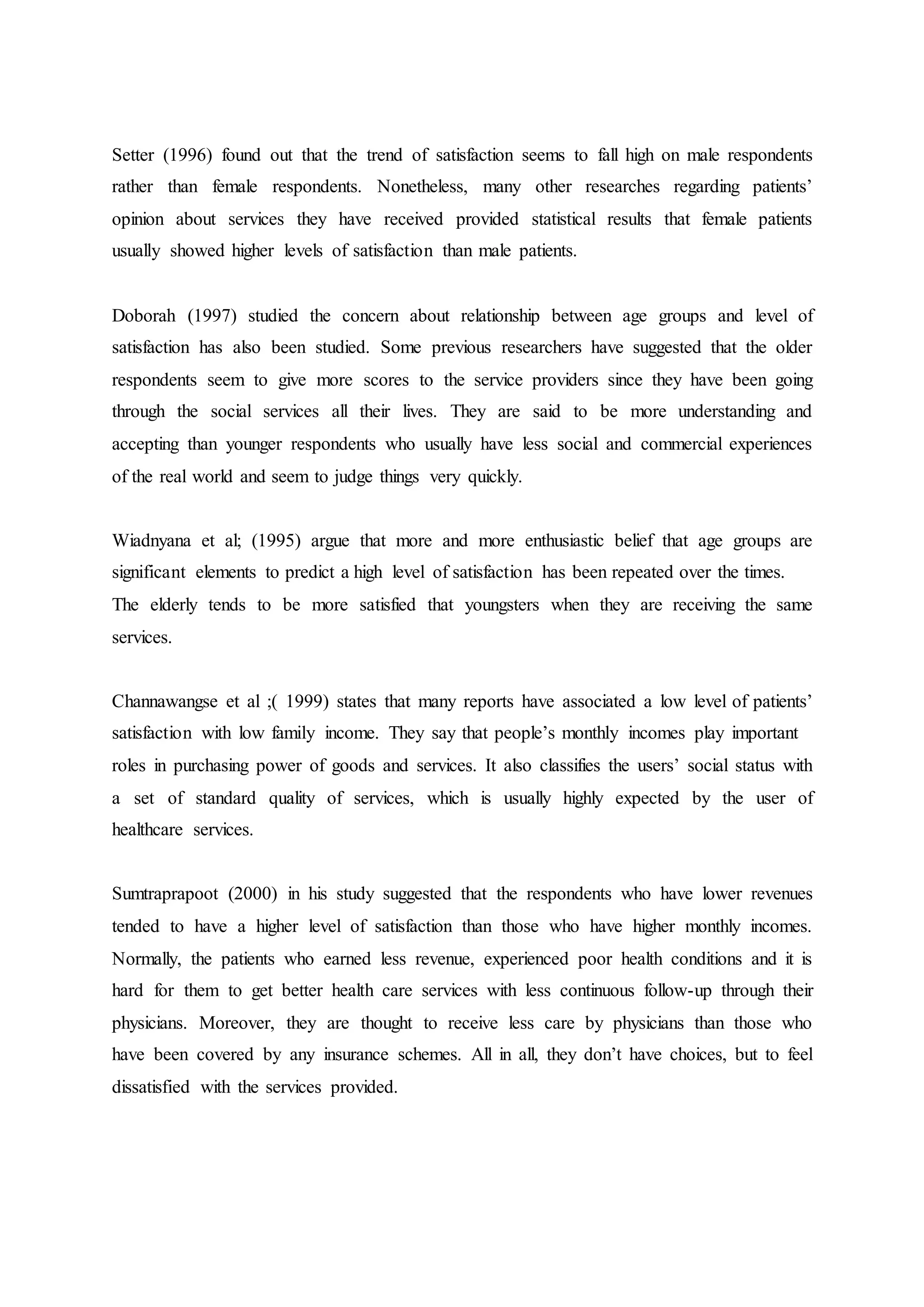

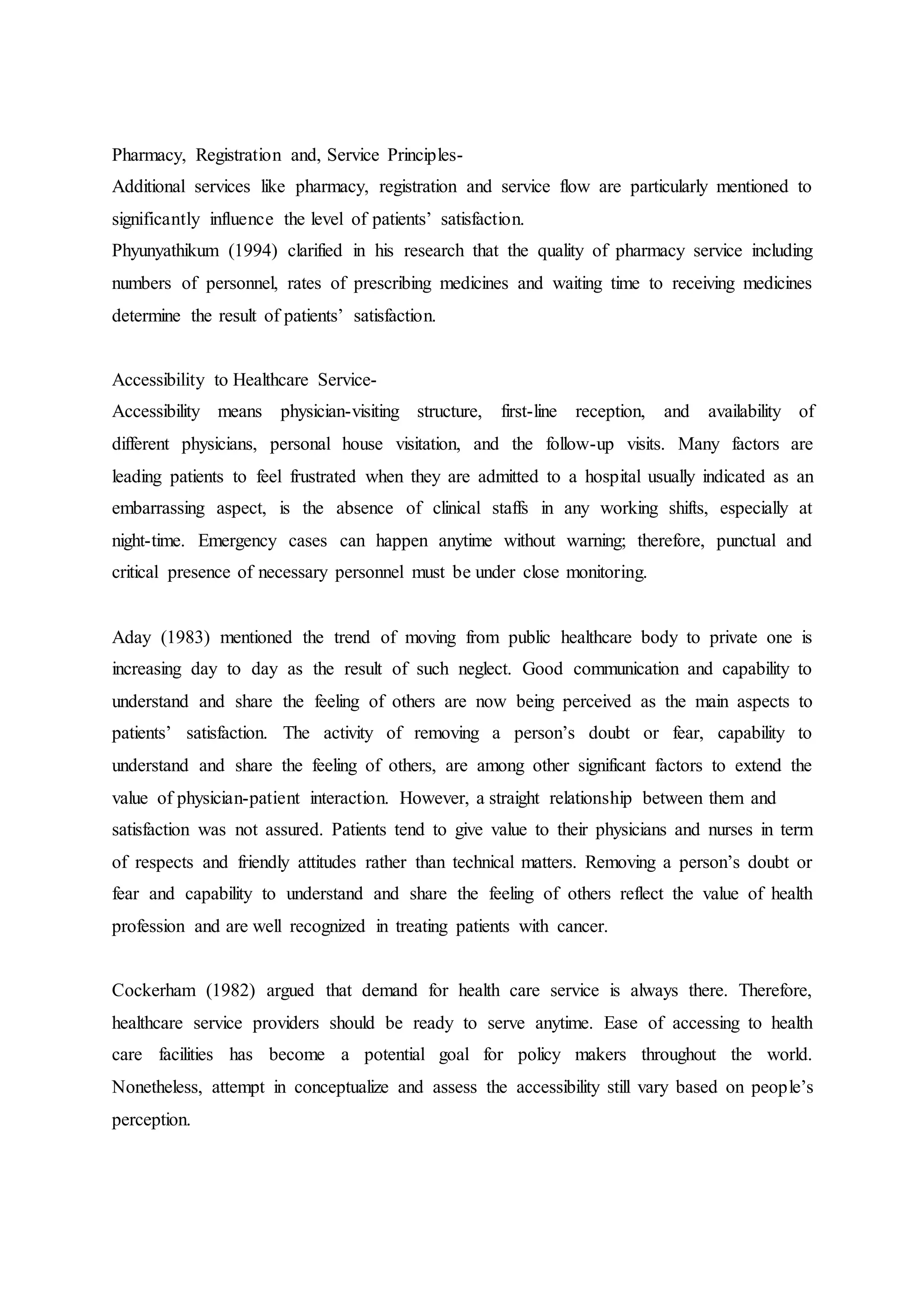


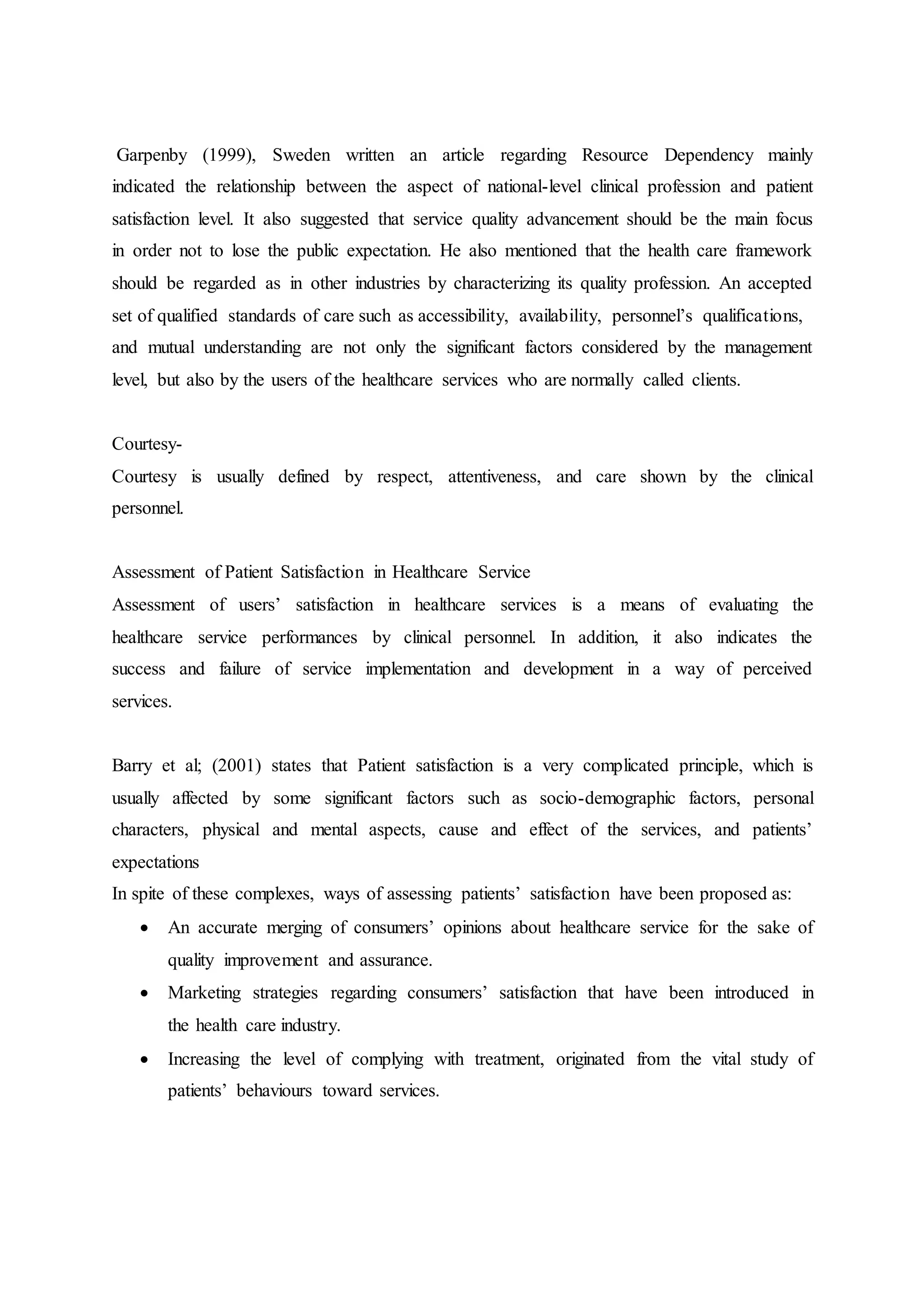
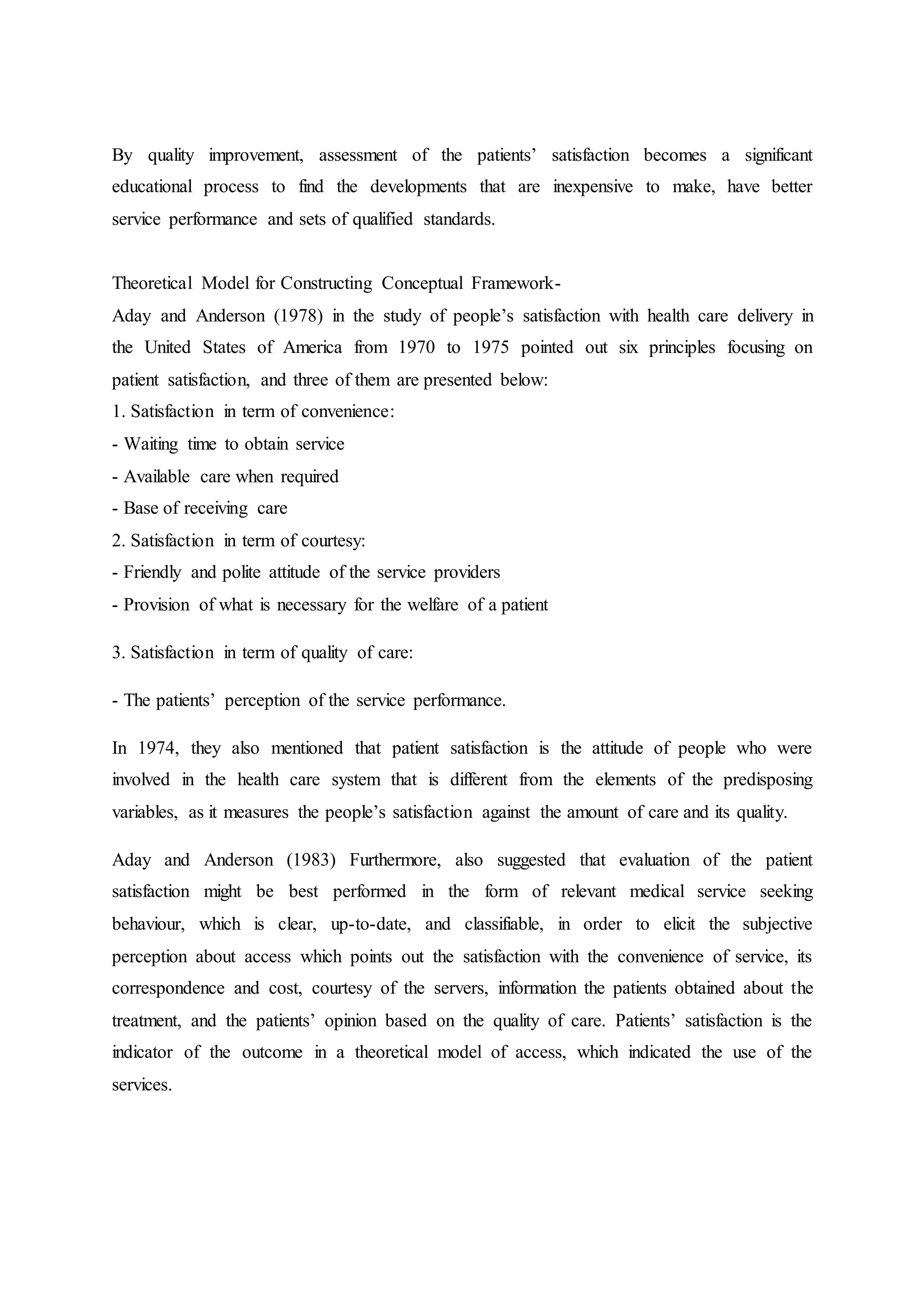
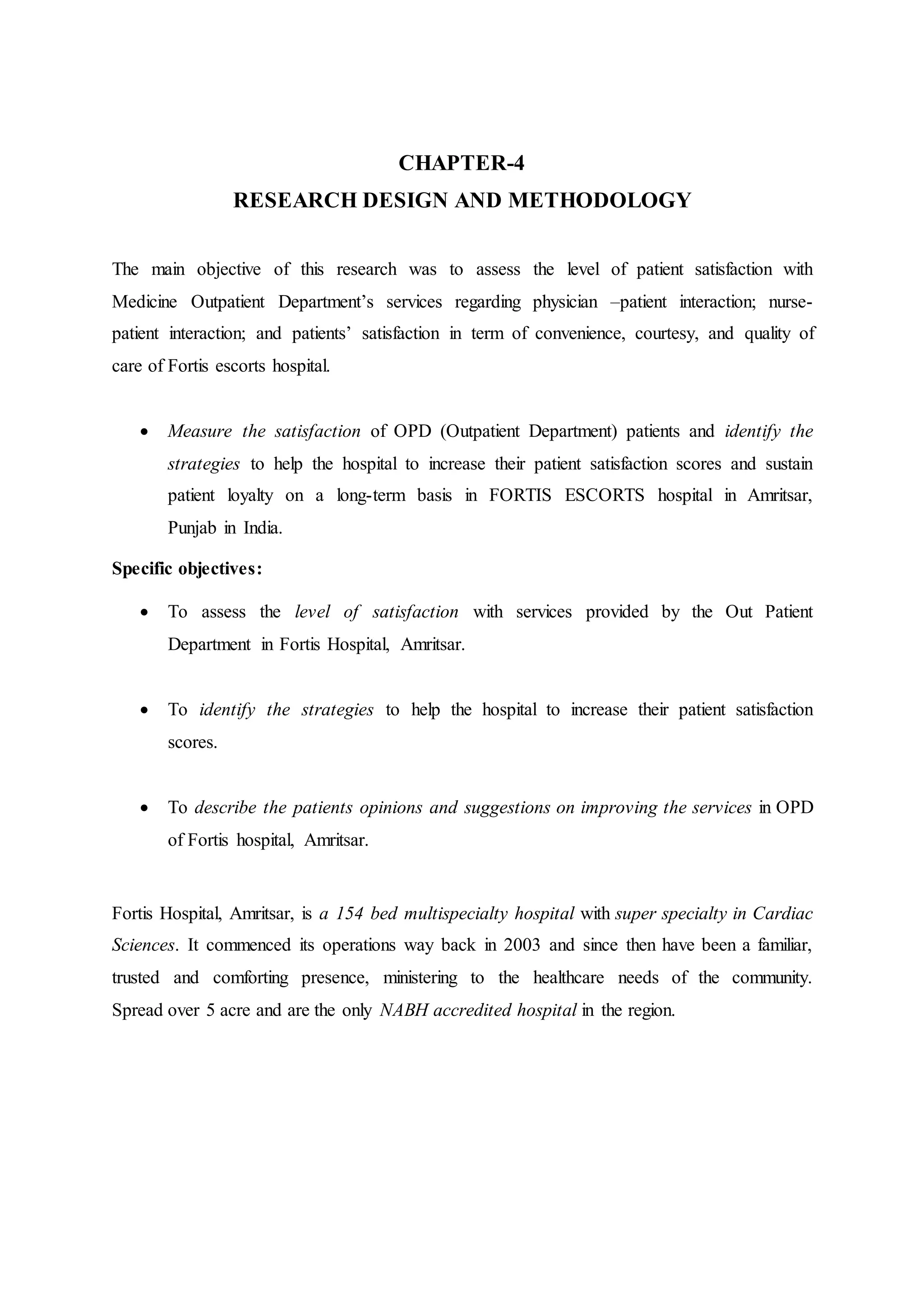


![Percentages were calculated for predisposing factors (sex, age, marital status, education
attainment, occupation)
In order to determine level of satisfaction - respondents were asked 20 questions and Likert’s
five points rating scaling was used for measuring satisfaction. The rating was done as follow:
5-COMPLETELY SATISFIED
4-SOME WHAT SATISFIED
3-NEUTRAL
2-SOME WHAT DISSATISFIED
1 -COMPLETELY DISSATISFIED
In satisfaction part, five-point Likert ranking scale was used for all the questions. Satisfaction
was computed as follows-
For example the responses from the patients from the overall rating of satisfaction of physical
facilities (about the sitting chairs in the waiting area) in OPD were 40(5) completely satisfied,
39(4) somewhat satisfied, 3(3) neutral, 9(2)somewhat dissatisfied , and 9(1)completely
dissatisfied.
The total no. of responses was equal to 100.
Satisfaction score = [40x5+39x4+3x3+9x2+9x1]/100=3.92.
In this study we divide into two levels of satisfaction as high and low by using mean score as
the cut- off point as best criteria.(from Amin Khan Mandokhail 4937996 ADPM/M).
Standard deviation (SD) (represented by the Greek letter sigma, σ) shows how much
variation or dispersion from the average exists.
Calculated by the formula-](https://image.slidesharecdn.com/finalthesis2-150519132519-lva1-app6892/75/Final-thesis-2-33-2048.jpg)
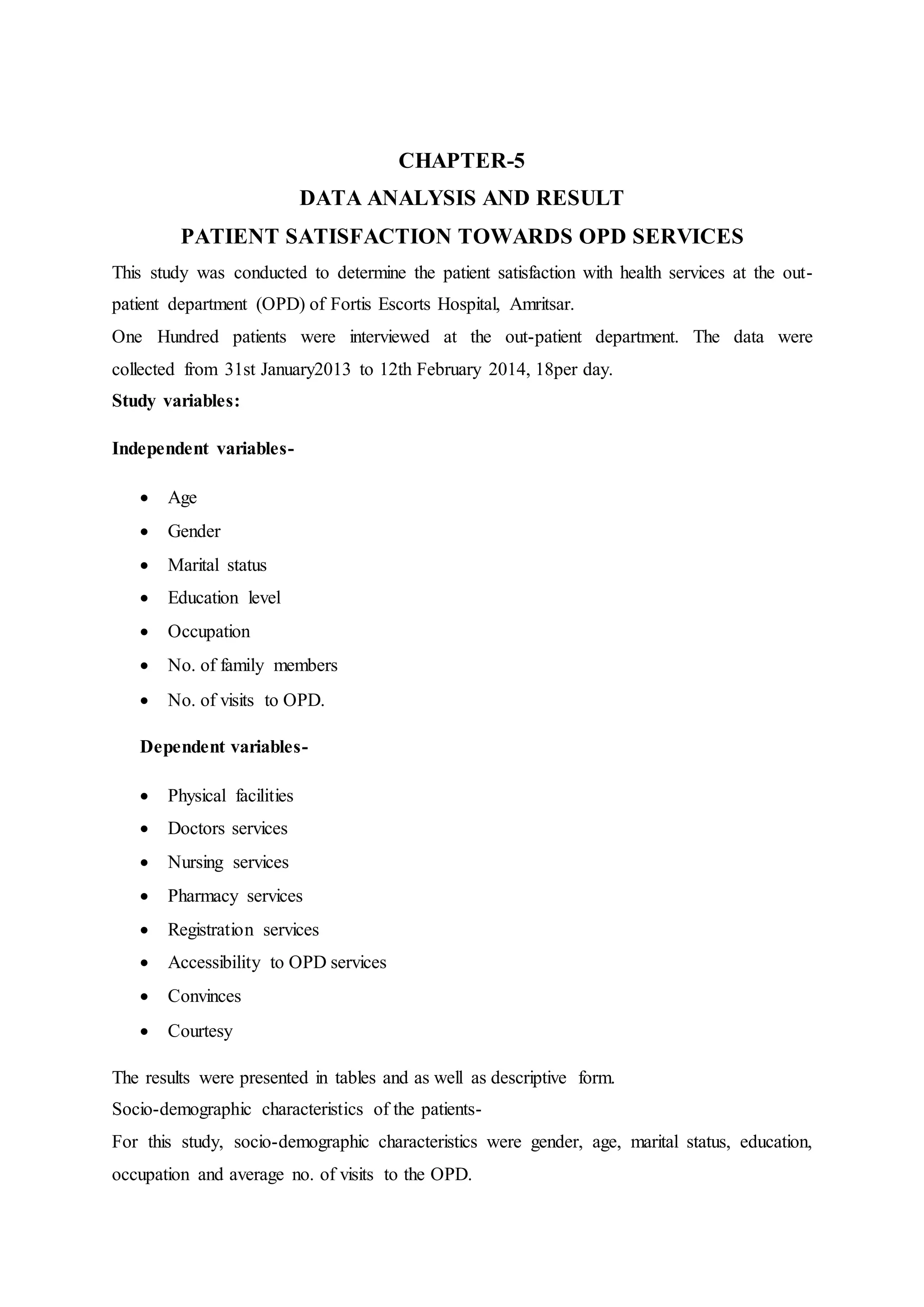
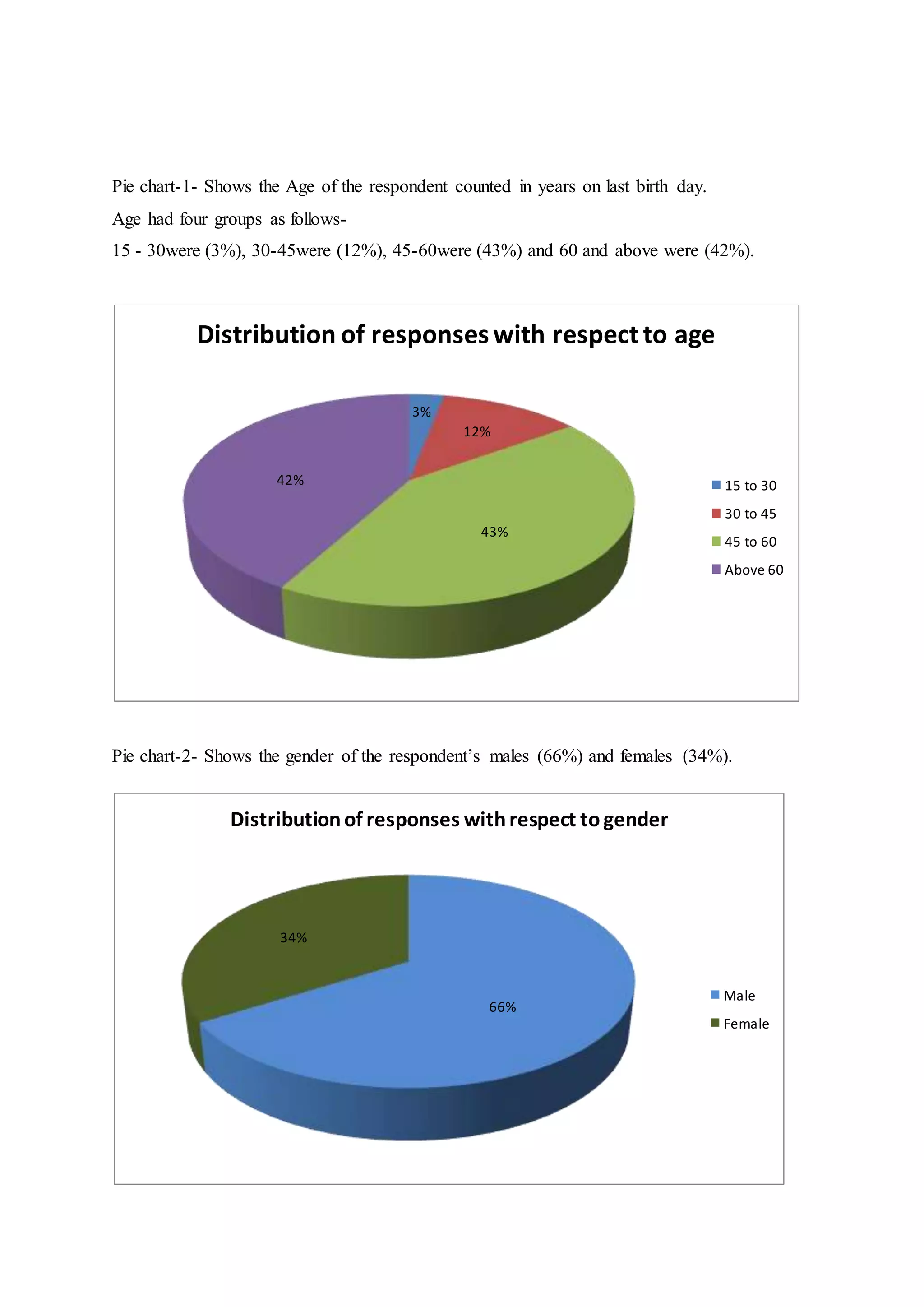
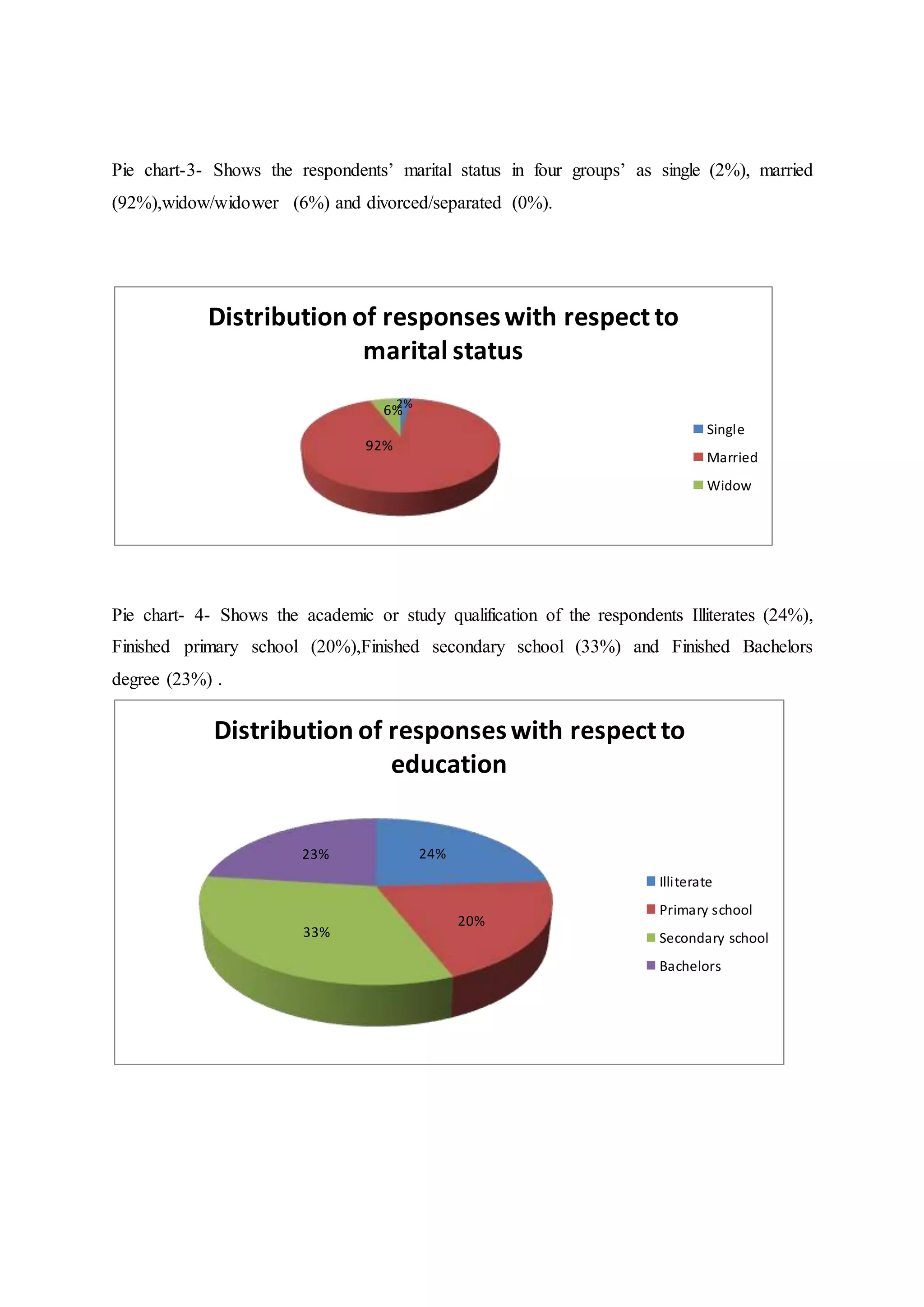
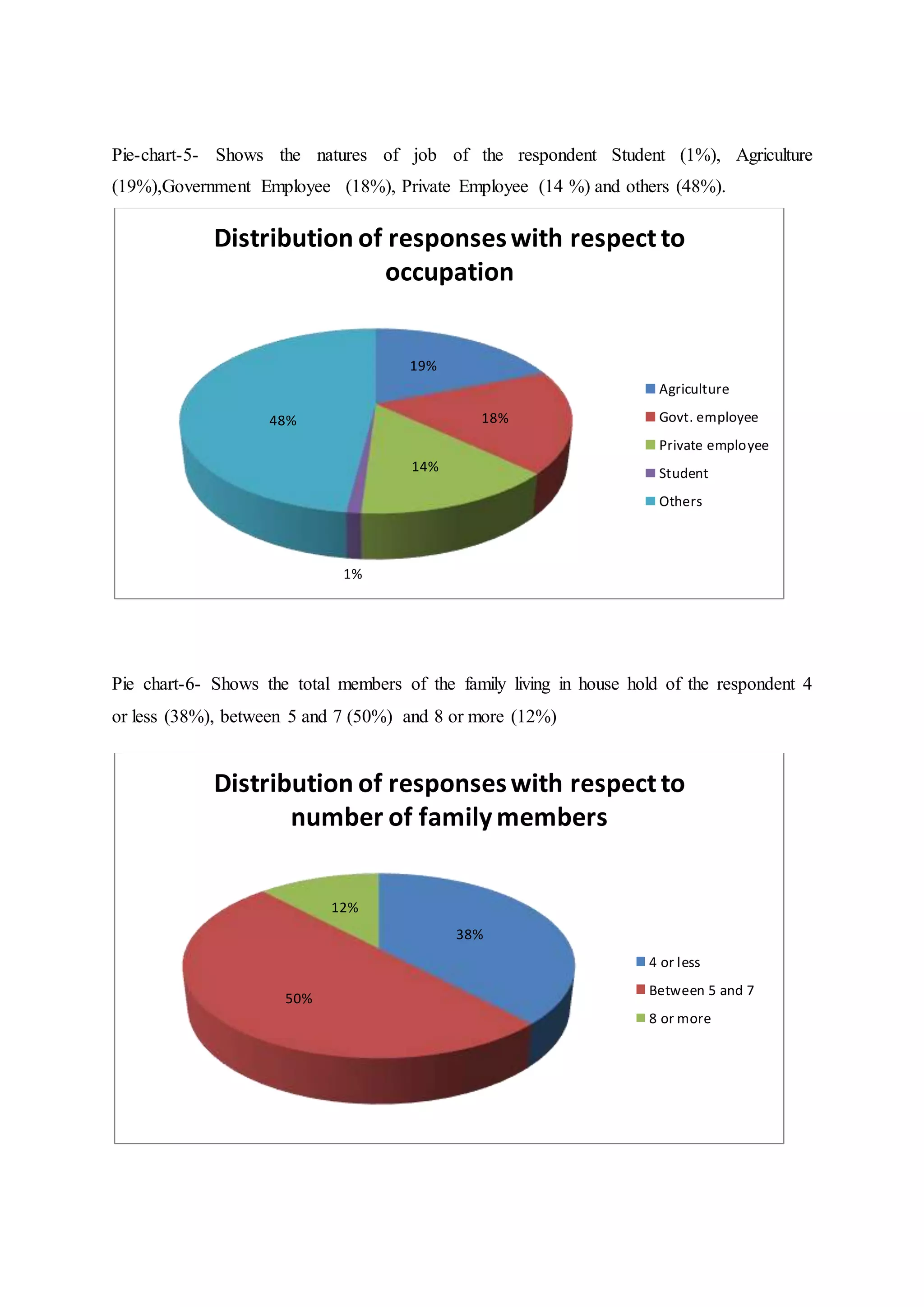

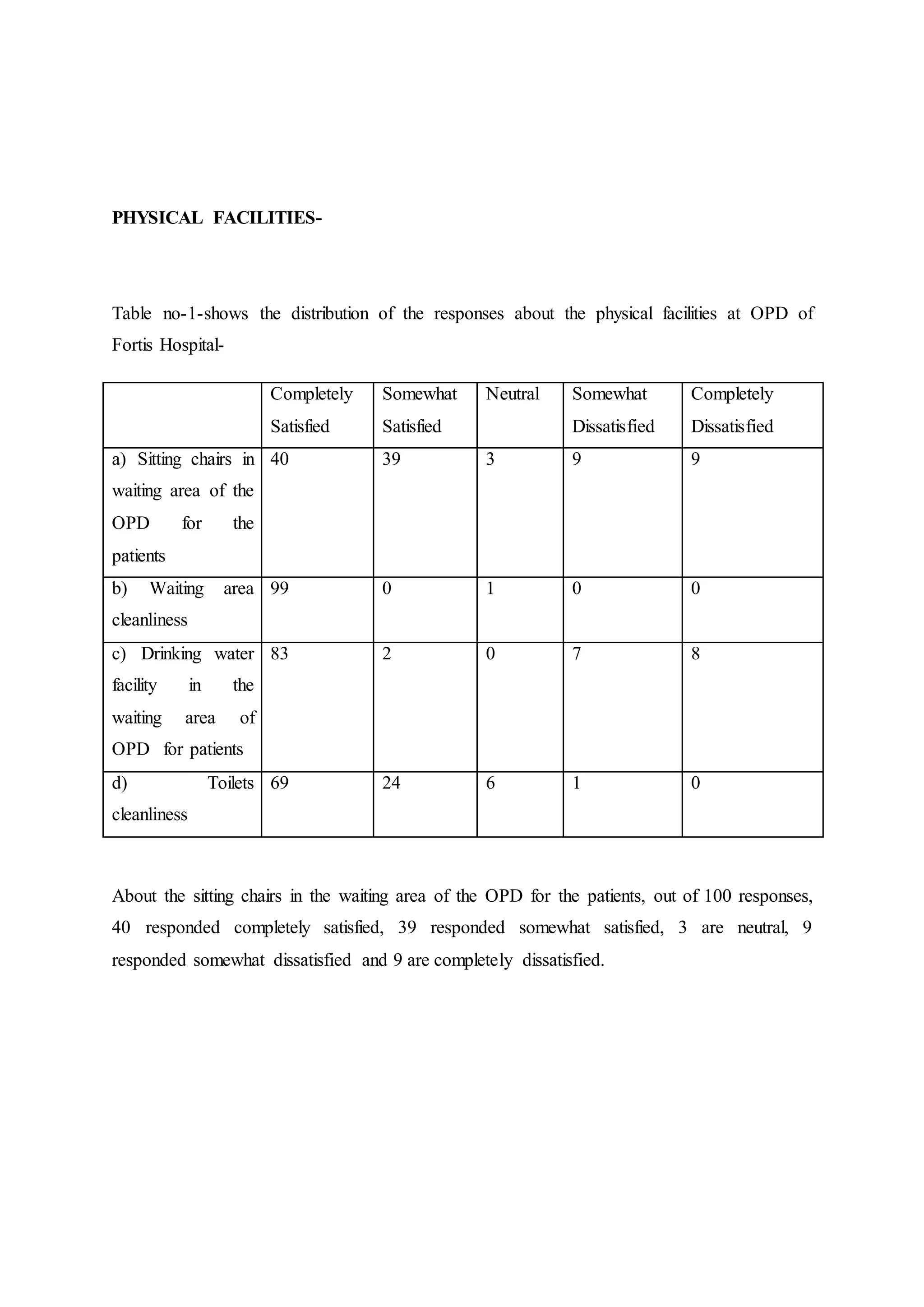
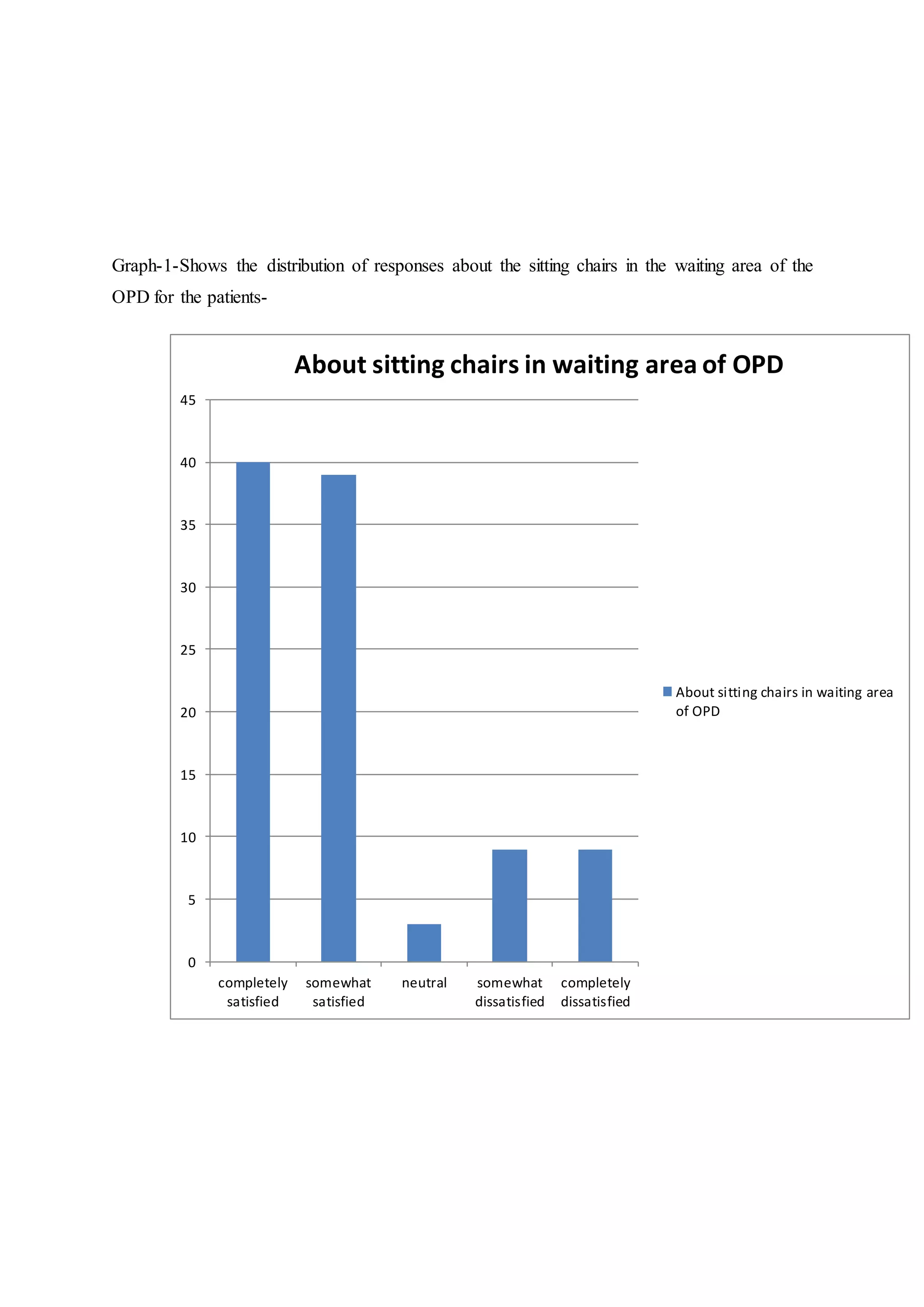

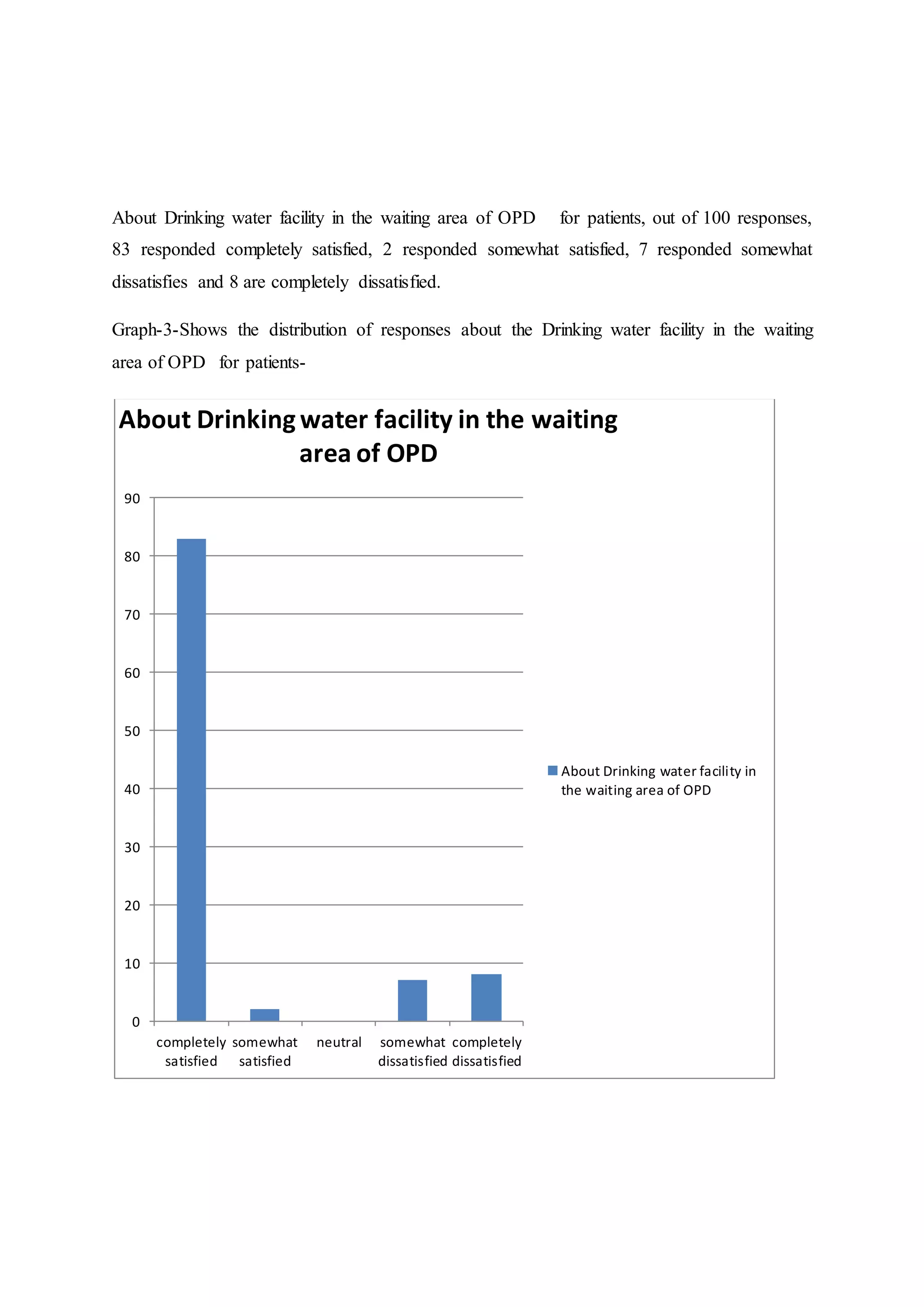
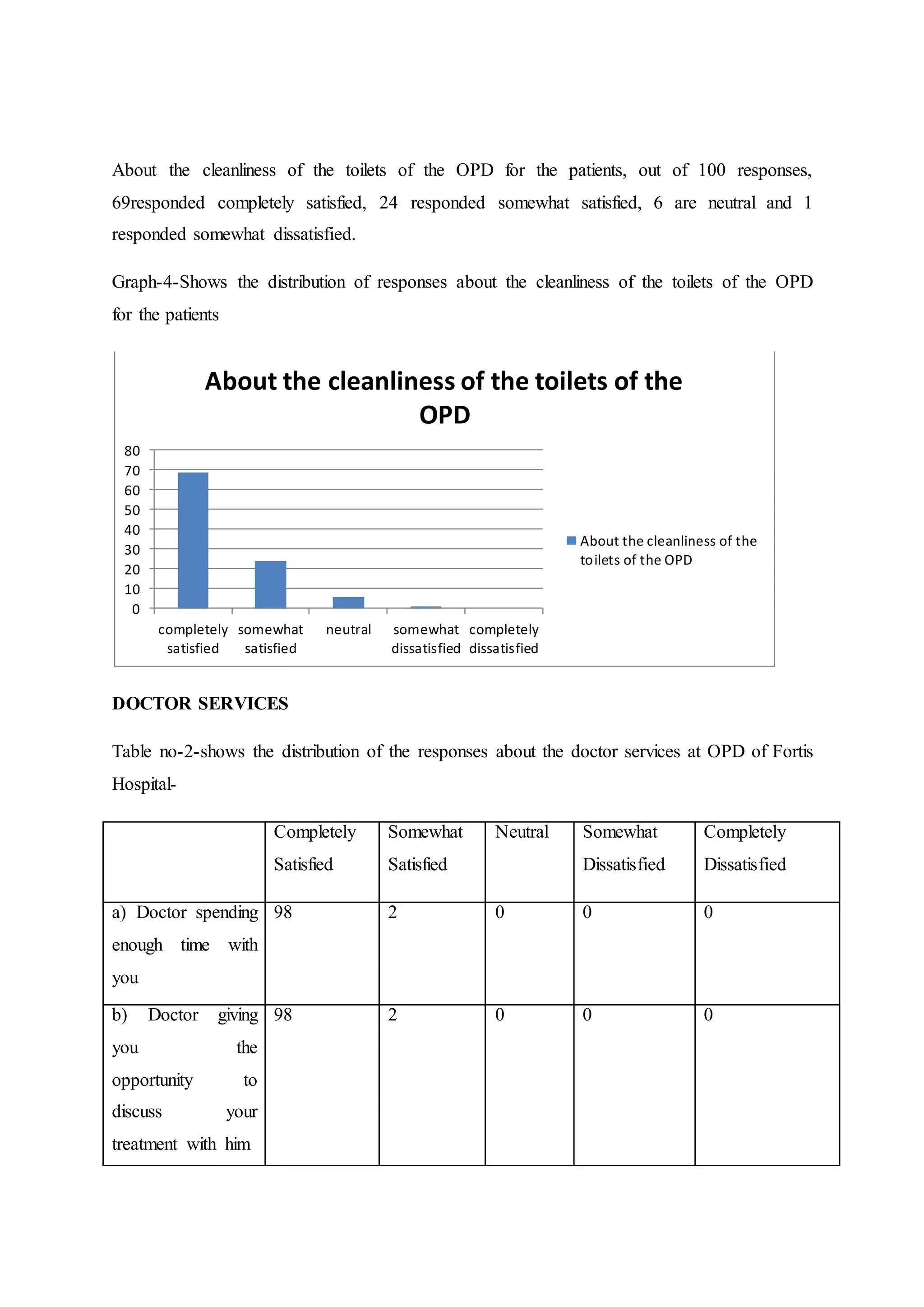
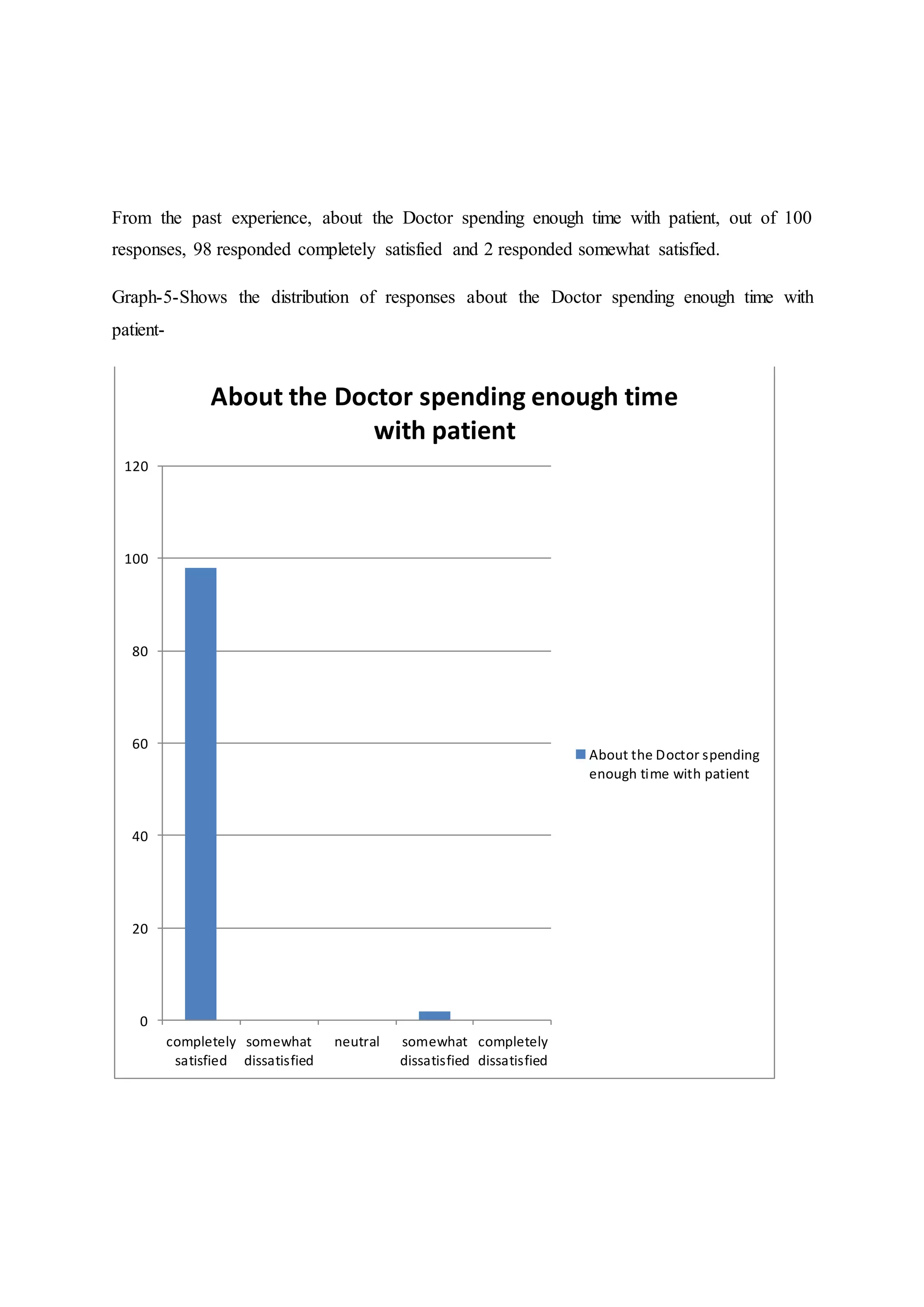

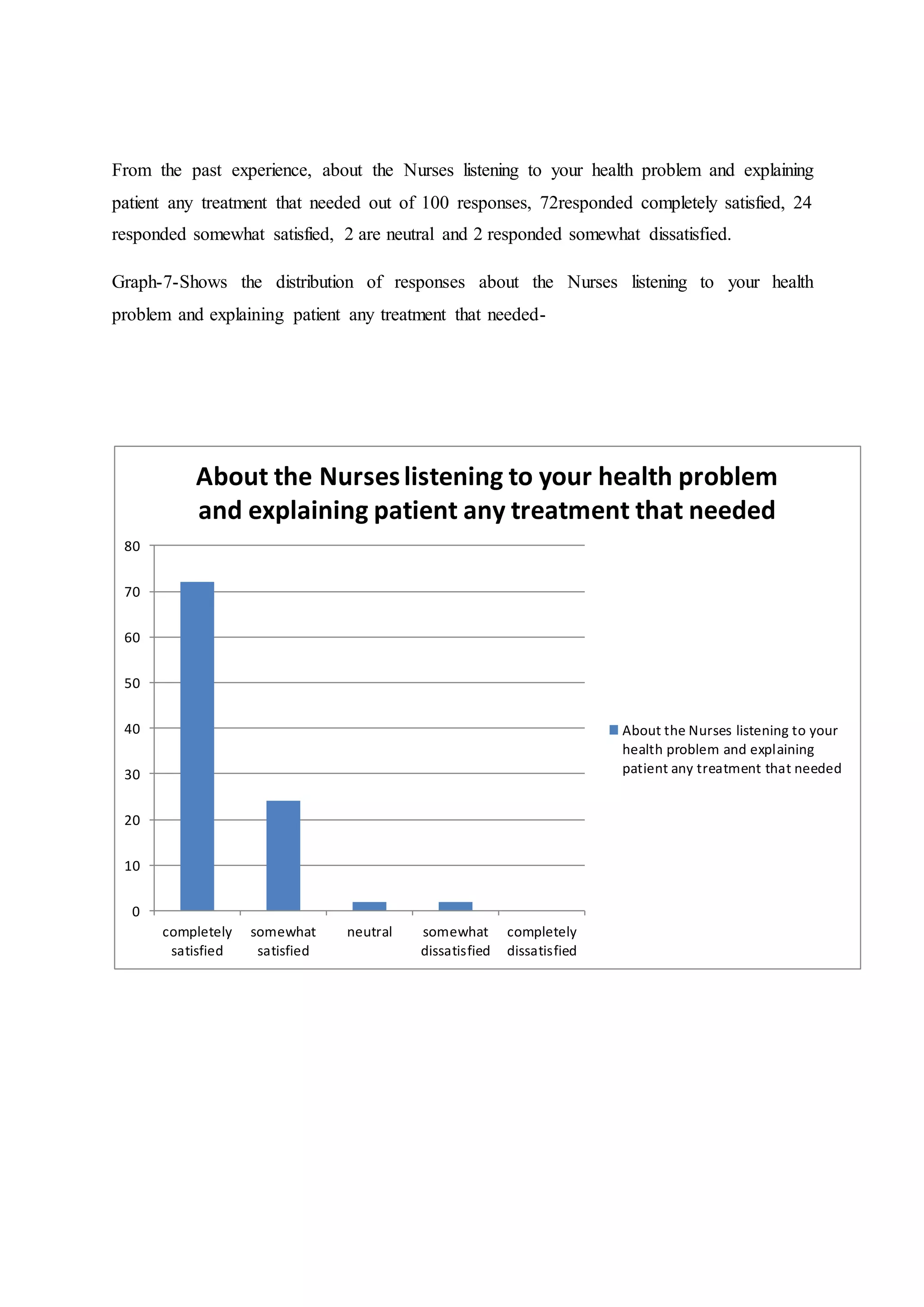
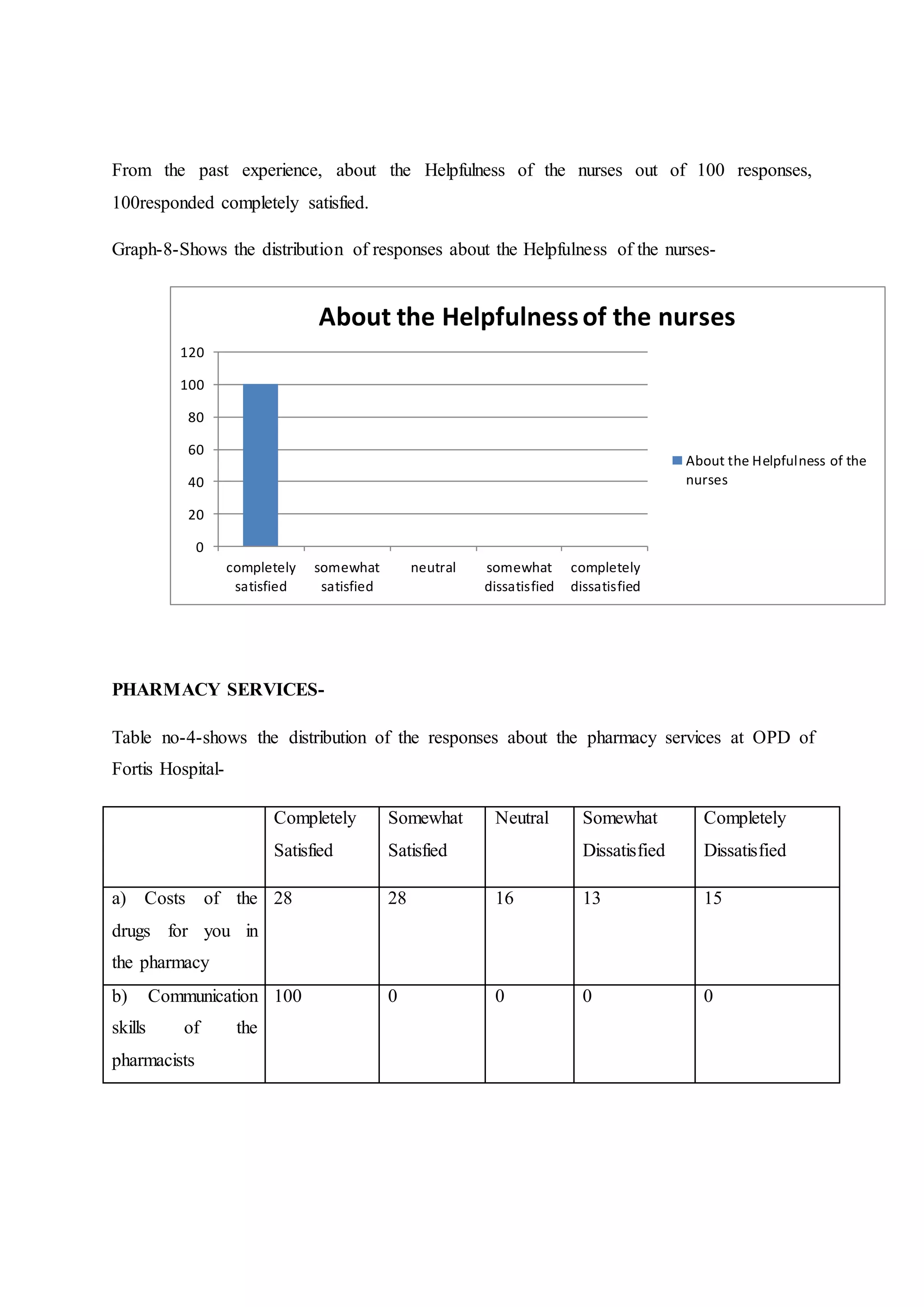
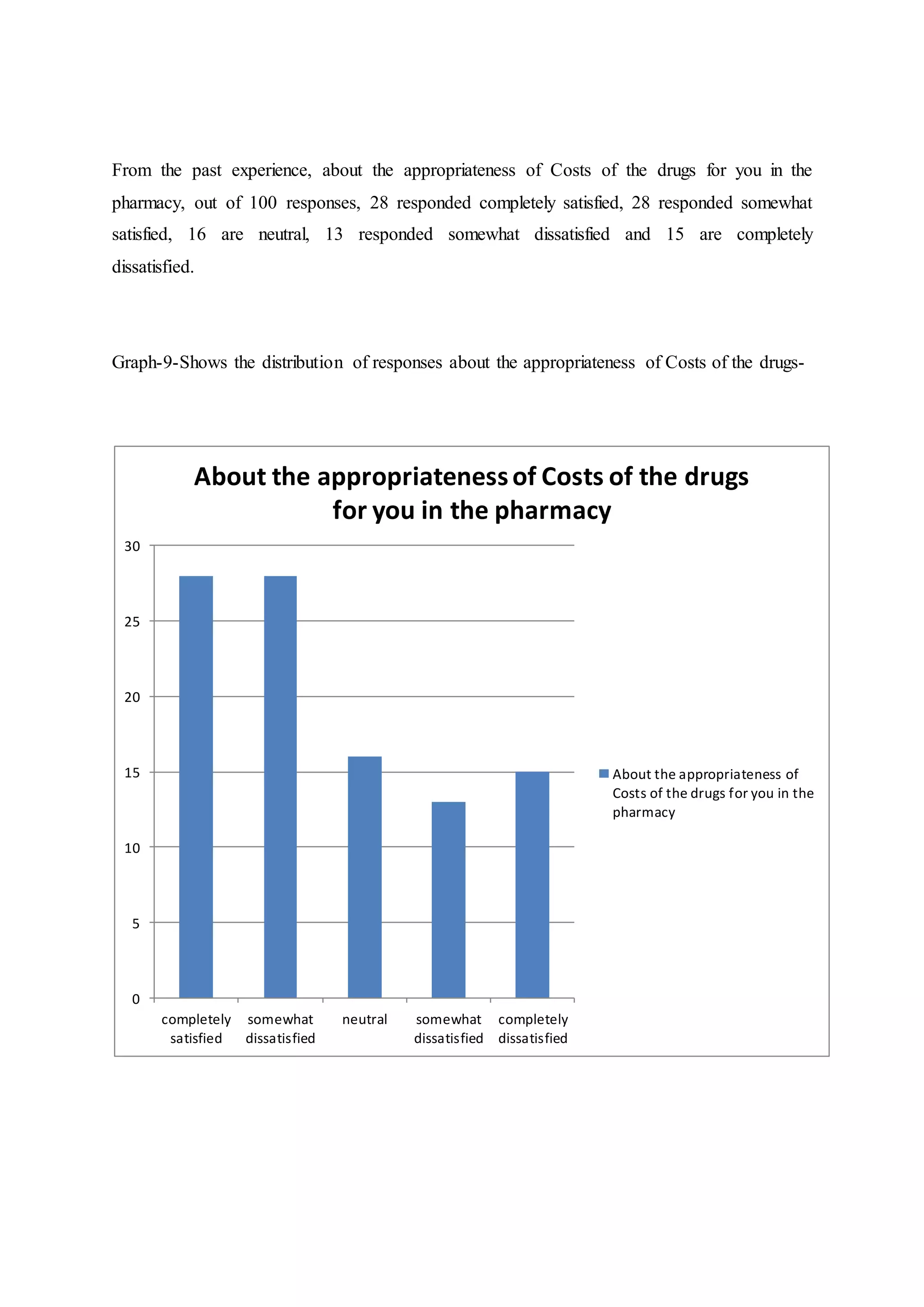
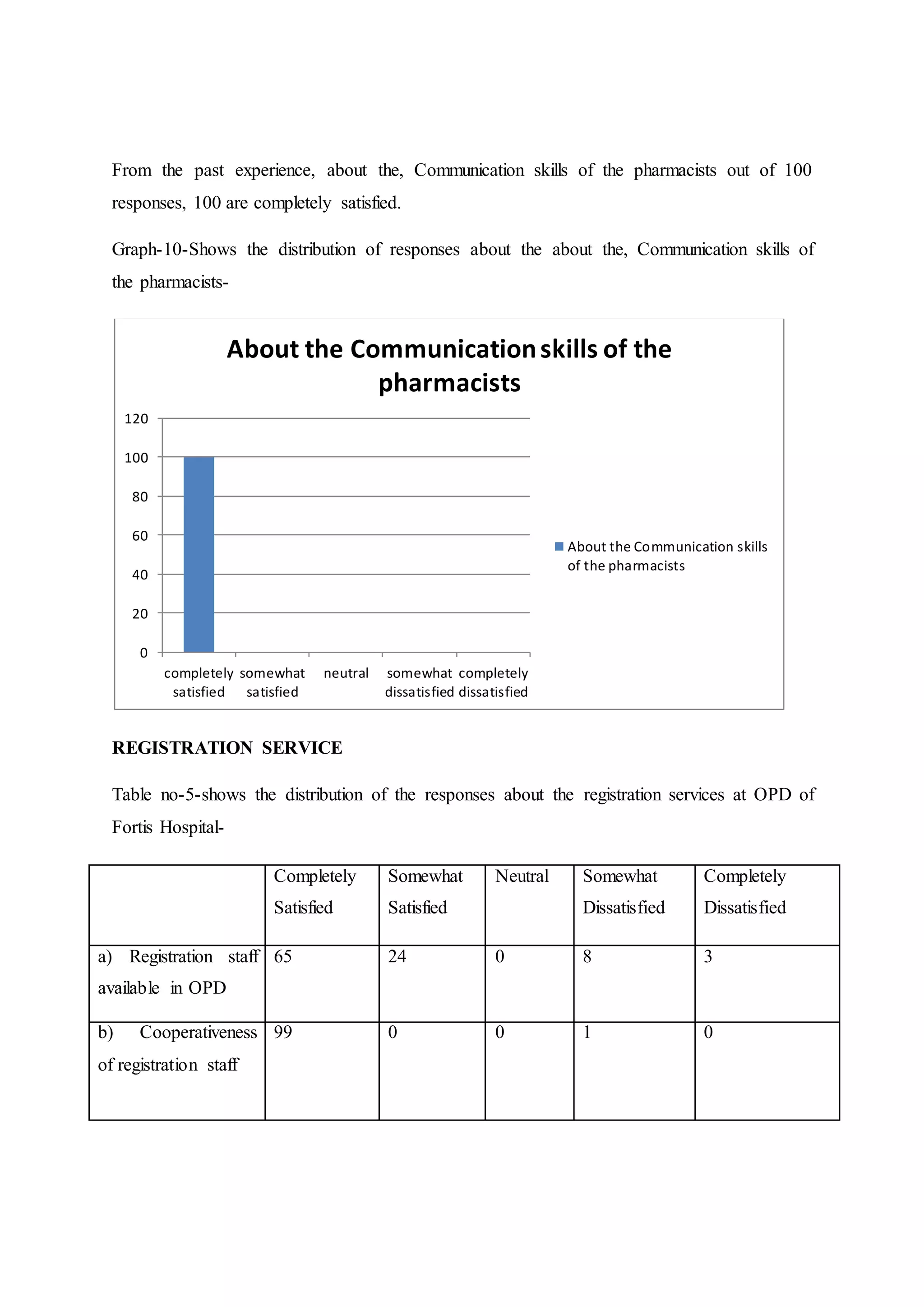



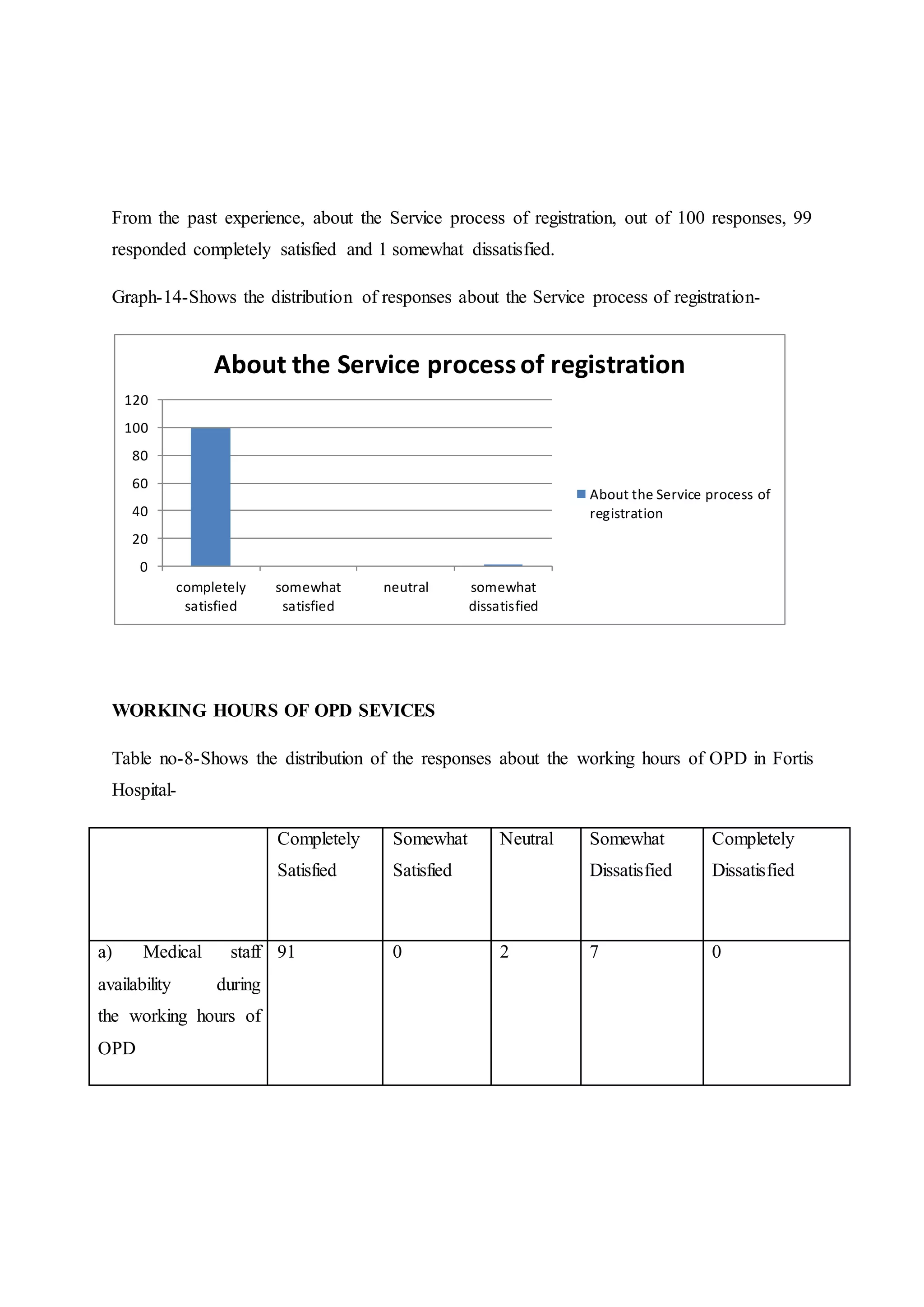
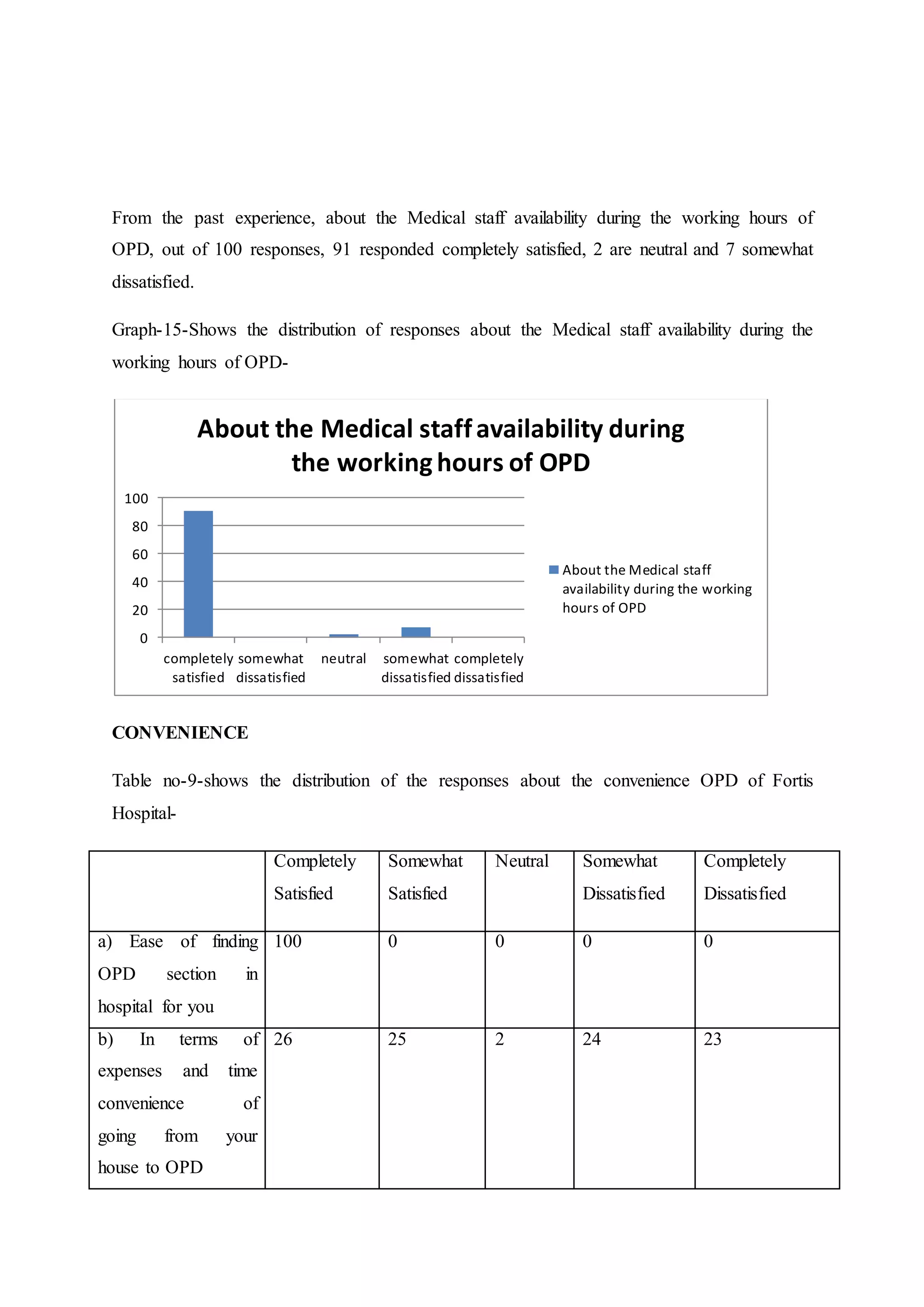
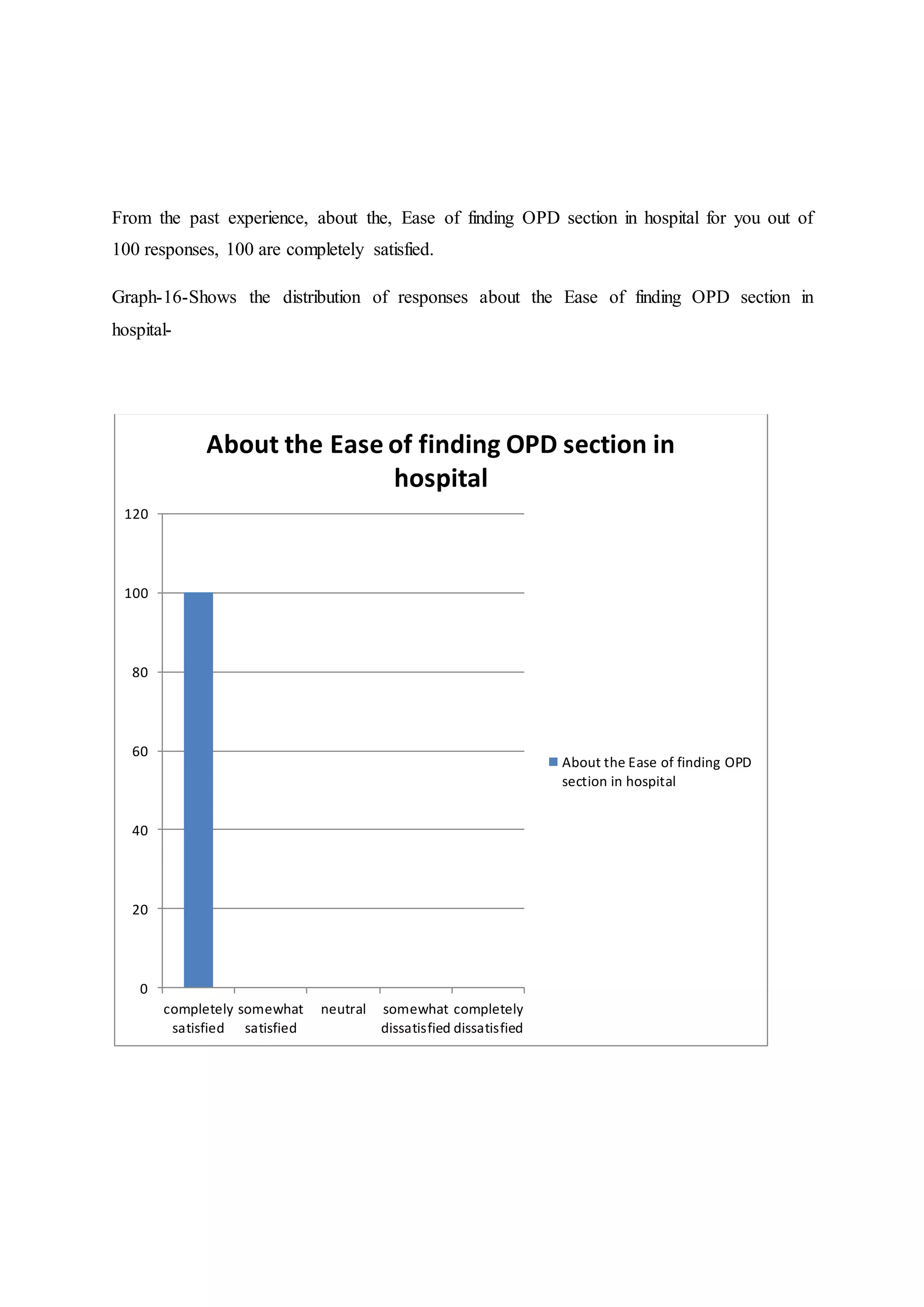

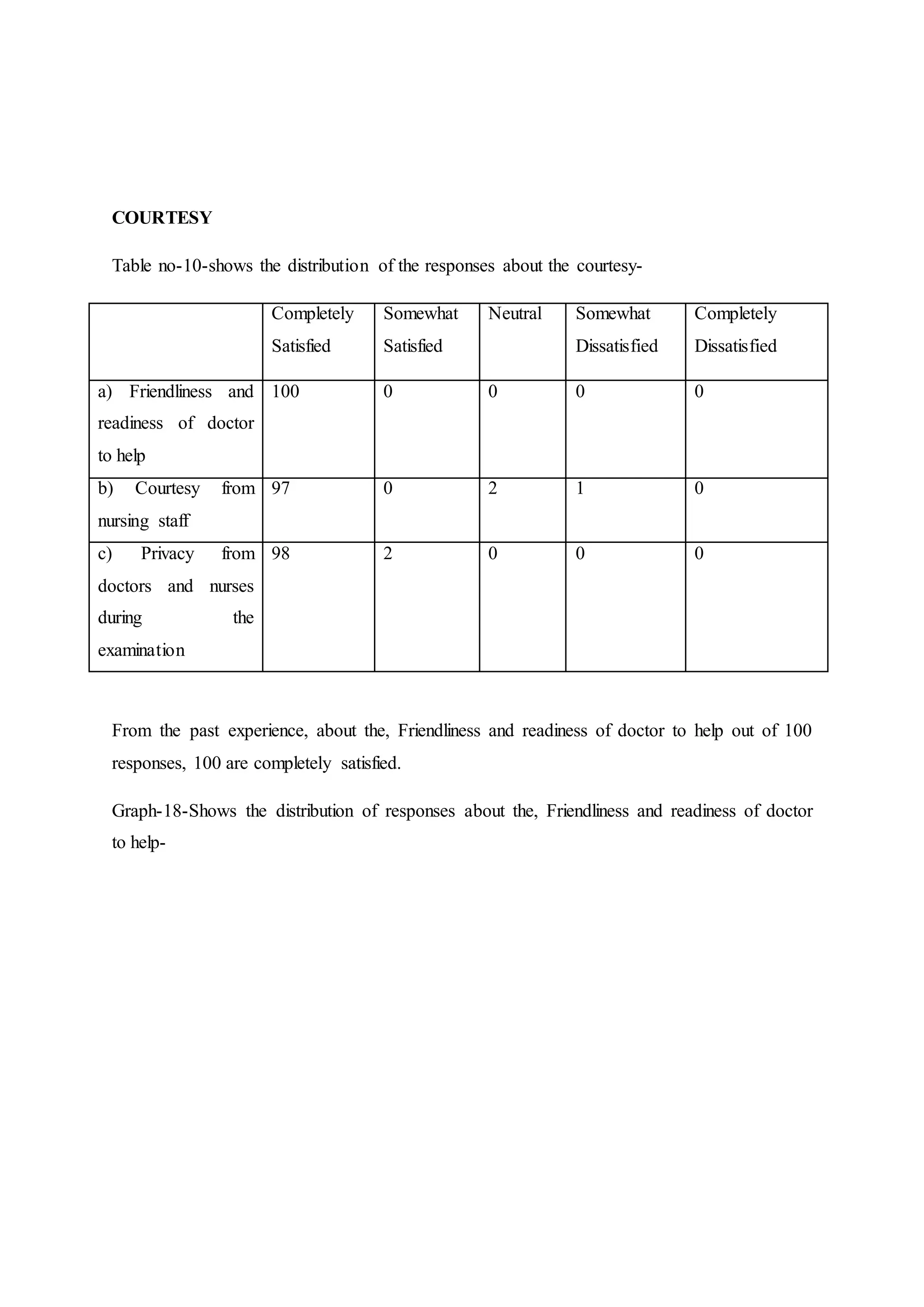
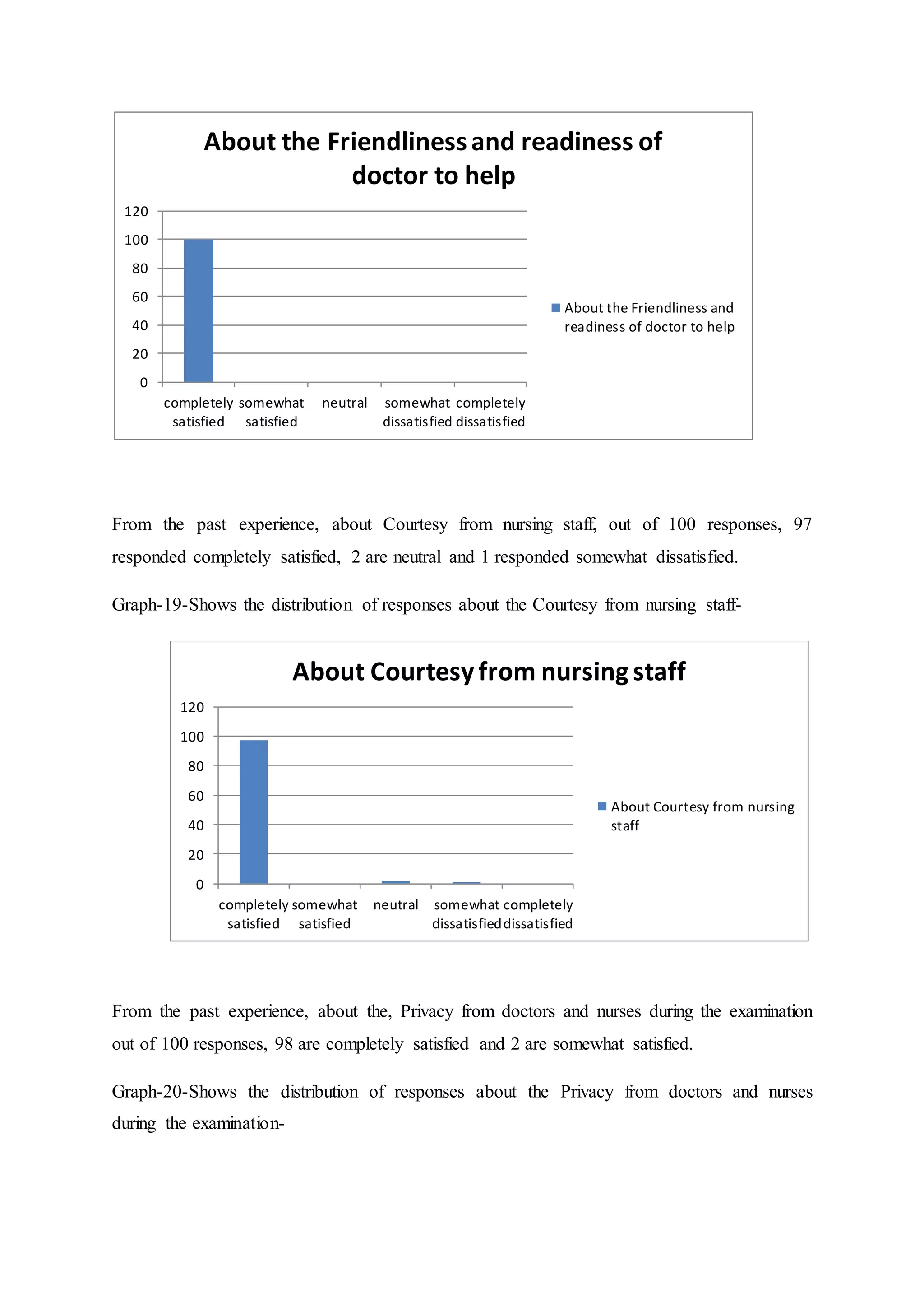
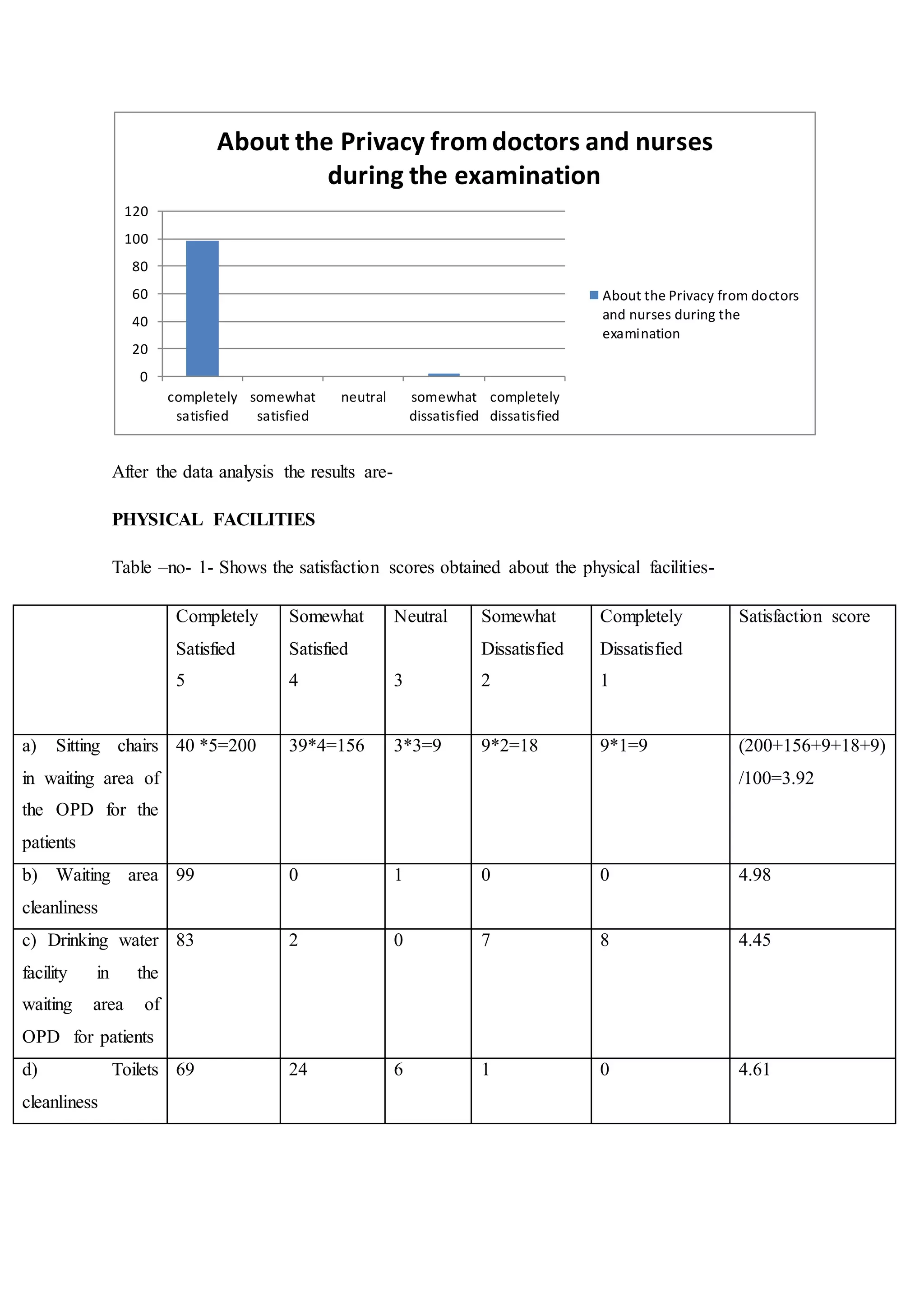
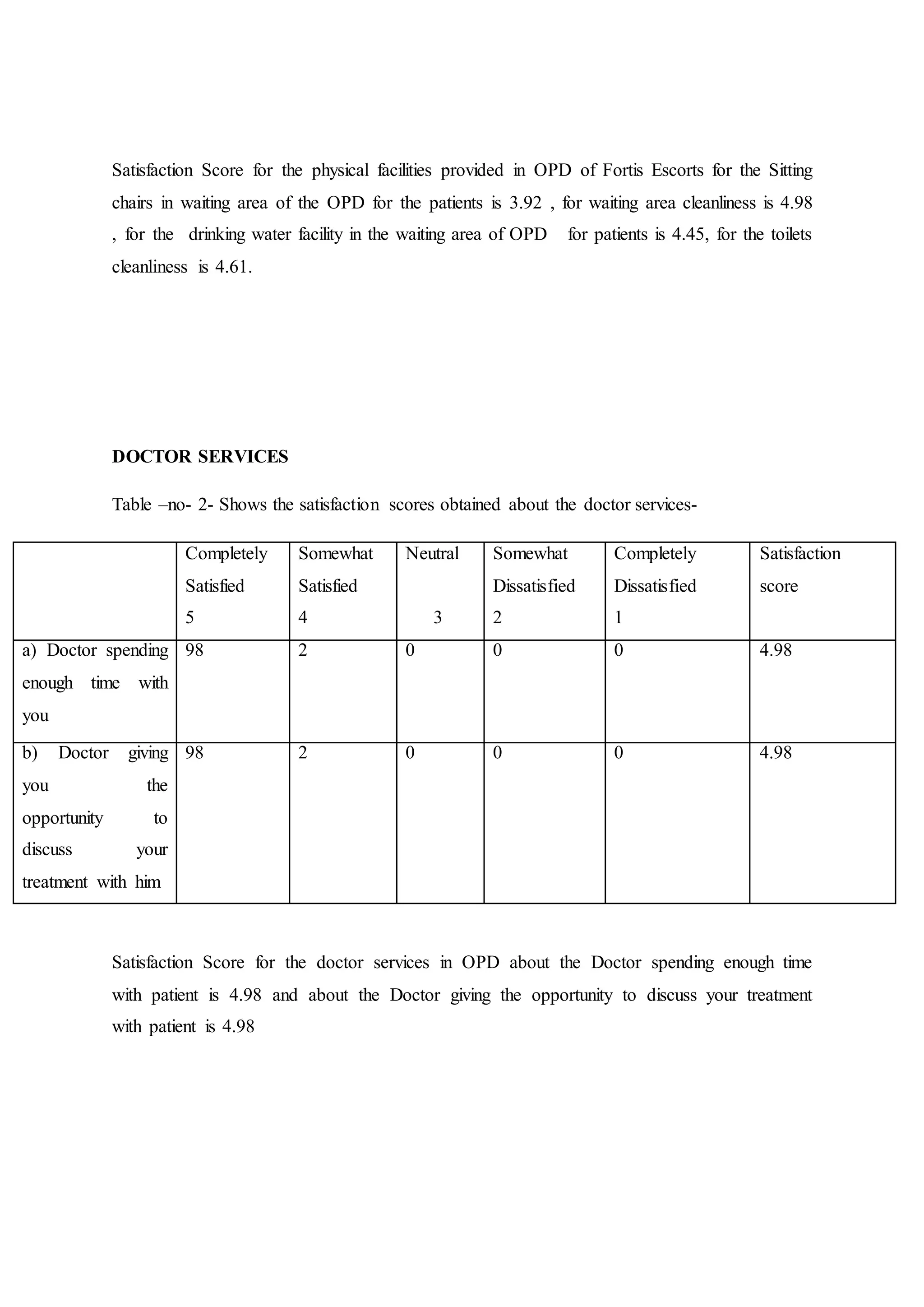
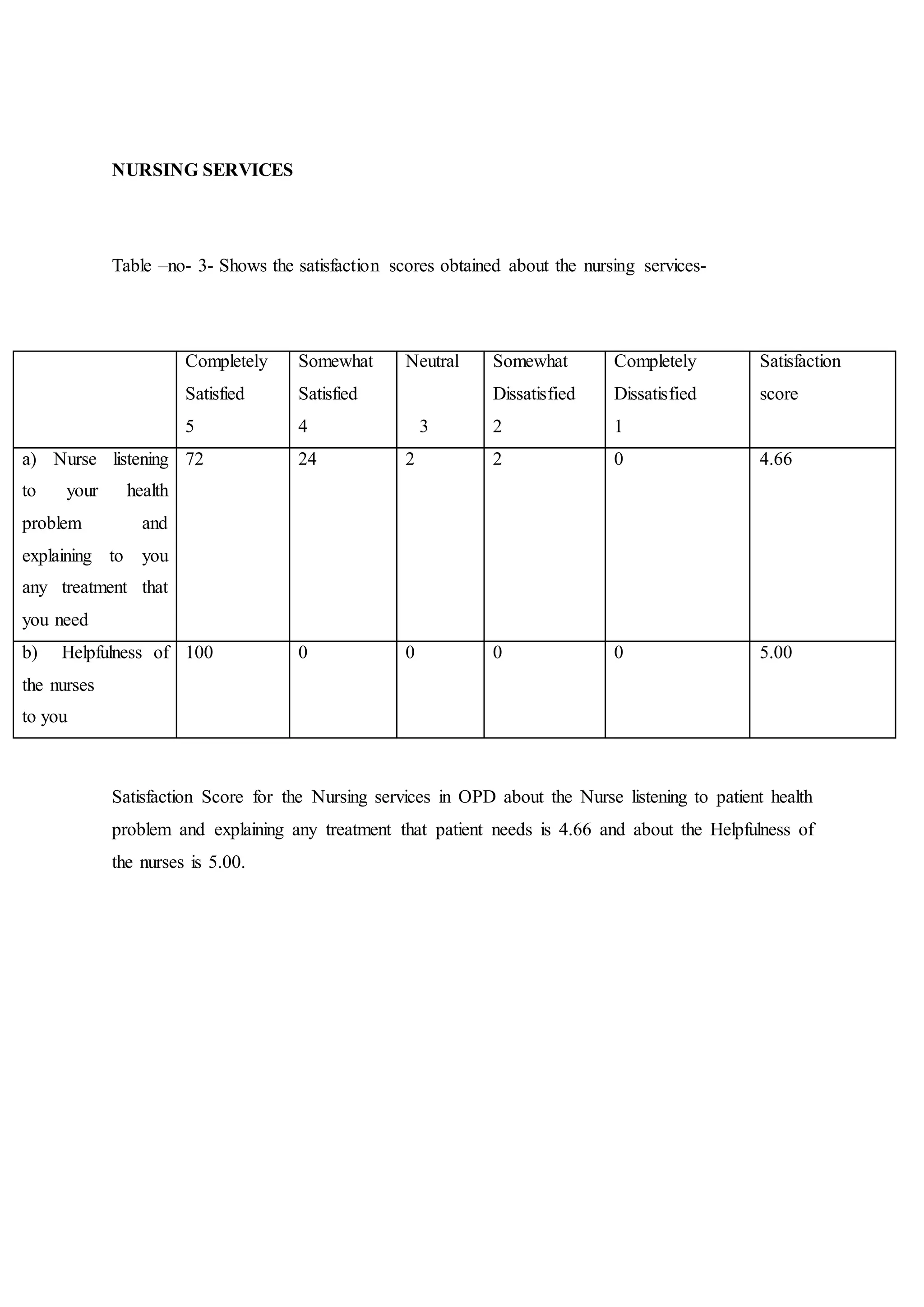
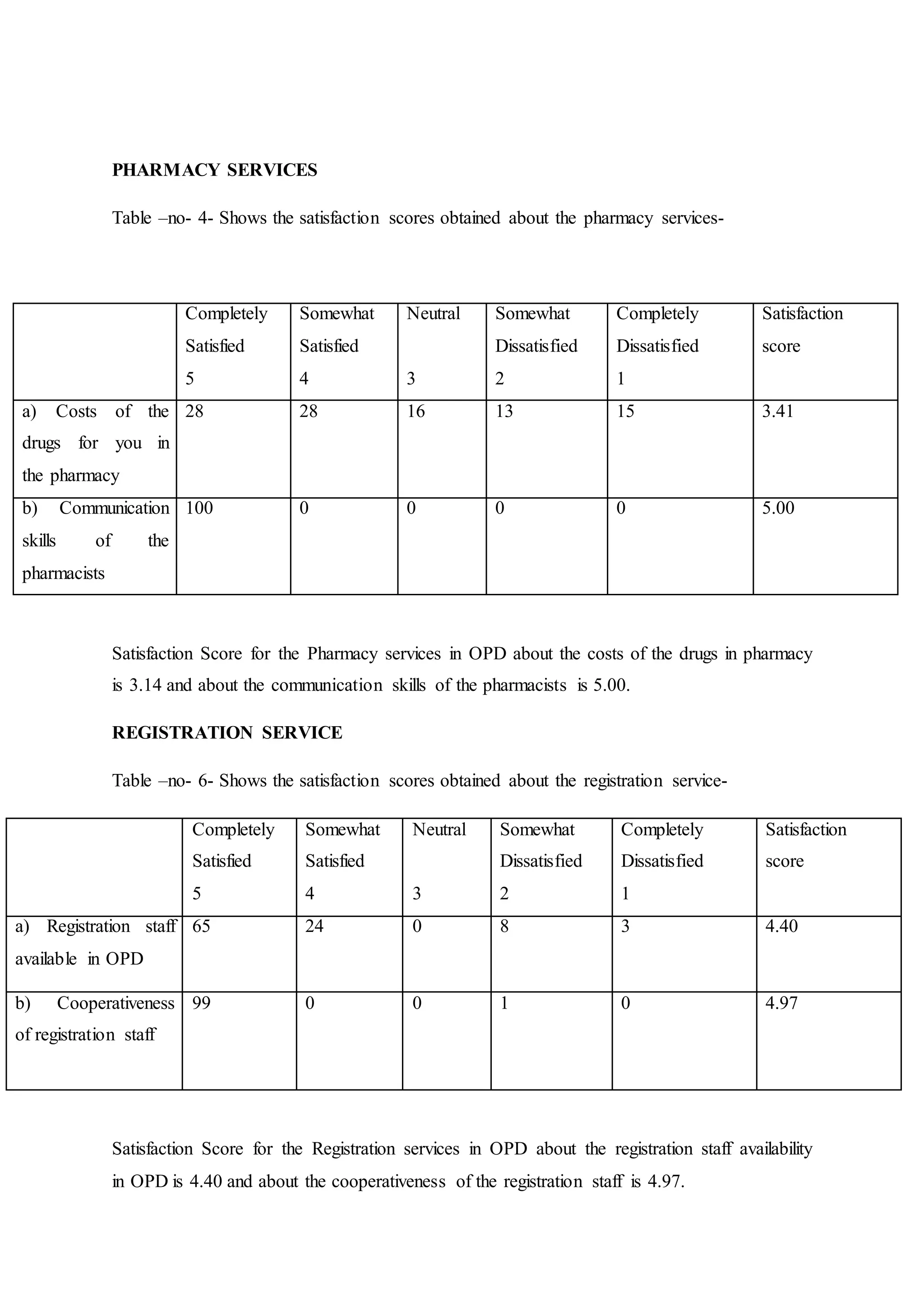
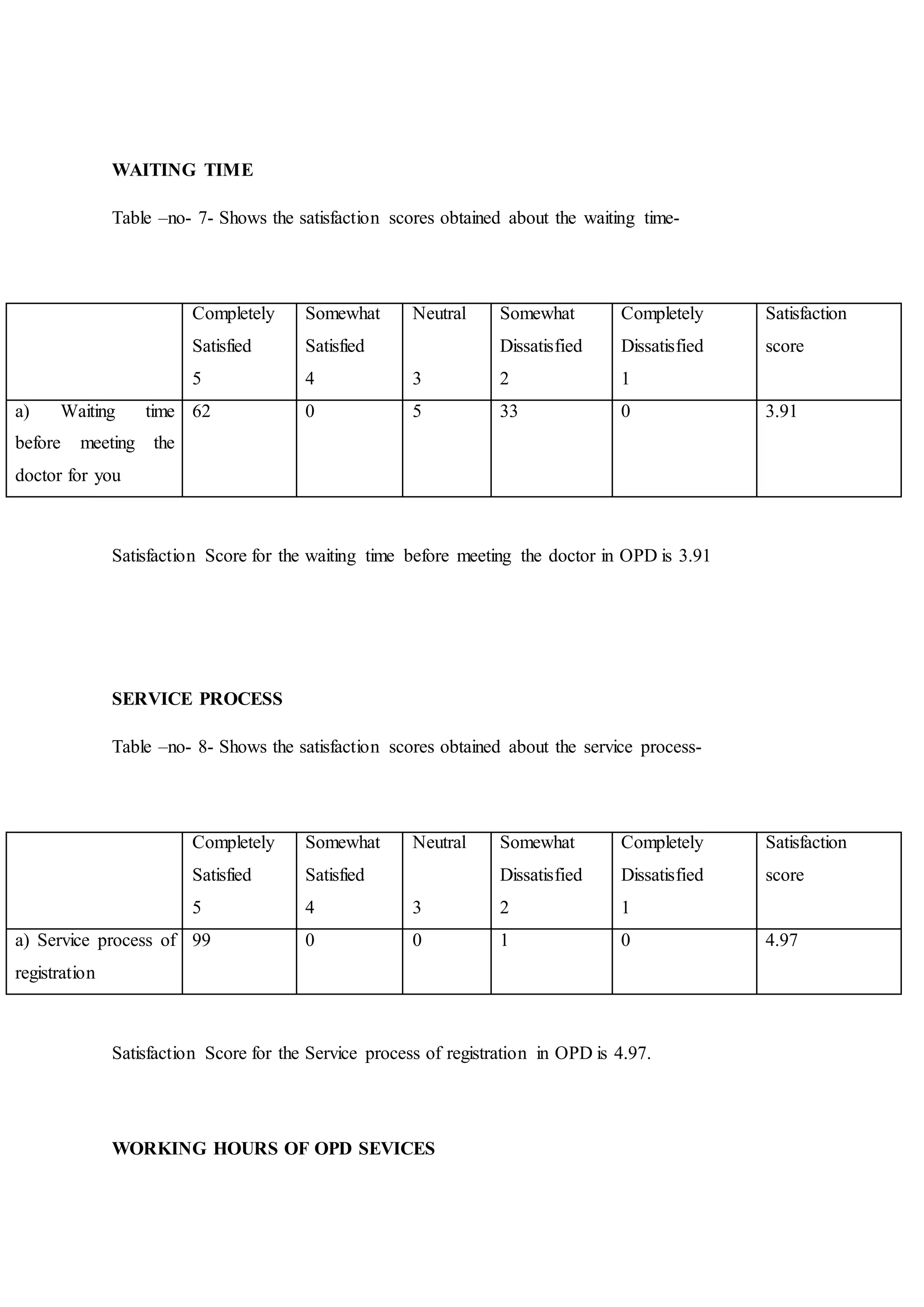
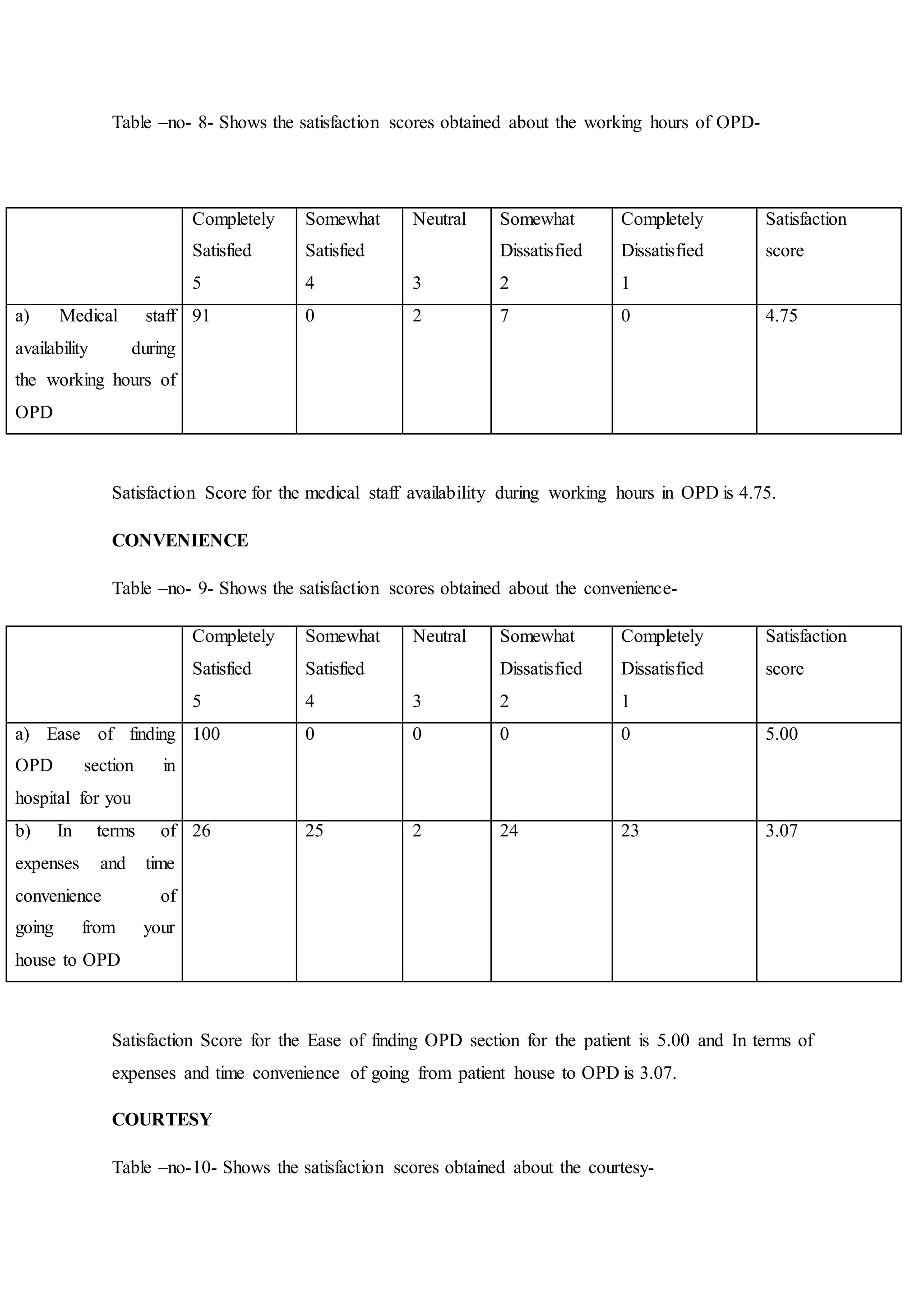

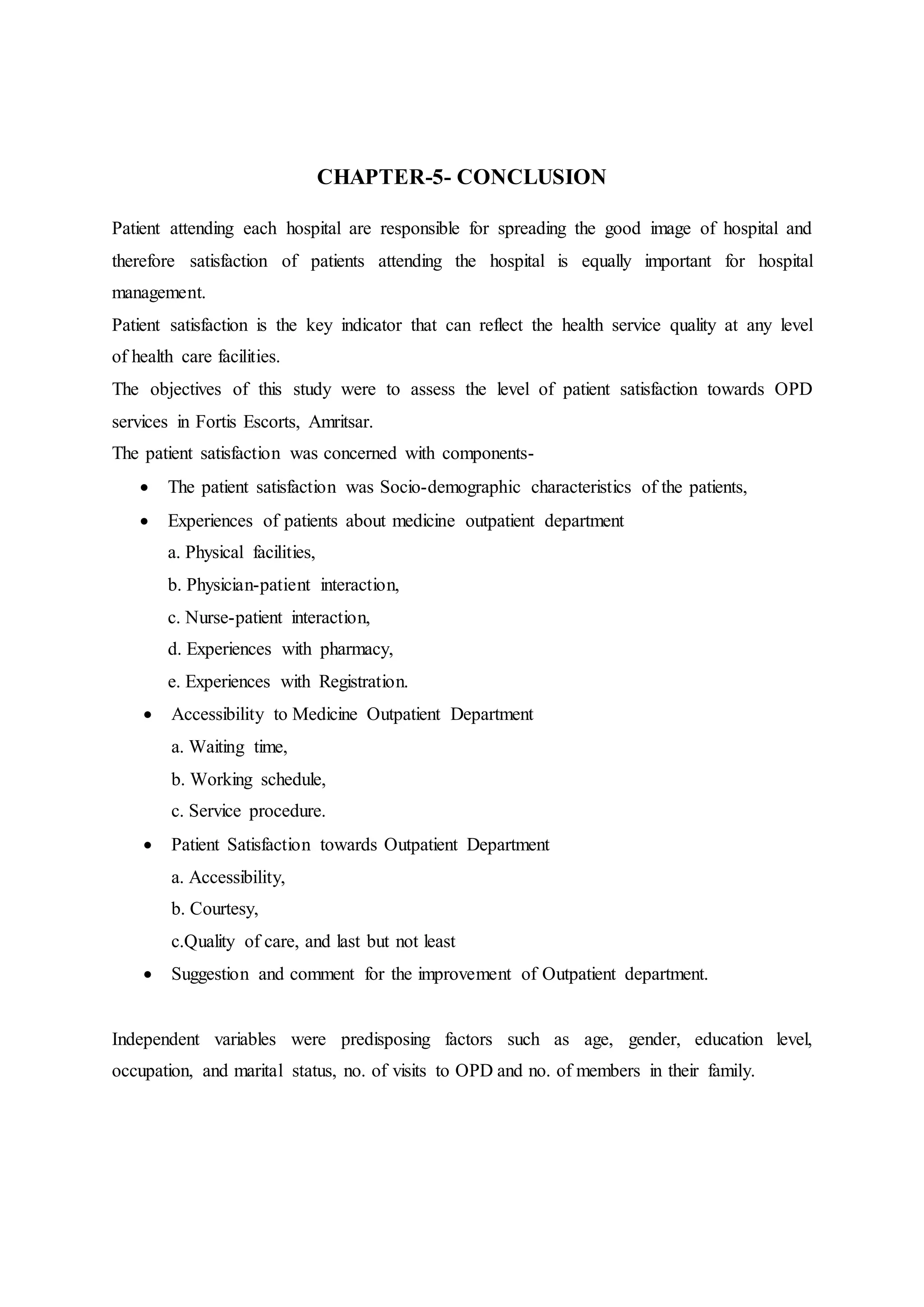
![A structured questionnaire was used as a study instrument for data collection.
The results were presented by using frequency, percentage, minima, maxima, mean, median
and standard deviation.
The result revealed that the age of the patients was in between 15 - 30were (3%), 30-45 were
(12%), 45-60 were (43%) and 60 and above were (42%).The male respondents are about
(66%) and females are (34%). Marital status of the respondents are single (2%), married
(92%), widow/widower (6%) and divorced/separated (0%). The academic or study
qualification of the respondents are Illiterates are( 24%),Finished primary school are
(20%),Finished secondary school are (33)% and Finished Bachelors degree are( 23%).
The natures of job of the respondent Student are (1%), Agriculture are (19%) Government
Employees are (18%), Private Employees are (14 %) and others are (48%).
The total members of the family living in house hold of the respondent 4 or less are (38%),
between 5 and 7 are (50%) and 8 or more are (12%).
Total number of visits to hospital so far (during last 6 months) by the respondent is [≤median
(29%) and > median (71%)].
The result of overall satisfaction level showed that the patients with high satisfaction and low
satisfaction were 70% and 30% respectively.
Regarding the distribution of satisfaction level about the physical facilities, it was found that
patients showed low satisfaction (3.92) regarding the in waiting area Sitting chairs of the
OPD for the patients, regarding the waiting area cleanliness they are highly satisfied (4.98),
regarding the drinking water facility in the waiting area of OPD they showed low satisfaction
(4.45) and regarding the toilets cleanliness are highly satisfied (4.61).
The distribution of satisfaction level about the doctor services in OPD, it was found that
regarding the Doctor spending enough time with patient they are highly satisfied (4.98)and
regarding the Doctor giving the opportunity to discuss the treatment with patient they are
highly satisfied (4.98).](https://image.slidesharecdn.com/finalthesis2-150519132519-lva1-app6892/75/Final-thesis-2-67-2048.jpg)
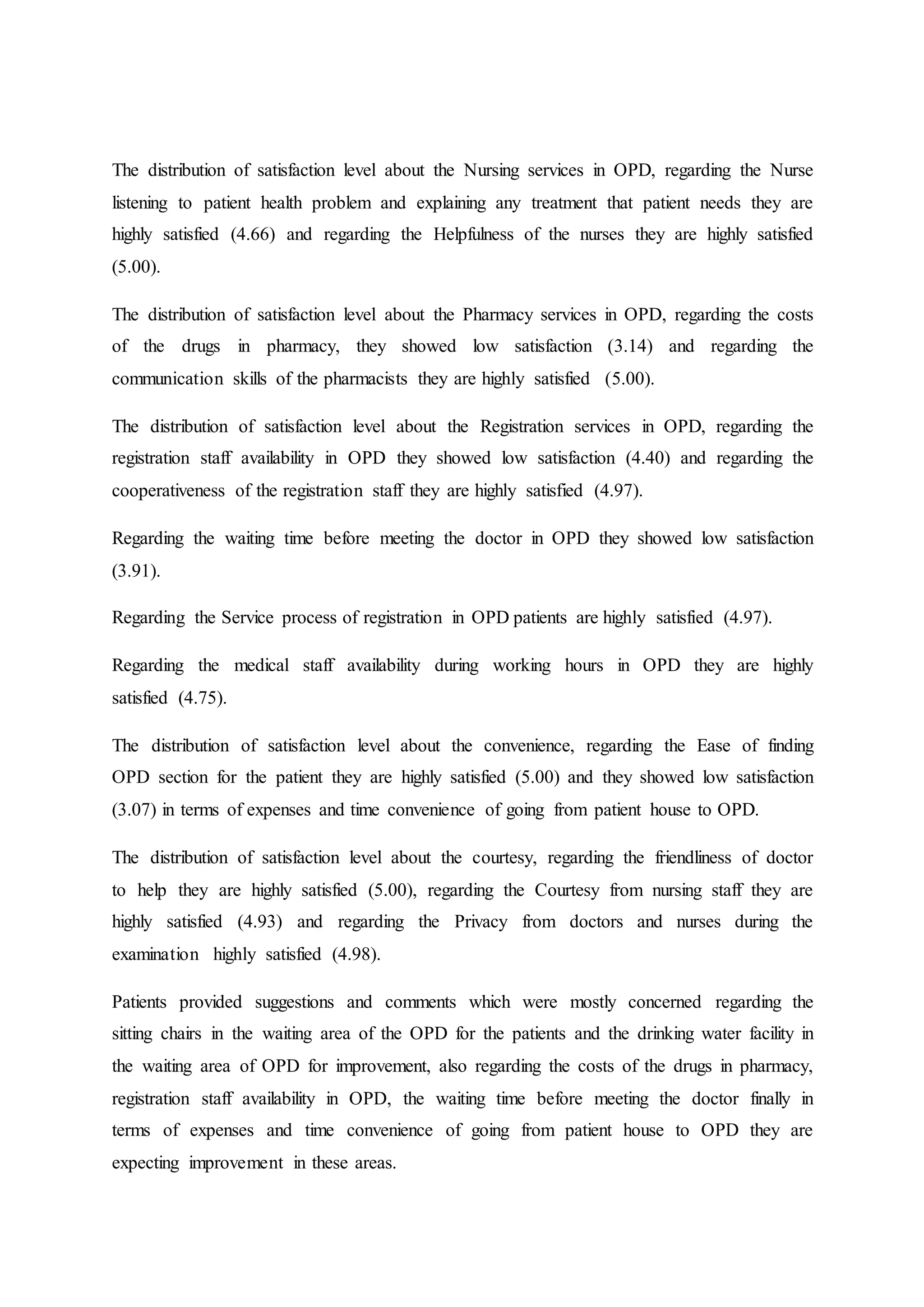
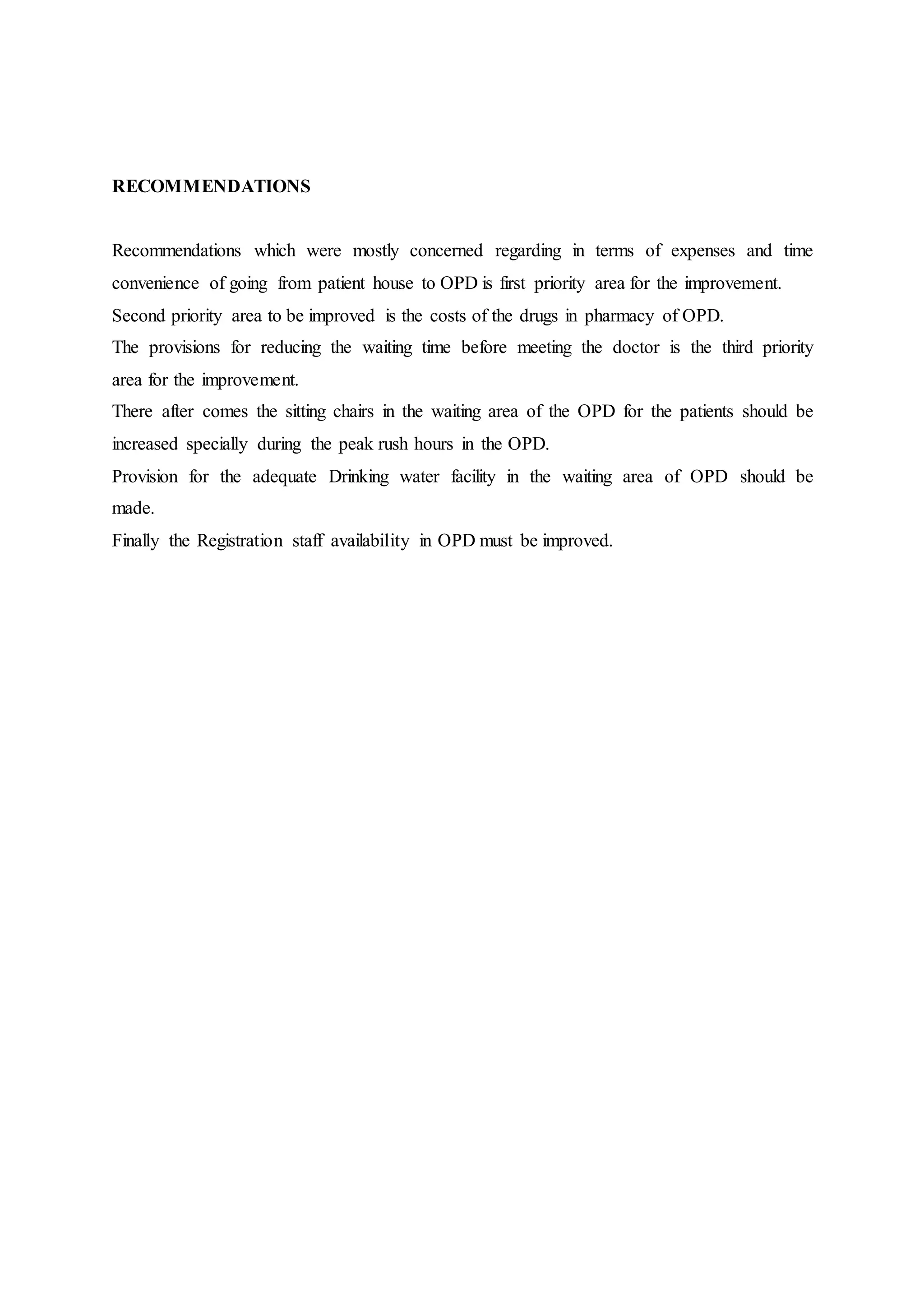
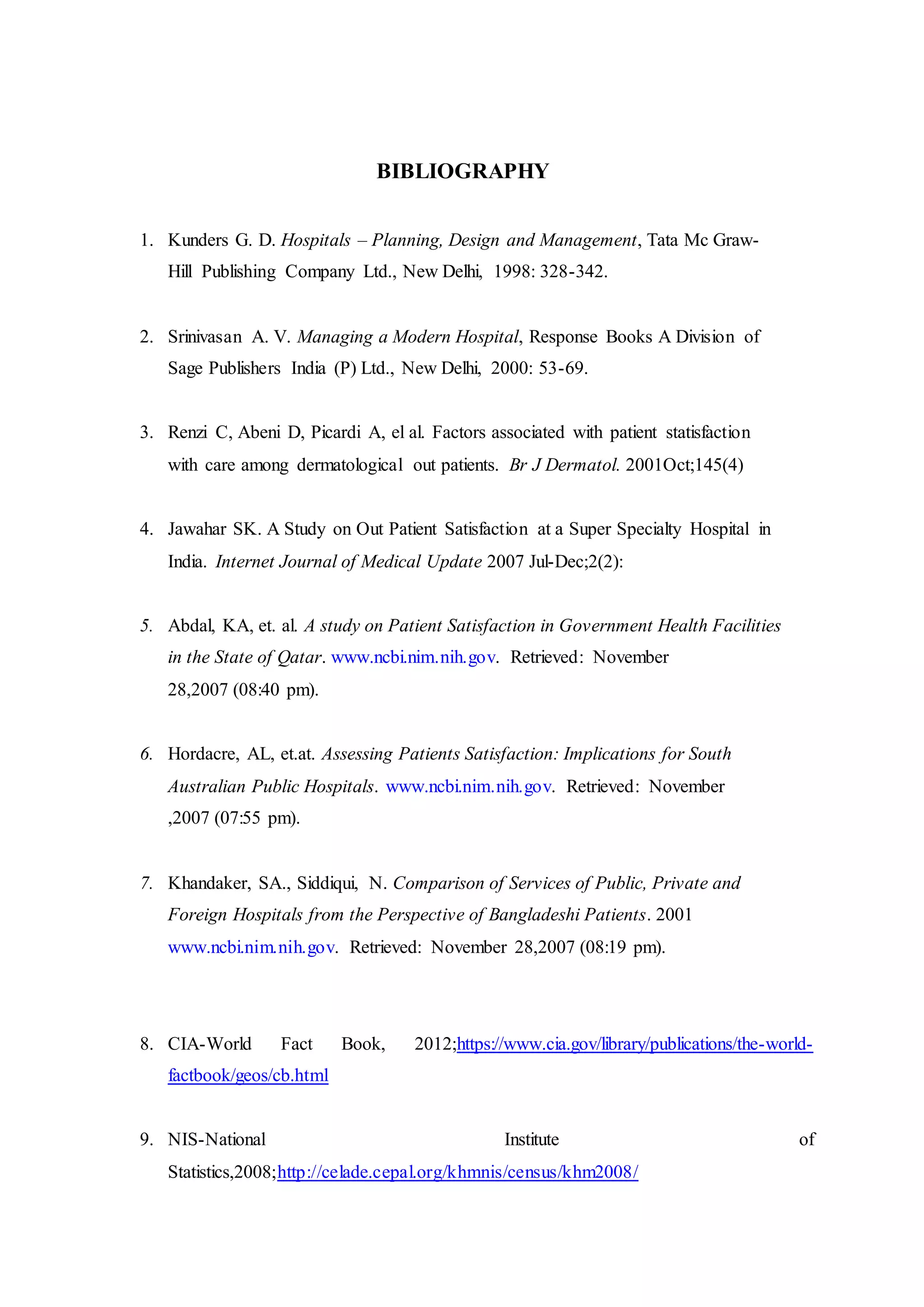
![10. Public health reform in Cambodia: hospitals gain autonomy, 2009;
http://cambodia.ka-set.info/economics/news-health-hospital-autonomypublic-
service-equity-fund-090424.html
11. Khmer-Soviet Friendship Hospital 13th Medico-Surgical Seminar on, 2009.
12. Hospital Activity Report, 2011; Khmer-Soviet Friendship Hospital.
13. Rapport De Garde Du Au Mois, 2012; Khmer-Soviet Friendship Hospital.
14. Swartz TA, Bowen DE, Brown SN, and Stephen in 1993, Advances in
Service Marketing and Management; pp. 65-85.
15. Oliver, R.L. A conceptual model of service quality and service
satisfaction: Compatible goals, different concepts. In: Swartz TA, Bowen
16. DE, Brown SN, and Stephen, Advances in services marketing and
management: Research and practice, Vol. 2, Greenwich, CT: JAI Press,
1993. pp. 65-85.
17. Swan, et al.; Deepening the understanding of hospital patient satisfaction
fulfillment and quality effects. J health care marketing. 1985; 5(3): 7-8.
18. McQuity S,Finn A, Willey JB. Systematically varying consumer satisfaction and its
implications for product choice [online]. Academy of
marketing science Review 2000; (10): [1-18]. Available from:
http://www.amsreview.org/articles/mcquity 10-2000.pdf
19. Doborah L. Consumerism reflexivity and the medical encounter. Soc Sci Med. 1997;
45(3): 373-81.
20. Aday LA, Anderson RM. Equity of accass to medical care: a concept and
empirical overview. Med care 1981; 19(12): 4-27.](https://image.slidesharecdn.com/finalthesis2-150519132519-lva1-app6892/75/Final-thesis-2-71-2048.jpg)
![21. Hall J.A., Dornan M.C. Patient socio-demographic characteristics as
predictor of satisfaction with medical care: meta-analysis. Social science and
medicine. 1990; 30: 811-8.
22. Lebow JL. Similarities and differences between mental health and health
care evaluation studies assessing consumer satisfaction. Eval Plann J 1983; 237-45.
23. Pasaribu SI. Consumer Satisfaction towards health care services of Health
center in Bankok Thailand [M.P.H.M. Thesis in primary Health care
Management]. Nakhon Pathom: Faculty of Graduate Studies, Mahidol
University;1996.
24. Rodney W.Quigly, C.Werblun et al. Satisfaction of community patients in
a family medicine Residency: Validation of measurement tool. Family
Practice Research journal. 1986; 5: 167
25. Setter JF, Thomas V. Perenger. Validating a satisfaction questionnaire
using multiple approaches. Soc Sci Med 1997; 45(6): 879-85.
26. Doborah L. Consumerism reflexivity and the medical encounter. Soc Sci
Med. 1997; 45(3): 373-81.
27. Wiadnyana, IGP. Et.al; Total quality Management experience at primary
health care level, paper at Asean workshop seminar in Indonesia, Jan 23,
1995.
28. Channawanggse K, Chamreng B, Niyoyaht S. Common understanding
rural development management principles, propostions and challenges. 3rd
ed.](https://image.slidesharecdn.com/finalthesis2-150519132519-lva1-app6892/75/Final-thesis-2-72-2048.jpg)
![29. Sumtraprapoot P. Patient satisfaction towards health center services of
BMA health center 24 [M.P.H.M. Thesis in Primary Health Care
Management]. Nakhon Pathom: Faculty of graduate studies, Mahidol
30. Upreti SR. Consumer Satisfaction towards Health centers in Suphanburi
province, Thailand [M.P.H.M. Thesis in Primary Health Care
Management]. Bankok: Faculty of Graduate studies, Mahidol University,
1994.
31. Pawaribu SI. Consumer’s Satisfaction toward Health Care Services of
Health Center in Bankok, Thailand [M.P.H.M. Thesis in Primary Health
Care Management]. Nakhon Pathom: Faculty of Graduate Studies,
Mahidol University; 1996.
32. Robert JS, Coale Redman RR. A history of the joint commission on
accredation of hospitals. JAMA 1987; 258: 936-40
33. Afridi MI. Consumer’s Satisfaction towards health care services providedby health
centers at Salaya Sub-district, Nakhon Pathom Province,
Thailand [M.P.H.M. Thesis in Primary Health care Management]. NakhonPathom:
Faculty of Graduate Studies,Mahidol University; 2002.
34. Likun P. Strategic issues for reducing patient waiting time and improving
satisfaction with services at outpatient department of first affiliated,
Kunming Medical college, P.R.C.A. [M.S. Thesis in Health Development
Program] Bangkok: Faculty of Graduate Studies, Chulalongkorn
University; 1996.
35. Devokata SR. Consumer Satisfaction towards health services provided byhealth
center in Muang district, Loeit province, Thailand [M.P.H.M Thesisin Primary Health
Care Management] Nakhon Pathom: Faculty ofgraduate studies,Mahidol University ;
1997.](https://image.slidesharecdn.com/finalthesis2-150519132519-lva1-app6892/75/Final-thesis-2-73-2048.jpg)
![36. Aday LA, Anderson RM. Exploring dimensions of access to medical care:
Health services research. Pub Med 1983; 18(1): 49-74. Available from:
www.pubmedcentral.nih.gov/articlerender.fcgi?artid=1068709
37. Cockerham, W.C. Medical Sociology. 2nd ed. Englewood Cliffs, N.J.:
Prentice Hall; 1982. p.16-27
38. Ross CK, Stert CA, Sincore JM. The importance of patient preference inthe
measurement of health care satisfaction. Med Care 1993; 31(12):
1145-6.
39. Kunarantnapruek S, Boonpadoong, D. The study of client satisfactiontowards curative
services in general hospital. Bankok: Vachirasan; 1989.
40. Sriratanabul U, Pimpakovit V . Service of outpatient department at
hulalongkorn Med J 1973; 18(1): 55-62.
41. Likun P. Strategic issues for reducing patient waiting time and improving
satisfaction with services at outpatient department of first affiliated,
Kunming Medical college, P.R.C.A. [ M.S. Thesis in Health Development
Program] Bangkok: Faculty of Graduate Studies, Chulalongkorn
University; 1996.
42. Tessler R, Mechanic D, Dimond M. The effects of psychologicall distress
on physician utilization. A prospective study. J Health Soc Behav 1976;
17(4): 353-64.
43. Al-Bashir M,Armstrong D. Preferrence of healthy and ill patients for style
of general practitioner care: implications for work load and financial
incentives under the new contract. Br J Gen Pract 1991; 41:6-8.
44. Williams SJ, Calnan M. Convergence and divergence: assessing criteria ofconsumer
satisfaction across general practice, dental and hospital caresettings. Soc Sci Med
1991; 33(6): 707-16.](https://image.slidesharecdn.com/finalthesis2-150519132519-lva1-app6892/75/Final-thesis-2-74-2048.jpg)
![45. Piyathida Sumtraprapoot. Patient satisfaction towards health center
services of BMA health center 24 [M.P.H.M Thesis in Primary Health
Care Management]. Nakhon Pathom: Faculty of Graduate Studies,
Mahidol University; 1997.
46. Garpenby P. Resource dependency, doctors and the state. Soc Sci Med
1999; 49 (3): 405-24.
47. Barry CA, et al. Giving voice to life world, more humans and more
effective medical care. Soc Sci Med 2001; 51(4): 487-505.
48. Aday LA, Anderson R. Theoretical and methodology issue in sociology
study of satisfaction with medical care. Soc Sci Med, 1978; (12), 28.
49. Aday LA, Anderson R. Exploring dimensions of access to medical care:Healthservice
research. Pub Med 1983; 18(1): 49-
74(www.pubmedcentral.nih.gov/articlerender.fcgi?artid=1068709)
50. Avis M, Bond M, Arthur A. Satisfying solution? A review of some
unresolved issues in measurement of patient satisfaction. J Adv Nursing
1995; 22:316-22
51. Khan AM. Patient Satisfaction towards Medicine Outpatient Departmentservices in
Bunphaeo Autonomous Hospital, Samut Sakhon Province,
Thailand. [M.P.H.M. Thesis in Primary Health Care Management].
Nakhon Pathom: Faculty of Graduate Studies, Mahidol University; 2007.
52. Streiner DL, Norman GR, 1989 Health Measurement Scales A Practical
Guide to Their Development and Use.; New York: Oxford University
Press, Inc. pp. 64-65.](https://image.slidesharecdn.com/finalthesis2-150519132519-lva1-app6892/75/Final-thesis-2-75-2048.jpg)
![53. Performance Review, Khmer-Soviet Friendship Hospital, 2010-2011.
54. Ashma Ibrahim. Patient Satisfaction with Health Services at the Outpatient
Department of Indira Gandhi Memorial Hospital, Male’ Maldives.
[M.P.H.M. Thesis in Primary Health Care Management]. Nakhon Pathom:
Faculty of Graduate Studies, Mahidol University; 2008.
55. Anjum Javed. Patient Satisfaction towards Outpatient Department
Services in Pakistan Institute of Medical Science, Islamabad. [M.P.H.M.
Thesis in Primary Health Care Management]. Nakhon Pathom: Faculty of
Graduate Studies, Mahidol University; 2005.
56. Tangmankongworakoon T. Client satisfaction towards the services of Lad Yao
Hospital [M.P.H.M.Thesis in Primary Health Care Management]. Nakhon Pathom:
Faculty of Graduate Studies,
Mahidol University; 2006.
57. Wangnumyen Community Hospital. Patient satisfaction survey. Unpublished report.
April 2005.
58. Wangnumyen Community Hospital. Patient satisfaction survey. Unpublished report.
April 2006.
59. Partha Pratim Roy. Client satisfaction on outpatient medical care service Sampran
community hospital, Thailand [M.P.H.M. Thesis in Primary Health Care
Management]. Nakhon Pathom:Faculty of Graduate Studies, Mahidol University;
2002.
60. Fuller,T.D; J.A. Edward, S. Sermsri and S. Vorakitphokatom 1993 “Gender and
health: Some Asian evidence” The Journal of Health and Social Behavior, Vol. 34: 3;
252-271](https://image.slidesharecdn.com/finalthesis2-150519132519-lva1-app6892/75/Final-thesis-2-76-2048.jpg)
